

30 Best SEO Case Studies: Real Examples & Results That Work
How would you like to read the best SEO case studies ever published?
More importantly, how would you like to copy the best practices in search engine optimization that are based on real-world examples and not just theory?
Below, you’ll find a list of the top 30 SEO case study examples along with the results and key findings. By studying these SEO case studies and applying the lessons learned on your own site, you can hopefully achieve similar results for your SEO campaigns.
Table of Contents
Best SEO Case Studies
How i increased my organic traffic 652% in 7 days – backlinko seo case study.
Learn how Brian Dean used the “Skyscraper Technique 2.0” to increase his organic SEO traffic to one of his web pages by 652%. This same approach helped a brand new post hit the #1 spot in Google within a few weeks. The case study is full of screenshots, key findings, and guided steps for you to follow.
SEO Investment – Google Search Central Case Study
Find out how an investment in SEO and implementing applicable structured data can improve user experience and increase organic traffic on Google Search.
How to Create a Squeeze Page That Converts at 74.5% – Gotch SEO Case Study
See how Nathan Gotch used 9-step approach to create a squeeze page that converts at 74.5%. The tactics revealed in this case study also boosted another one of the pages by 69%, so you know it’s a proven method that works.
From 126 to 121,883 Unique Visitors in Under 6 Months – Ahrefs SEO Case Study
This SEO case study example focuses on Northmill, a Fintech company founded in Stockholm. It reveals how you can analyze your business competitors to develop higher-quality content that will gain a huge amount of traffic and convert those readers into customers. Read it to find out exactly what Northmill did during an SEO campaign to go from 126 unique visitors to 121,883 in under 6 months.
Ranking in 24 Hours in the Competitive SEO Niche – SEO Chatter Case Study
This case study was a partnership between SEO Chatter and Keyword Chef. It shows you how much organic traffic and money was earned by publishing 45 blog posts based on keywords found with the Keyword Chef tool. You’ll also discover the steps taken to get those posts to rank in the top 10 positions on Google within 24 hours or less after publishing.
From 0 to 75,000 Visits A Year – Ryan Darani Case Study
Find out complete details on the challenges, limits, budgets, and timeframes for a client that went from 0 clicks per day to now 300-400 on average with only 60 pieces of content on the site.
How We 4x’d Traffic and Doubled Revenue in E-Commerce – Diggity Marketing SEO Case Study
This is one of the best SEO case studies for e-commerce. Inside, you’ll learn how an e-commerce client grew their traffic by 417% in 8 months. You’ll get the exact SEO strategies deployed, content improvements, and backlink tactics. The results speak for themselves: an extra $48,000 in additional monthly revenue was achieved for a total of 112% increase in overall revenue.
Diggity Marketing is also featured on my SEO secrets page and is a good resource for more SEO success case studies.
6-Step Process That Generated 150,732 Visits – Robbie Richards SEO Case Study
In this SEO case study, you’ll learn a repeatable 6-step process that one SEO marketer used to get his client to #1 in Google. This strategy helped him outrank big name brands like Mashable, and increase organic traffic by 11,065% in just 6 months.
Scaling an Outdoor Niche Site to a $175K Exit – The Website Flip SEO Case Study
Get a complete month-by-month breakdown of how one business bought a website on Flippa and scaled it for a $175,000 exit. You’ll learn every step they took with SEO and site improvements from day one of the purchase at $23,000 and the sale 22 months later, all while making $100,938 revenue on top of the final sales price.
How Long Does It Take to Rank for A Keyword – Bloggers Passion SEO Case Study
Find out how long it really takes for a keyword to hit the first page of Google in this case study. SEO for a new post can take some time to kick in before the page generates thousands of visitors from search. But how long do you have to wait? Is it one week, 30 days, or longer? Read this data-packed example to find out as well as get actionable steps you can take to speed up the ranking process.
Traffic Improves SEO and Affects Google Rankings – Cognitive SEO Case Study
This company tracked a strong correlation between a spike in traffic from a Reddit post to an increase in Google rankings for an ultra-competitive keyword. Find out how they experienced a boost from the 74th position to the 8th in Google search results in just one day.
$780 Revenue In Month 1 with An Aged Domain – Stream SEO Case Study
This is an ongoing case study of a website built on an aged domain. In this first post, you’ll learn how the aged domain was resurrected and what SEO steps were taken in the first month to generate $780.
Large Images In Google Search – Google Search Central Case Study
Learn how having large images in Discover on Google can improve click-through rates and increase visits to publisher websites.
How I Increased SEO Traffic by 600% in 24 Months – WordStream SEO Case Study
The author of this case study took a site from 20,000 monthly visitors to over 150,000 (a 600% increase) with mostly on-page SEO updates and internal linking methods. He even unpublished 90% of the content on the blog. Learn the four SEO techniques that he used in the right way to explode the search traffic.
A Case Study of Winning in Local SEO – SEMrush Blog SEO Case Study
This case study talks about how to improve local SEO for a business. It uses the example of a local taxi company in a competitive market. Local SEO can be tough to crack because you’re dealing with two sets of algorithms: organic search results and maps; and maps can be fairly tricky to get ranked in. Find out what courses of action the author took to get this taxi business to appear within the local map pack for almost all main search queries within the city itself.
How To 4x Organic Traffic In 6-Months Using Pure SEO Basics – Authority Builders SEO Case Study
This is an interesting case study on SEO because the site that was studied had increased organically from 7,000 visitors per month to about 68,000 between January to April. The site owner was doing a lot of things right but many simple things were also being done wrong. Find out here how you don’t need fancy SEO tricks to get high rankings and traffic to your blog or website. Once the author performed a technical SEO audit and put into place some off-page optimization strategies like link velocity, anchor text ratios, and relevance, the site’s traffic quadrupled in the next 6 months.
How to Rank in the First 2 Results on Google – Leanne Wong SEO Case Study
In this case study, you’ll learn five essential steps to optimize your blog posts to rank in the first #2 results on Google. The author used these same methods to rank above 1 million competing pages. She talks about using medium tail keywords, Google’s predictive search queries, strategic keyword placement, and more.
How To 14x Search Traffic In 8 Months – Matthew Woodward SEO Case Study
Matthew Woodward is an expert in search engine optimization and he publishes a lot of SEO case study examples. This one in particular is worth the read because it shows you how SEO doesn’t have to be complicated to get exponential results. Inside, you’ll learn how to create a strong plan of action based on 7 steps. Using these same strategies in this case study, the author We increased traffic on an affiliate website from 2,732 visitors per month to 38,420 in just 8 months (14x higher or 1,306% to be exact).
Data-Informed Strategy Delivers Results – Rise Interactive SEO Case Study
This is an SEO case study for the American Egg Board (AEB), a U.S. The AEB is best known for its long-running slogan, “The Incredible, Edible Egg”, and the Just Mayo scandal. The AEB relies heavily on organic traffic to drive awareness; however, it was experiencing a steady decline in traffic and organic visibility, year-over-year. Learn how the Rise Interactive agency used an integrated site-wide keyword strategy, an SEO-first approach on the site structure, and ways to capitalize existing SEO equity to generate an 87% increase in mobile traffic and 22% improvement in desktop traffic.
How an Integrated, Keyword-Driven Blog Strategy Increased Organic Traffic to a Leading Analytical Laboratory’s Blog by 58% – TopRank Marketing SEO Case Study
This is one of the shortest and best SEO case studies you’ll ever find. You can read through it in under 3 minutes. But don’t let the length fool you; the data and actionable takeaways are priceless. Discover how Innovatech Labs, a leading analytical laboratory in Minnesota, used an integrated keyword-driven blog strategy that consisted of a five-step targeted plan to generate an increase of 58% traffic to the blog. As an indirect improvement, the site also received a 33% growth in newsroom traffic to qualified product pages and 19% increase in overall pageviews.
Organic Visitors Increased by 87%, Located in Target Local Cities – Wastecycle SEO Case Study
The client behind this case study is Wastecycle, a sustainable waste management company that provides a recycling and waste management service. Wastecyle wanted to get more business by reaching customers looking for local skip hire and Hallam digital marketing agency provided local SEO strategies to achieve this goal. Read the SEO case study to find out how the agency generated an 87% increase in organic visitors in local cities, 150% increase in clicks for the targeted term “skip hire”, and 297 varied phrases achieving page one rankings on Google.
How We Ranked on the First Page of Google for 4 Competitive Keywords in Just 8 Months – OutreachMama SEO Case Study
This case study is a few years old but everything in it still highly relevant for today. Find out how a link building company used a 3-step strategy to rank on the first page of Google for four target keywords and in the top 3 results for two of those keywords. The case study explains the way the company built links, what pages were targeted, the anchor text used, and the timelines for each phase.
Design Modo Penalty Removal Boosts Organic Traffic by 61.79% – Reposition SEO Case Study
This is a good SEO success case study to read because it focuses on Google penalty removals. You can skim through in less than one minute too. Design Modo, a resource for digital designers and developers, had an apparent partial penalty that had gradually decreased its organic traffic month on month. Reposition SEO agency got involved and found out that the root of the penalty was due to Design Modo’s outbound links rather than the usual inbound links. After a few tweaks and a reconsideration request to Google, the organic traffic increased 61.79% along with an 86% improvement in all keyword rankings.
An Increased In Total Organic Users By 555% – Victorious SEO Case Study
This case study follows the journey of Oji Vape, a wholesale vaping supplied company, that initially got burned by an agency that used outdated SEO tactics that no longer applied to Google’s constantly evolving algorithms. After switching to Victorious SEO agency, Oji Vape experienced a 555% increase in organic visitors within 8 months. This has translated to a 745% improvement in goal completions that took into account sales inquiries by phone and online form submissions. Find out what Victorious did to achieve these amazing results.
Content Strategy for a B2B Furniture Supplier – Web Talent Marketing SEO Case Study
This case study goes beyond SEO tactics and enters the realm of conducting a good content strategy. The B2B furniture supplier client had invested in search engine optimization for a few years with a primary focus on link building. But the newly hired agency felt like the furniture company needed to diversify its SEO strategy in order to remain competitive in the organic search results and acquire new customers that were not familiar with the brand. After a bit of work, the agency achieved these results: 34,878 organic entrances to blog posts (48% of all organic traffic), increased conversions from blog entrances by 70%, 74 keywords on page one of Google search results, and 13 featured snippet results.
313% More Organic Traffic with REAL Examples – From the Future SEO Case Study
This case study examines the SEO results from 3 different websites, in 3 totally different niches, that all have different conversion metrics for “success.” Learn what steps were taken to run an SEO campaign for each website to meet the key goals for success.
How We Got a 32% Organic Traffic Boost from 4 On-Page SEO Changes – Moz SEO Case Study
In this case study, you’ll learn about Wall Street Oasis, an online community focused on careers in finance with over 2 million visits per month. Inside, you’ll discover two of the site’s main SEO problems as a large forum with over 200,000 URLs and the simple solutions that helped it regain its growth trajectory.
A 48% Boost in Year-On-Year Organic Traffic – Brand New Copy SEO Case Study
This case study focuses on Field & Lawn, a marquee hire company that operates throughout the UK. As a result of the hired agency’s efforts, Field & Lawn saw a 48% increase in Year-on-Year traffic, a 5% reduction in bounce rate, and a significant ranking improvement for almost all 42 targeted keywords. Find out what methods were used to gain these increases in visibility and how you can copy them for your own success.
How I Ranked 1800+ Keywords on Page 1 of Google in Just 6 Months – Shane Barker SEO Case Study
In this SEO case study, you’ll discover exactly how Shane Barker ranked 1800+ keywords on the first page of Google search results. He outlines a 6-step strategy that any business can use to achieve similar metrics. What’s also nice about this case study is that the author has a lengthy FAQ section at the end where he answers common questions people have about the methods used for growth with search engine optimization.
7 Steps To 197,514 Monthly Traffic – Apollo Digital SEO Case Study
In this SEO case study, you’ll discover the step-by-step formula of the entire search engine optimization process that Apollo Digital uses to rank its clients’ websites. This study in particle focuses on a SaaS business process management software and how it went from around 8,000 monthly visitors to about 200,000 in less than 2 years. You’ll get everything explained in detail like the content writing process, interlinking strategies, visual improvements, headline tweaking, and of course, SEO tactics.
Read More Case Study Examples
I also have more digital marketing case studies with real results from other industry experts that you can study and use to improve your online marketing campaigns:
- Affiliate marketing case studies
- Content marketing case studies
- Digital marketing case studies
- Email marketing case studies
- PPC case studies
- Social media case studies
What Is an SEO Case Study?
An SEO case study is an in-depth study of search engine optimization in a real-world context. It can focus on one SEO tactic or a group of SEO strategies to find out what works in search engine optimization to improve traffic and organic visibility.
Are Case Studies Good for SEO?
Case studies are good for SEO because you can learn about how to do search engine optimization in an effective way. Instead of just studying the theory of SEO, you can learn from real examples that applied SEO methods to achieve success.
In addition to learning from case studies, you can also get valuable insights from my SEO books list that contains expert search engine optimization training.
Summary for the Best SEO Case Studies
I hope you enjoyed this list of the best SEO case studies that are based on real-world results and not just theory.
As you discovered, the SEO case study examples above demonstrated many different ways to perform well in search engines. By studying the key findings from these examples, and applying the methods learned to your own site, you can hopefully achieve the same positive outcome. New SEO success case studies are being published every month and I’ll continue to update this list as they become available. So keep checking back to read the current sources of information on search engine optimization.
Outreach Monks
- Country Specific
- Case Studies
Ready to supercharge your link building strategy? Welcome to our latest blog post: “5 Incredible Link Building Case Studies by Outreach Monks – A Must-Read!”
Wondering how to improve your link building? This post is just for you. We’re sharing five real stories of success from the online world. These aren’t just tales – they’re lessons to help you master link building .
Why read this? Each story is a treasure of practical tips and smart tactics you can use. From beginners to pros, everyone will find something useful here.
So, are you ready to learn from these SEO success stories and boost your link building skills? Let’s jump right in!
Case Study #1: E-commerce Brand Achieves Remarkable Growth
Brand: REPRESENT CLO
Website: https://uk.representclo.com/

Client Background
Represent Clothing, established in 2012 by brothers George and Michael Heaton, is a pioneering urban fashion brand from Manchester, England. Known for its fusion of high-end design and street culture, Represent offers quality denim, leather jackets, tees, and accessories. Committed to sustainability and inclusivity, Represent empowers individuals worldwide to express their unique style with confidence
- When we started this link building campaign, many big brands already dominated the streetwear industry, making it hard for newcomers like Represent to gain recognition.
- Represent’s SEO team lacked knowledge on how to enhance the website’s popularity off-site, and excessive spending on ads was negatively impacting Represent’s finances.
- Additionally, other brands had numerous high-quality links directing traffic to their websites, posing a significant challenge for Represent to compete.
- Therefore, Represent urgently required a strategic plan to garner more online attention and improve its competitiveness in the streetwear realm.
Link Building Campaign and Strategy
After implementing the campaign for a duration of eleven months, we noticed a remarkable upsurge in website traffic. The figures have experienced a substantial boost, rising from 70k to 202k , demonstrating a significant improvement.

- Organic Traffic: From 70k to 202k SEO traffic visitors in less than 11 months , representing a remarkable 188% growth.
- Keywords: The organic keyword count increased from 3.5k to 14.2k , reflecting a growth of approximately 305% . A total of 199 keywords are currently ranking within the top 3 pages on the SERP (Search Engine Result Pages).
- Traffic Value: Estimated traffic cost of $22.9K
- Rankings: Improved rankings for highly competitive keywords like “varsity jacket,” “graphic tees,” “oversized t-shirt,” “oversized tees,” and many others
- The client aimed to reach the UK audience, thus our focus was on generating 100% UK traffic.
Increase in Domain Rating (DR)

Case Study #2: “Insane 10x growth in organic traffic achieved in 6 months for highly competitive keywords!”
Brand Name: Outreach Monks
Website: https://outreachmonks.com/

We’re thrilled to share our latest case study with you, featuring our very own website, Outreachmonks.com! In this study, we’ll reveal our exciting journey toward achieving an incredible 10x growth in organic traffic within just 6 months. Curious about how we did it? We’ll dive into the details of our successful strategy, which involved using SaaS backlinks to boost our website’s performance. Get ready to be inspired!
- Highly competitive keywords related to SEO & backlinks with SEMrush keyword difficulty ranging from 70% to 90%
- Need to create an outstanding strategy to rank these keywords
Link Building Strategy
- Build high DR Saas or technology backlinks from DR 70 to 90 websites via content marketing outreach
- Create high-quality content for these websites
- 10x increase in traffic within 6 months
- Earned Backlinks from High DR websites like HubSpot, Bigcommerce, Evanto, Namecheap & SEMrush
- Improved domain rating ( DR) from 50 to 70, indicating higher authority
- Improved traffic on the blog section, resulting in targeted leads
- Increased brand recognition as SEO articles began ranking
- Monthly traffic value increased from $4k to $22k
- Some blog articles ranking on the 1st page for competitive keywords without backlinks
Top Referring Domains
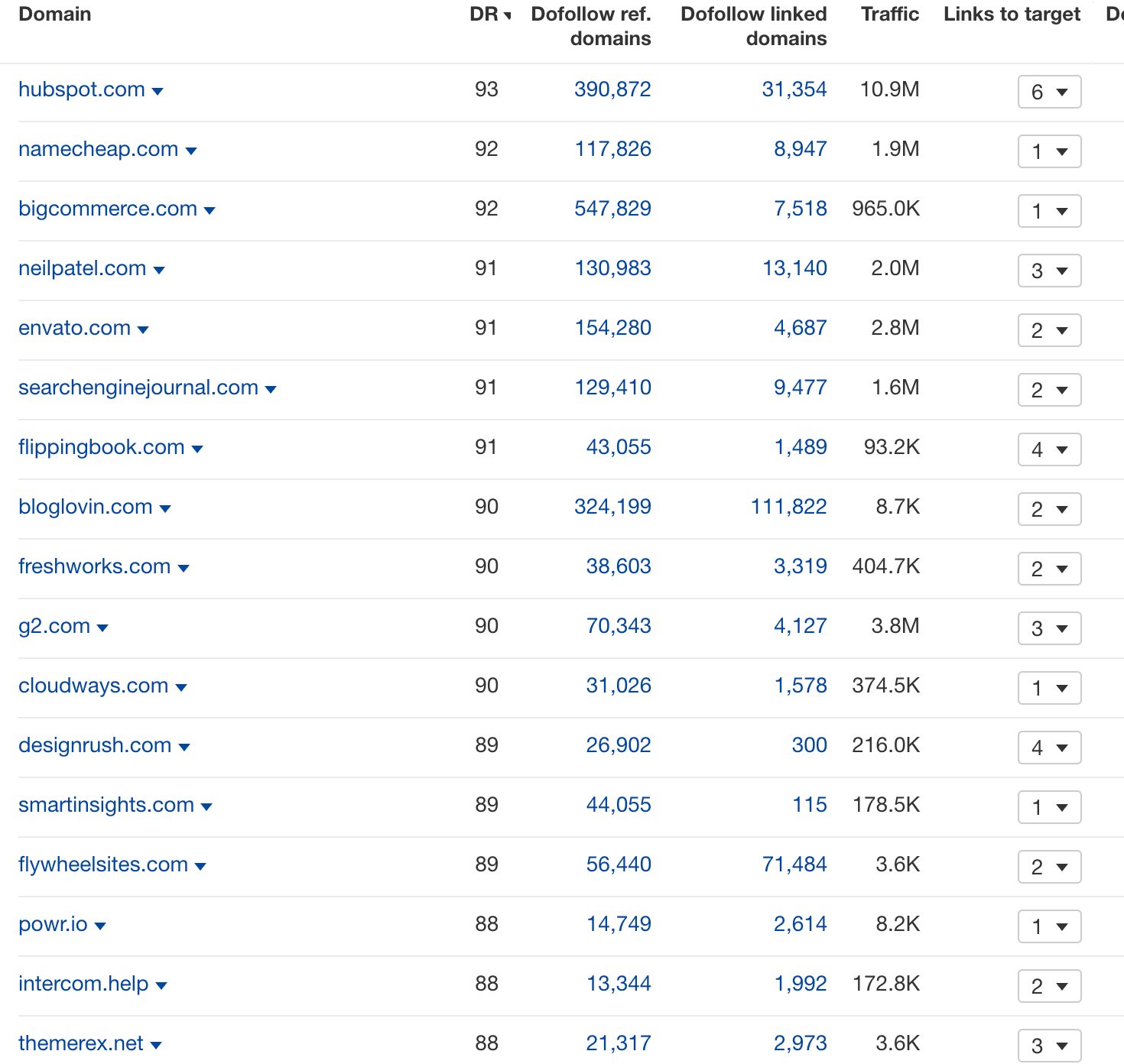
Increase in Organic Traffic

Top Keywords

Overall, Outreachmonks.com’s content marketing outreach strategy was successful in helping the company to rank for highly competitive keywords related to SEO & backlinks. The strategy resulted in significant traffic growth, increased domain authority , and improved brand recognition.

Case Study #3: 10x Organic Growth For A Cannabis Brand
Brand Name: 420DC
Website: https://420dc.com/

420dc.com, a Washington, D.C. based online marketplace for CBD and cannabis products, sought to outshine their competitors in a cutthroat industry. To achieve this, they joined forces with Outreach Monks, a reputed link building agency with a niche expertise in cannabis and CBD SEO. The results were extraordinary and transformed their online presence.
Location: Washington, D.C, USA
Skyrocketing Organic Traffic
Outreach Monks’ strategic implementation of cannabis SEO led to a staggering 1,035% increase in organic traffic, soaring from 4,792 to 55,723.

Domain Rating (DR) Boost
The website’s authority and credibility were significantly bolstered, with their Domain Rating escalating from 21 to 51.

Organic Keywords Expansion
The effective link-building strategy by Outreach Monks resulted in the impressive growth of organic keywords from 1,937 to 35,047, enhancing the website’s search engine visibility.

Improved Keyword Rankings
The campaign dramatically improved rankings on high-value keywords, including:
- dc weed delivery
- dc cannabis delivery
- White truffle strain
- Purple weed strain
- weed online DC
Targeted Backlink Building
Outreach Monks secured valuable backlinks from reputable sources within the cannabis industry, solidifying the website’s authority and trustworthiness.
Case Study #4: Improved 10x Leads and Traffic in 2-3 Months
Brand Name: BlueMagic Group
Website: https://www.bluemagiclinic.com/

BlueMagic Group is a renowned hair transplant clinic located in Istanbul, Turkey. They have earned a stellar reputation for providing top-notch hair transplant services to patients from all around the globe.
However, despite their expertise in the field, they faced challenges in improving their online presence and generating organic traffic. That’s when they turned to Outreach Monks for an effective link building campaign .
- Improve ranking on money keywords related to hair transplant Turkey such as “turkey hair transplant cost,” “turkey hair transplant clinic,” and “how much hair transplant cost in turkey.”
- Generate targeted organic traffic and leads.
- Reduce dependency on Google Ads and social media ads.
1. Ranking on Competitive Keywords
Within just 2-3 months of implementing Outreach Monks’ link building campaign , BlueMagic Group began ranking on competitive keywords related to hair transplant Turkey. This swift improvement showcased the effectiveness of their campaign.

2. Target Organic Traffic Boost
Outreach Monks’ strategy led to a phenomenal 7x increase in targeted organic traffic, jumping from 1.5k to 7.5k

3. Traffic Value Enhancement
As a direct result of the link-building campaign, the traffic value skyrocketed from $2k USD to a staggering $20k USD.

4. Domain Rating (DR) Improvement
With the help of Outreach Monks, BlueMagic Group’s DR saw a significant rise from 18 to 22.

5. Impressive Return on Investment (ROI)
The client invested $2k USD per month in the link building campaign and reaped the benefits of organic traffic worth $20k USD, making it a lucrative decision.
6. Client Satisfaction and Budget Expansion
Thrilled with the exceptional results, the client has decided to increase their link building budget to further amplify their online presence and continue their growth trajectory.
Case Study #5: The Remarkable Journey of a Vape E-commerce Brand
Company: Mind Vapes
Website: https://mindvapes.com/

Mind Vapes, an e-commerce store specializing in smoking accessories such as vapes, rolling papers, weed vaporizers, dab rigs, and more, sought to enhance their online presence and grow their organic traffic. With advertising restrictions on platforms like Google AdWords and Meta, they faced the challenge of relying solely on organic traffic. Partnering with Outreach Monks from their inception in January 2021, Mind Vapes has seen phenomenal growth.
- Overcome advertising limitations on popular ad platforms.
- Improve overall product rankings and website authority .
- Drive organic traffic for sustained growth.
1. Organic Traffic Surge
In just two years, Mind Vapes’ monthly organic traffic leaped from a modest 100 to an astounding 136k, showcasing the impact of Outreach Monks’ strategy.

2. Business Expansion
With a significant increase in traffic and sales, Mind Vapes has grown its team from a small operation to a thriving enterprise with 10 employees.
3. Domain Rating (DR) Enhancement
Outreach Monks’ efforts contributed to a dramatic DR boost, taking Mind Vapes’ website from 0 to 34.

4. Client Satisfaction and Referrals
The client’s immense satisfaction led to not only an ongoing partnership with Outreach Monks but also the referral of additional business.
Strategy: How Outreach Monks Made It Happen
1. targeted backlink building.
Outreach Monks devised a strategy to build backlinks from low-tier DR to high DR blogs, overcoming the challenge of securing links for vape-related websites.
2. Consistent Link Building Efforts
Maintaining constant and consistent link-building efforts was the key to Mind Vapes’ ongoing success. Outreach Monks advised their client on the importance of regular and persistent link building .
Outreach Monks’ expertise in link building has helped numerous businesses across various industries achieve remarkable organic growth. The five case studies highlighted in this blog post demonstrate the transformative impact of a well-planned and executed link building strategy . From e-commerce brands to niche markets such as cannabis and vaping, Outreach Monks has consistently delivered outstanding results, propelling these companies to new heights of success.
By using ethical, white-hat link building techniques and crafting high-quality content, Outreach Monks has not only improved their clients’ search rankings but also significantly boosted organic traffic, brand visibility, and overall growth. These case studies serve as a testament to the power of link building and provide valuable insights into the strategies that can help your business thrive in the digital landscape.
Frequently Asked Questions
What is link building, and why is it important.
Link building is the process of acquiring backlinks from other websites to your own site. This helps improve your site's search engine rankings and increases organic traffic. A robust link-building strategy is essential for enhancing brand visibility, establishing authority, and staying ahead of the competition in today's digital landscape.
How does Outreach Monks help businesses improve their online presence?
Outreach Monks specializes in devising tailored link-building strategies that target high-quality and relevant backlinks. By contributing valuable content to blogs and naturally mentioning their clients' brands or blog posts, they build backlinks that help improve search rankings, organic traffic, and overall online visibility.
Are the link building techniques used by Outreach Monks ethical?
Yes, Outreach Monks uses 100% ethical, white-hat link building techniques. They focus on providing high-quality content to blogs and naturally mentioning their client's brand or blog post, which helps them build high-quality backlinks.
Can link building work for businesses in niche markets?
Absolutely! As demonstrated in the case studies, Outreach Monks has experience working with businesses in niche markets such as cannabis and vaping. They understand the unique challenges these industries face and tailor their link building strategies accordingly to achieve impressive results.
How long does it take to see results from a link building campaign?
The time it takes to see results can vary depending on the industry, competition, and the effectiveness of the link building strategy. In the case studies mentioned, clients have seen significant improvements in organic traffic and search rankings within 2-3 months to 2 years of working with Outreach Monks.
Marketing Analytics: 8 Best Ways to Track Your Online Marketing Activity

Read More… from Marketing Analytics: 8 Best Ways to Track Your Online Marketing Activity
Related posts:
- The Top 12 Link Building Mistakes You Must Avoid for Successful SEO in 2023
- Chrome Extensions for Link Builders: Top 10 Must-Have Tools for 2024
- 7 Must-Try Ahref Alternatives for Explosive SEO Growth in 2024
- Revolutionize Your Outreach Game: The Top Blogger Outreach Tools of 2024
Infographic Link Building: Design, Outreach, and SEO Success
- 20 Must-Have Keyword Tracking Tools for SEO Experts
- 10 Blogger Outreach Templates That Really Work in 2024
- Blogger Outreach Metrics: Which Factors Truly Measure Performance?
Sahil Ahuja

Get A Free Quote
- Website Errors
- SEO Content
- Digital Marketing
- Ecommerce SEO
- SEO & Link Building
- SEO & SERP Improvement
- Buy Backlinks
- Link Building Software
- White Label Link Building
- Saas Link Building
- Link Building Services
- Link Building Statistics
- Ecommerce Link Building
- Link Exchange
- Blogger Outreach
- Blogger Outreach Tools
- Link Building Case Study
- Link Building With Chatgpt
- Guest Posting Service
- Authority Backlinks
Latest Posts
8 benefits of link building for unlocking website success, broken link building: how to turn dead links into seo gold, best link building services in 2024: the ultimate guide.
- Buy Backlinks Like a Pro in 2024: The Ultimate Guide
Affiliate vs Influencer Marketing: Which Strategy Is Best For Your Business?
Why should blog commenting be a part of your seo strategies, top 15 free guest posting sites for 2024 (updated), link decay: the silent seo killer, google indexing issues: a complete troubleshooting guide, popular posts.
- How to Earn Authority Backlinks for Your Website? The Ultimate Guide
- Mastering the Art of Guest Post Outreach: Strategies, Tips, and Best Practices
- How to Rank Higher on Google in 2024
SEO for Startups: 10 Steps to Propel Your Startup’s Success
- Organic SEO Techniques to Start with In 2022
SEO Services in 2024: A Complete Guide You Need to Know
Tips for guest posting that every seo should know in 2022, how to index backlinks and boost website rankings, outsource your link building now, related posts.
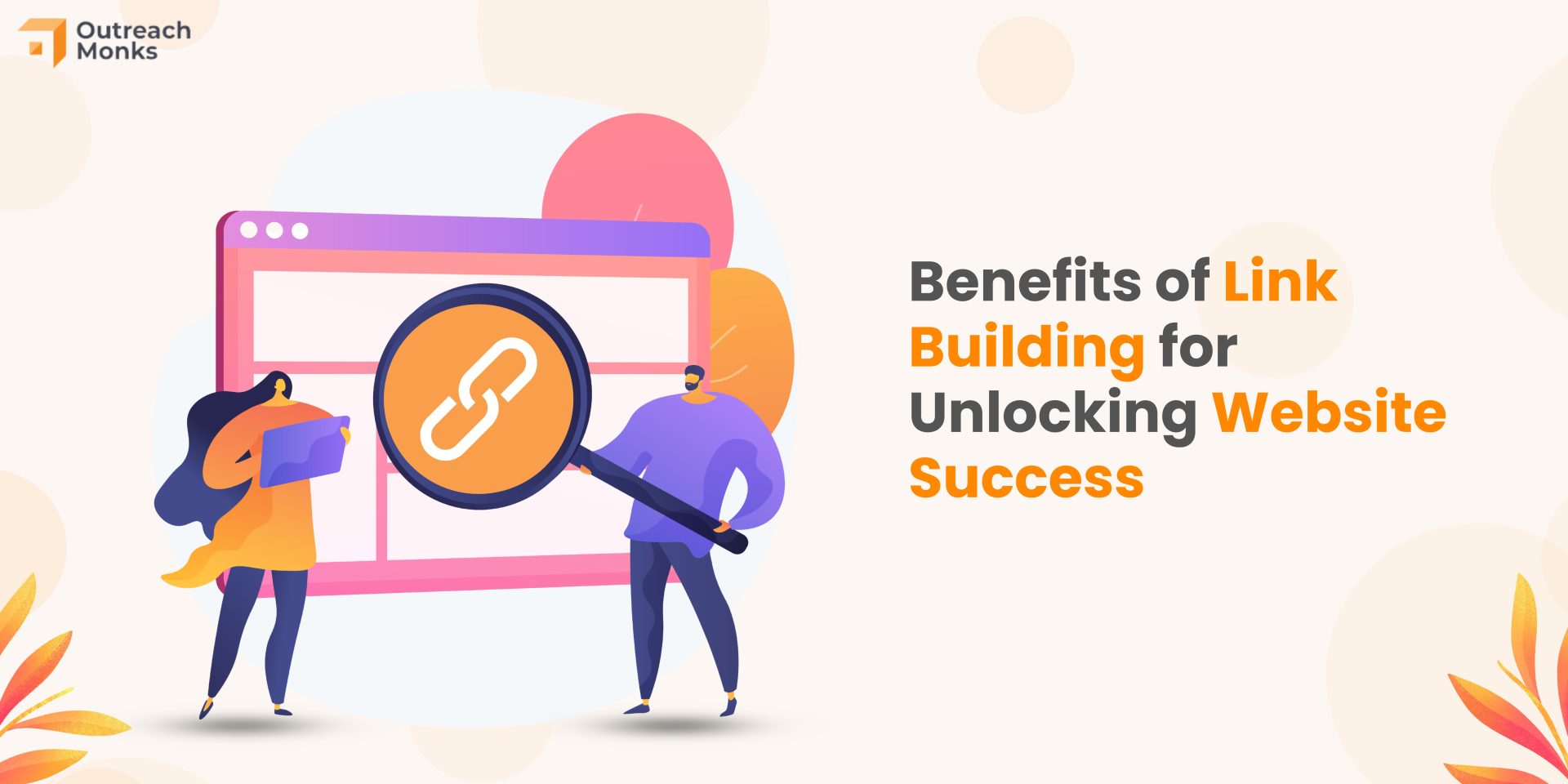
- Write For Us
- Link Building Service
- Blogger Outreach Service
- Link Building Company
- Niche Edits
- International Link Building
- Casino Backlinks
- SEO Reseller
- SaaS Link Building
- SEO Company Primelis: SEO Services Review
- Privacy Policy
- Terms of Use
Copyright © 2022, Outreach Monks. All rights Reserved
Find Keyword Ideas in Seconds
Boost SEO results with powerful keyword research
SEO Case Study: How I Increased My Organic Traffic 652% in 7 Days
Written by Brian Dean

There’s a SEO strategy that’s crushing it right now.
(“Skyscraper Technique 2.0”)
I used this strategy to increase organic traffic to one of my pages by 652.1%:
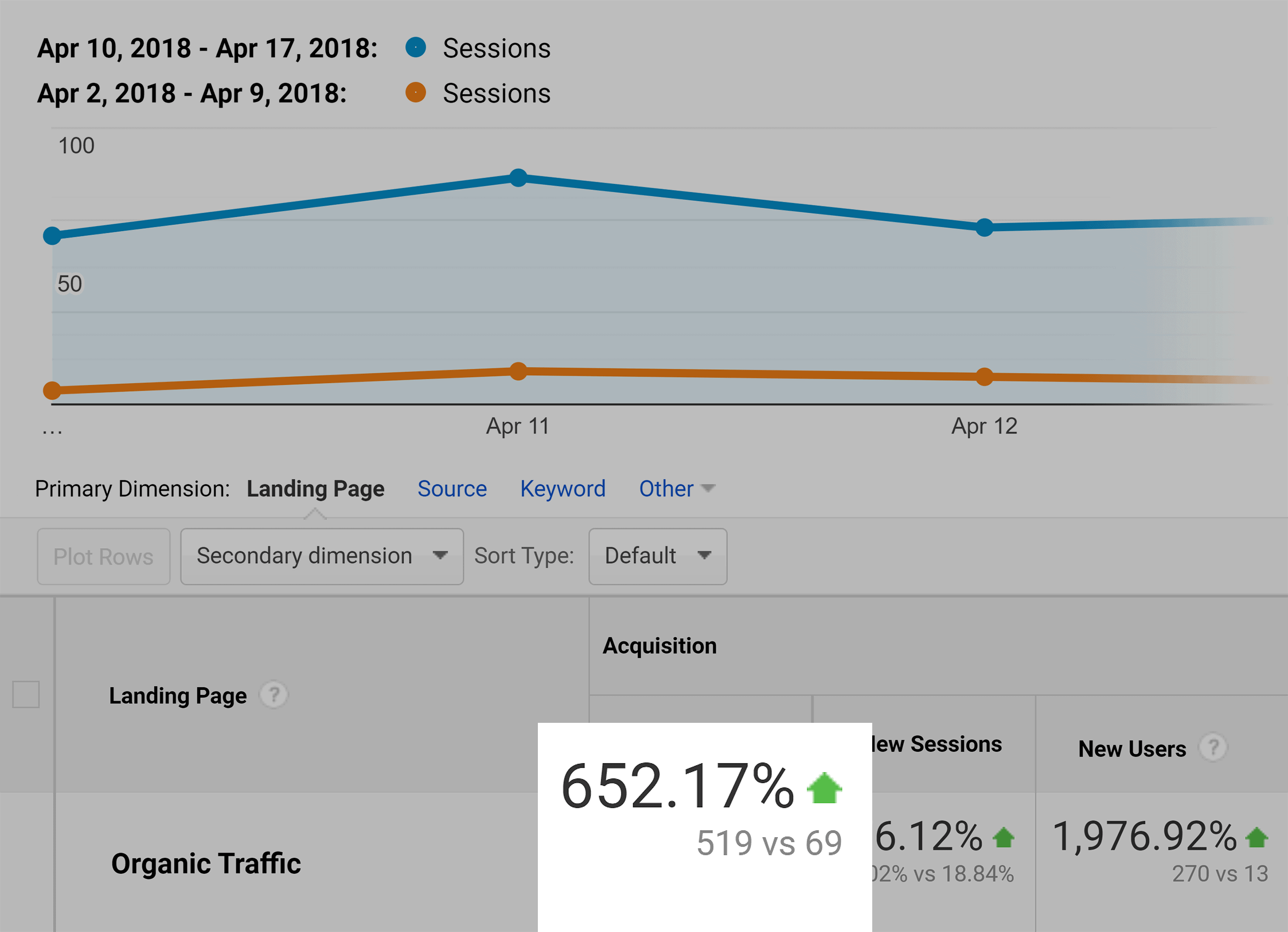
(In 7 days!)
This same approach helped my brand new post hit the #1 spot in Google… within weeks:

And today’s SEO case study I’m going to show you exactly how I did it, step-by-step.
My Content Was a Smash Hit… Then It Flopped
On July 26th, 2016 I published this post:
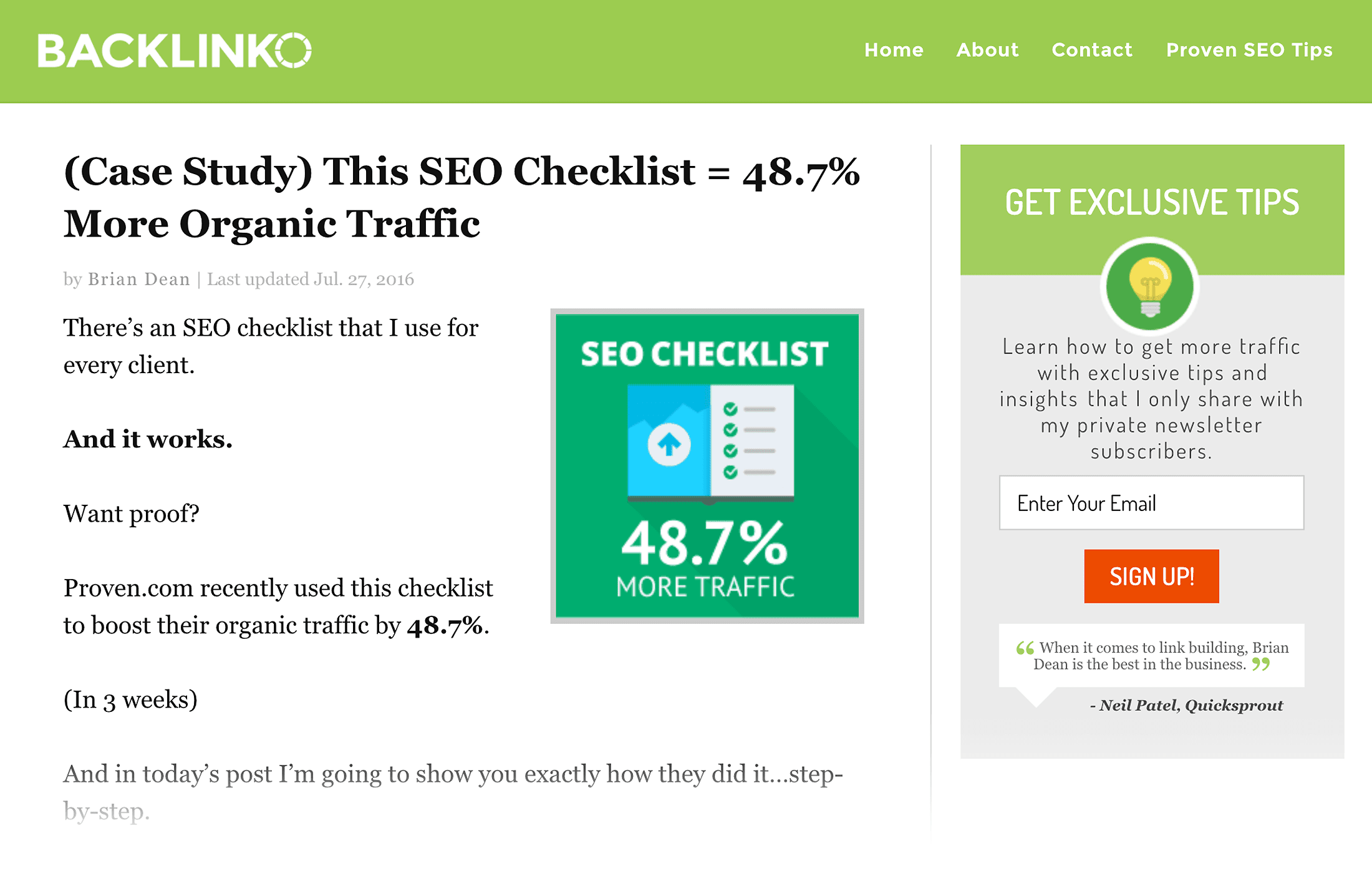
My post got a huge spike in traffic in its first week:

Lots of shares:

And people quickly started linking to it:

Sure enough, my page cracked the top 10 for my target keyword (“SEO checklist”) a few weeks later.
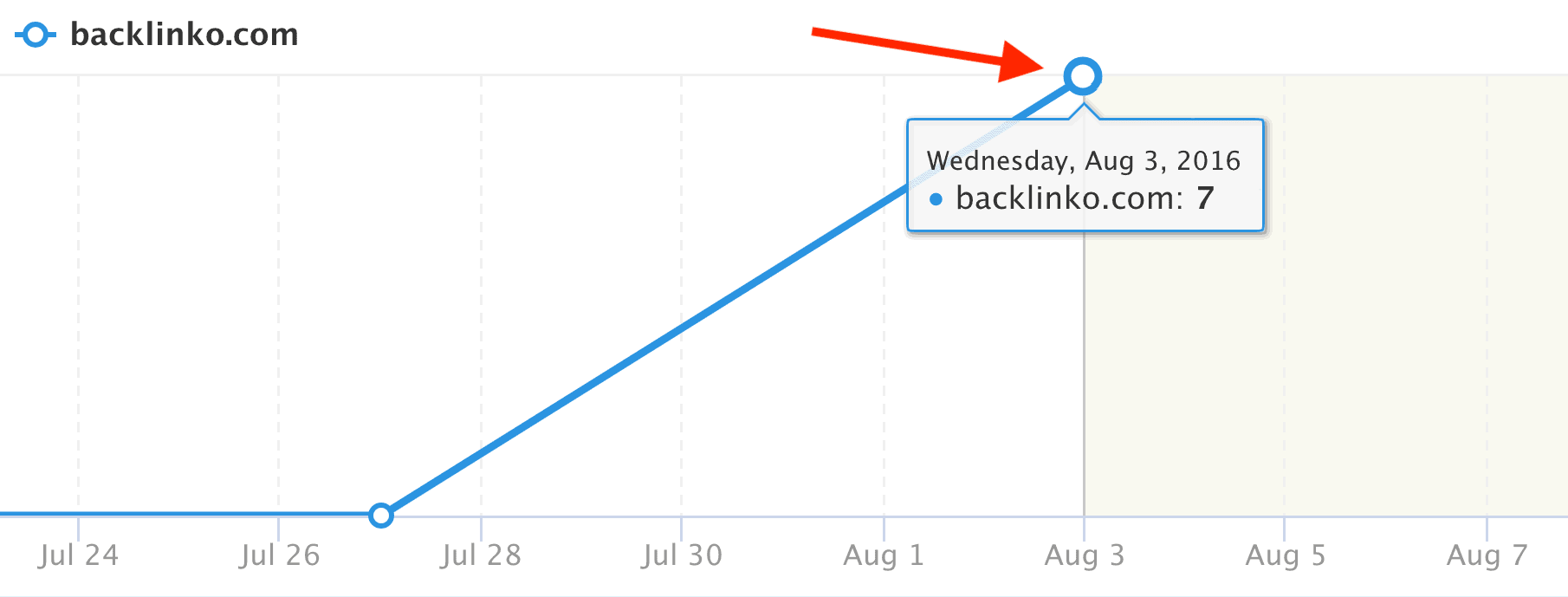
All good right?
Well… not really.
You see, my posts usually get more traffic from SEO over time.
Not my SEO checklist page.
In fact: organic search traffic to that page decreased as time went on.

It got so bad that my post averaged only 4-5 visitors per day.

And my rankings dropped to the middle of the second page:
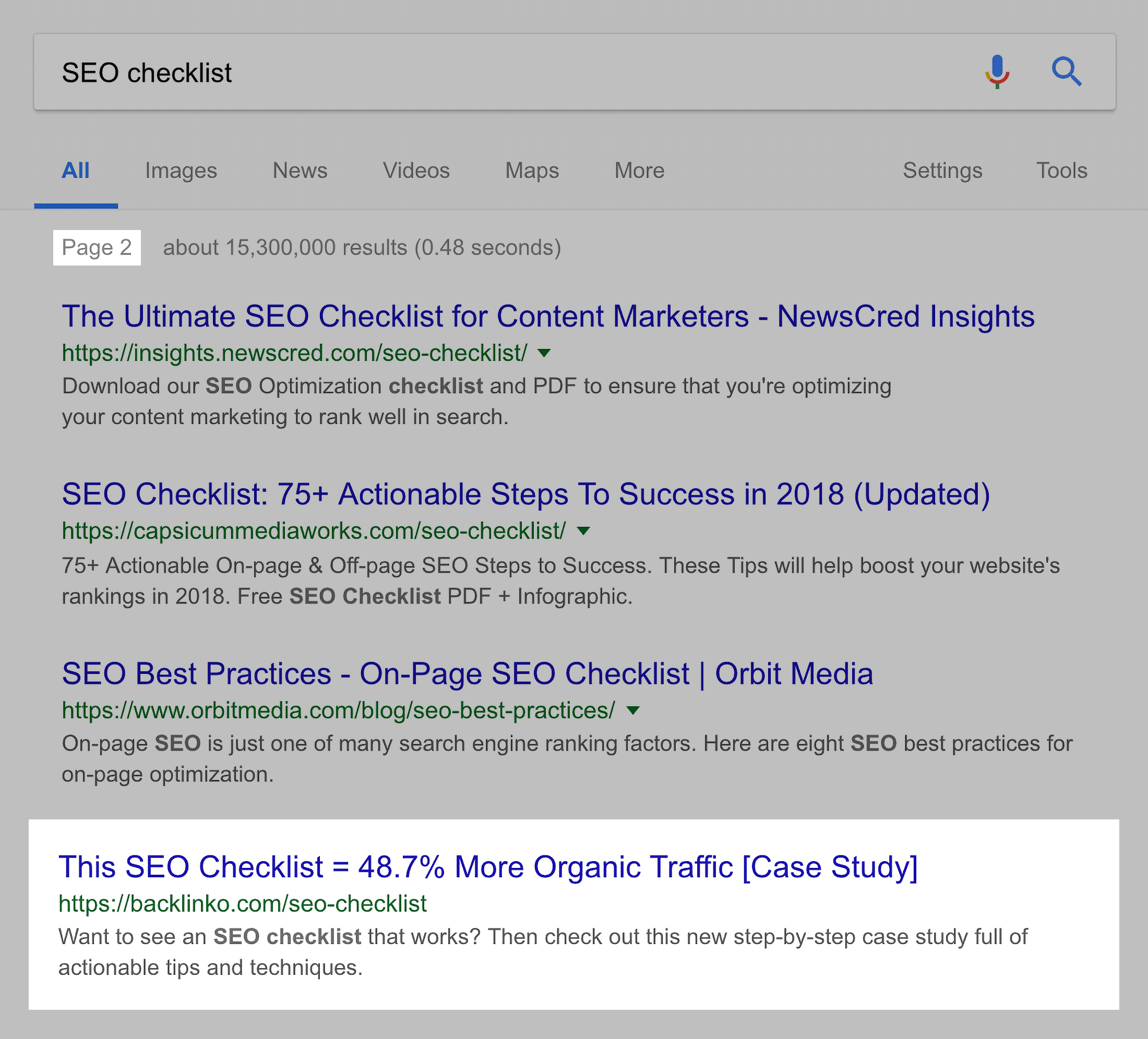
That’s When I Wondered: “What Happened?!”
On paper my content had everything going for it:
200+ backlinks.
Lots of comments ( which Google likes ).
And social media shares out the wazoo.
What was missing?
User Intent.
User Intent + SEO = Higher Rankings
Google’s #1 goal is to make users happy.
This means they need to give people results that match their user intent .
Never heard of User Intent? Here’s a simple explanation:
User Intent
The main goal behind a user's Google search.
And Google is REALLY good at figuring out User Intent (also sometimes called “ Search Intent ”).
In fact, a big part of Google RankBrain is to give users “ results that it thinks searchers will like the most ”.
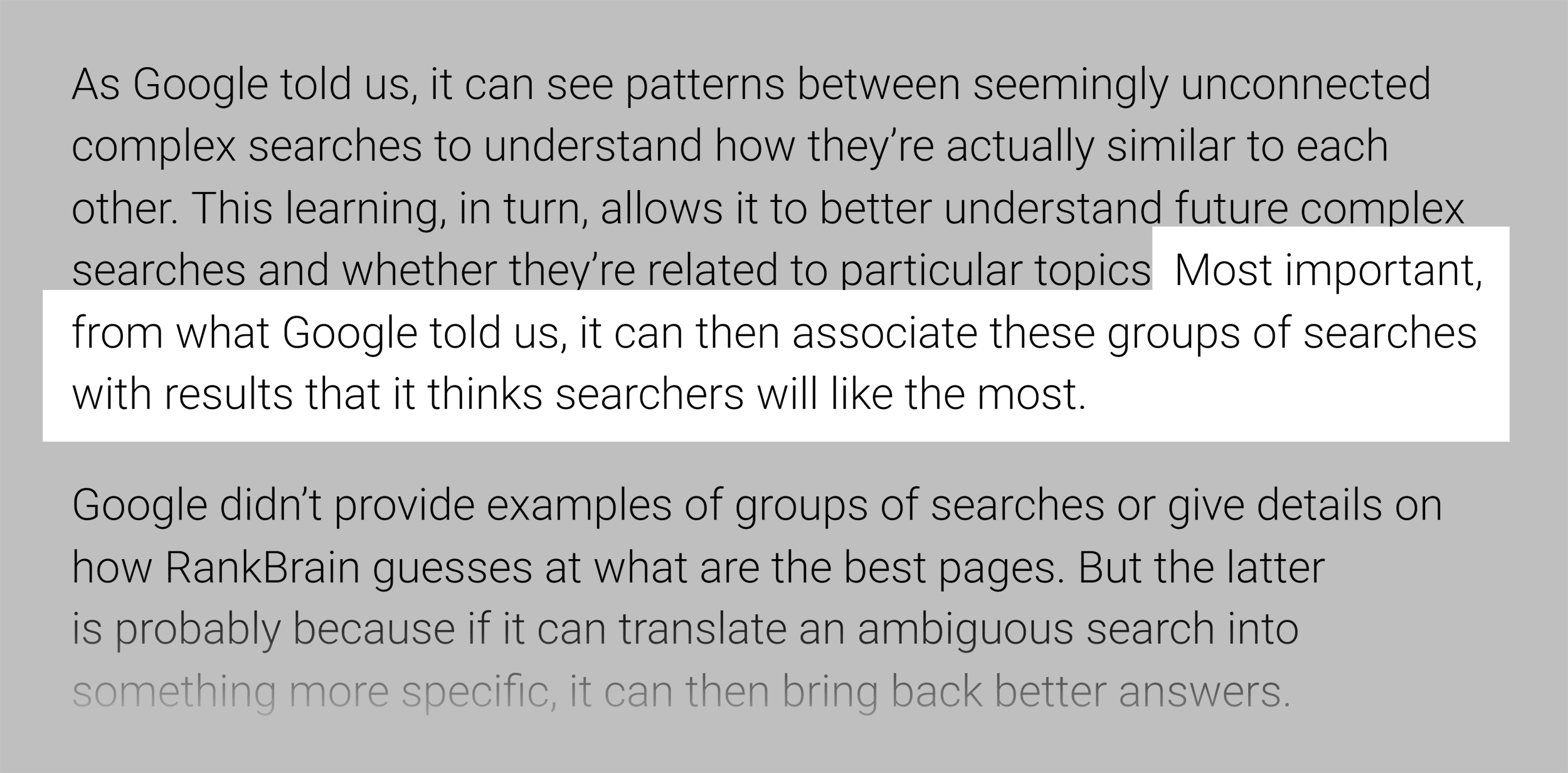
And the 2018 Google Quality Rater Guidelines has an entire section on User Intent:

Google has even started asking users about their User Intent:

That’s when it hit me:
My post was getting buried because it didn’t satisfy user intent.
Here’s what happened next:
Skyscraper Technique 2.0: (An SEO Strategy That’s Working GREAT Right Now)
After I optimized my page around User Intent, organic traffic shot up like a rocketship:

And my rankings went from #11 to #5:

(And these improved rankings have stuck 4+ months later.)

With that, here are the steps for The Skyscraper Technique 2.0:
Step 1: Figure out User Intent
Step 2: Satisfy User Intent
Step 3: Optimize for UX signals
To be clear:
The original Skyscraper Technique still works GREAT.
For example, this list of SEO tools is classic “Skyscraper” content marketing.

Most SEO tools posts list 10-20 tools. So I decided to review over 170:

And because my page is bigger and better, lots of people have linked to it:

This page also satisfies User Intent.
This is why it ranks in the top 3 for my target keyword:

Ideally, you want to use Skyscraper Technique 1.0 AND 2.0.

Skyscraper Technique 1.0 helps you get the links you need to hit the first page.
And Skyscraper Technique 2.0 will make sure those rankings stick.
Let’s dive into the steps…
Step #1: Figure Out User Intent
Here are two simple ways to identify User Intent:
Analyze the First Page
Google’s first page gives you a HUGE insight into User Intent.
If something ranks on Google’s first page, you KNOW that it satisfies User Intent.
So all you need to do is search for your keyword…
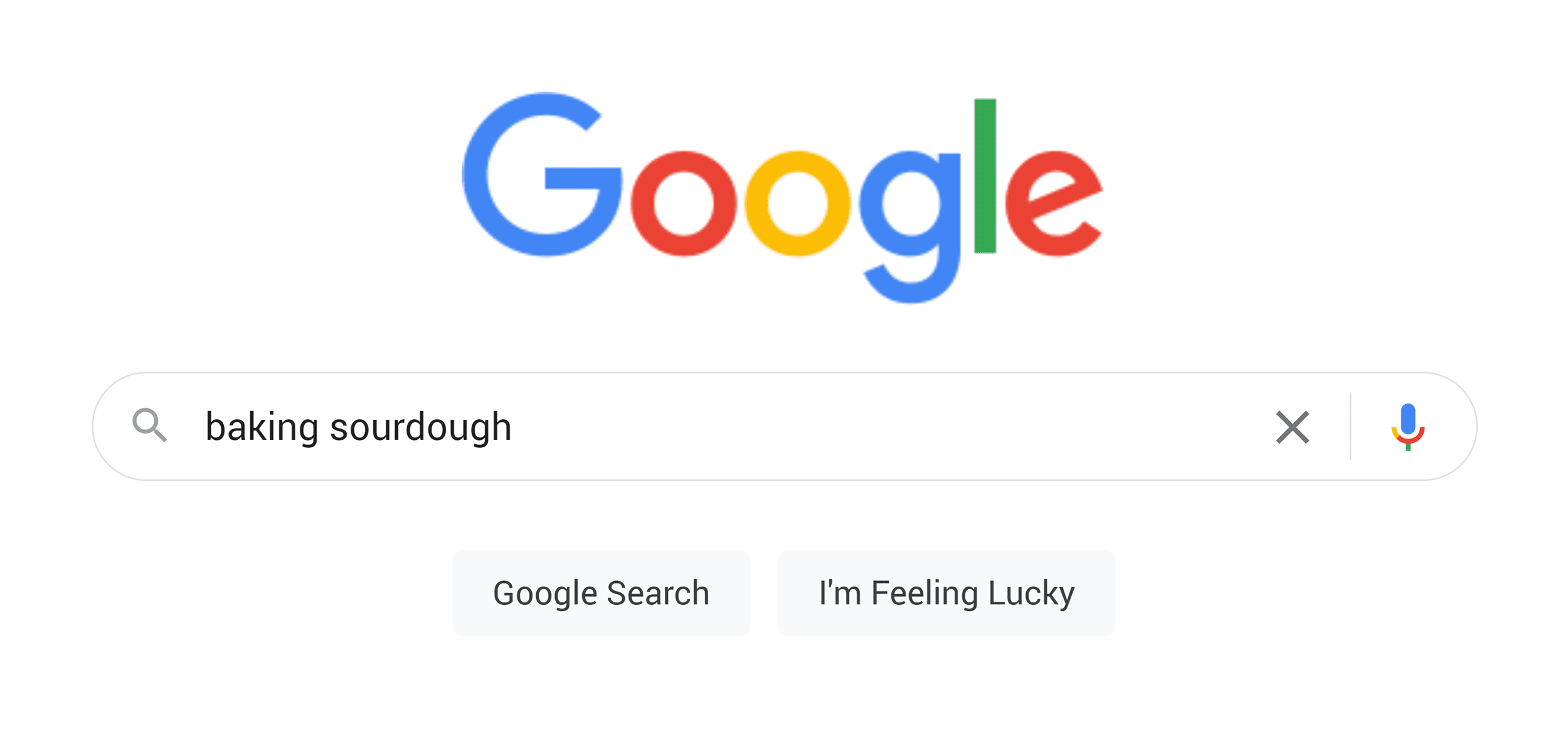
…and scan the SERPs.
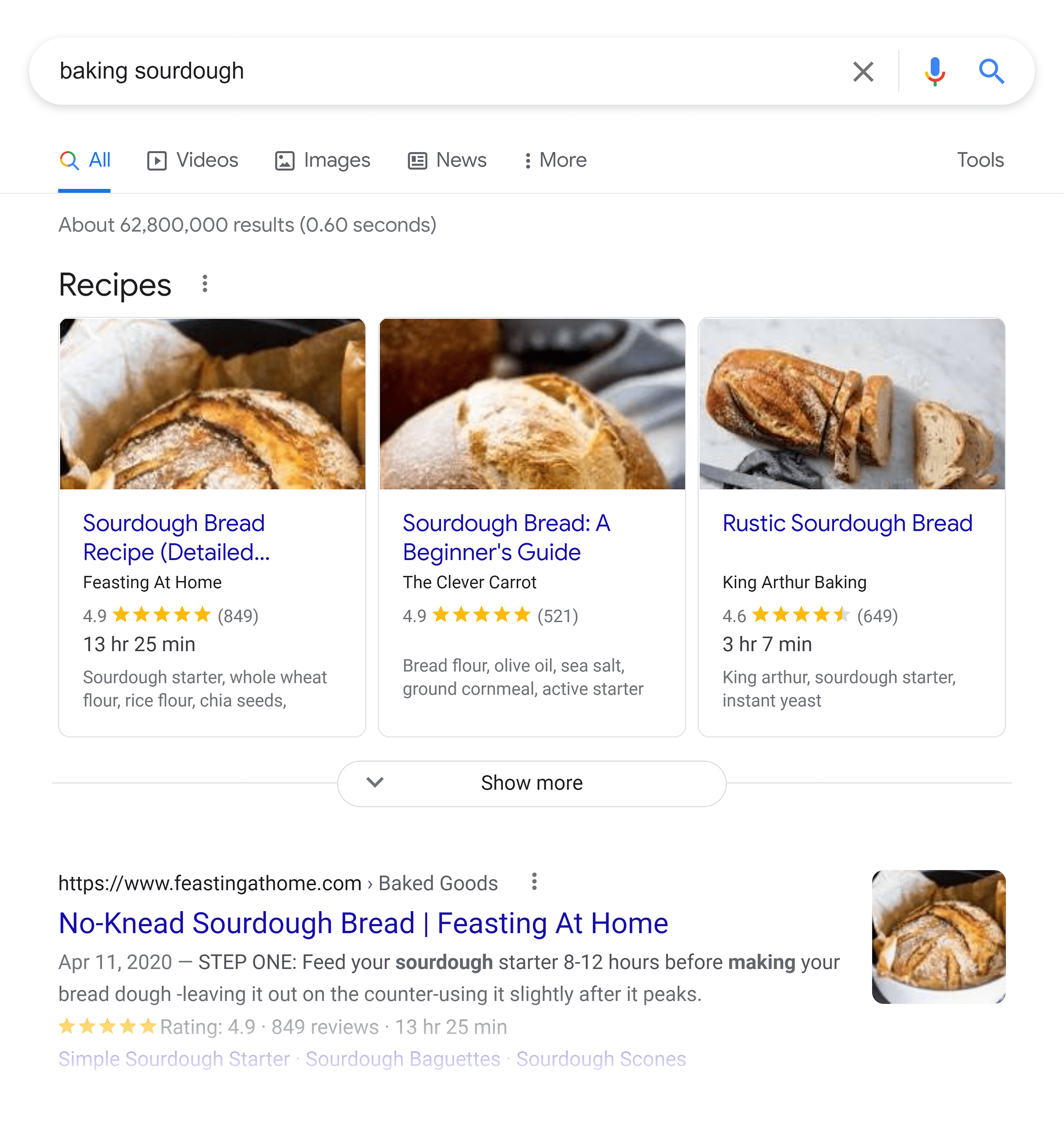
Specifically, answer the question:
“What kind of intent do these results satisfy?”
Do people want information? If so, are they looking for the basics… or advanced strategies?
Do they want to buy something? If so, are they ready to buy… or comparing two different products?

For example…
If you search for “Office Space Brooklyn”, the results are 100% transactional:
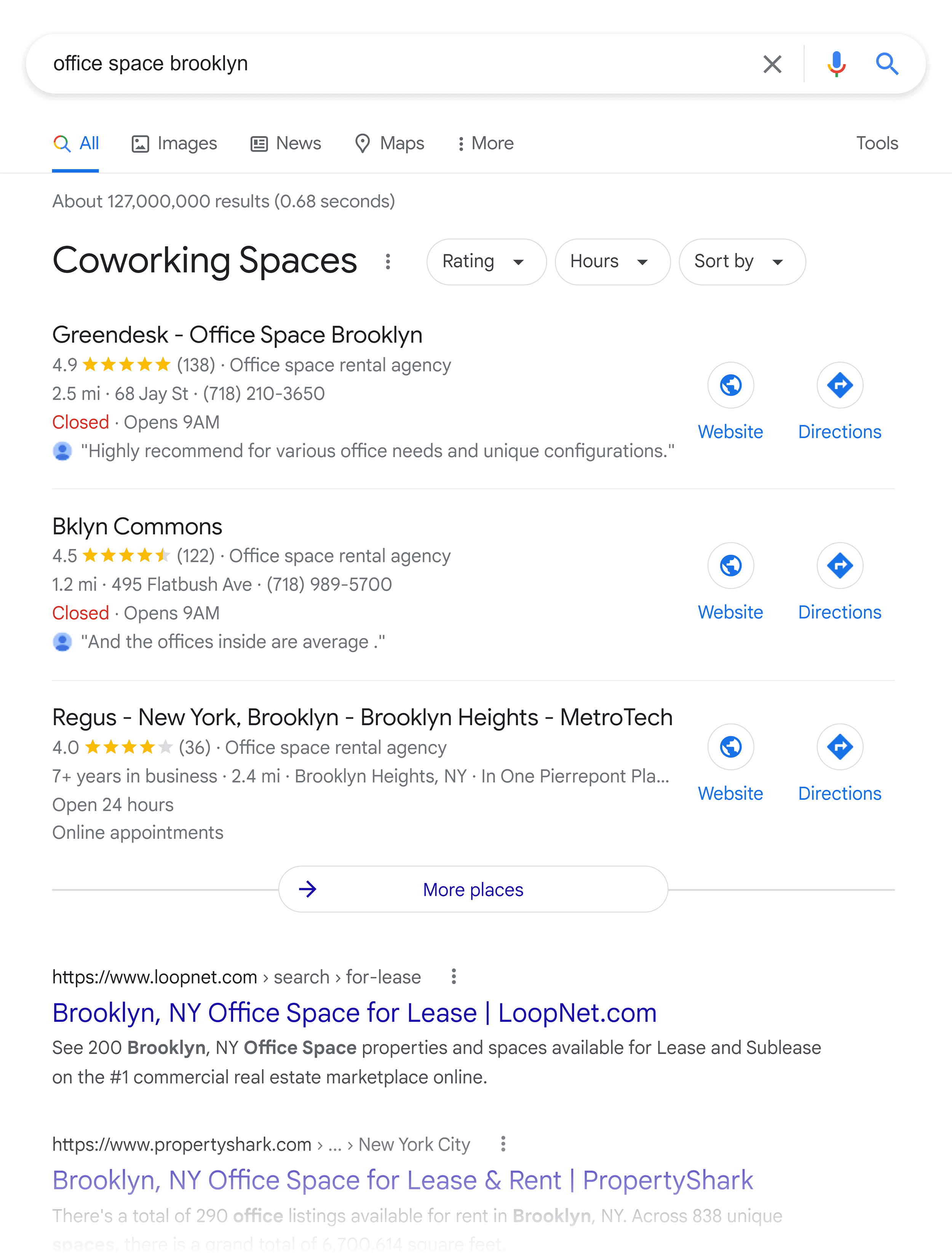
In fact, 10 out of 10 results are product pages for booking an office space:
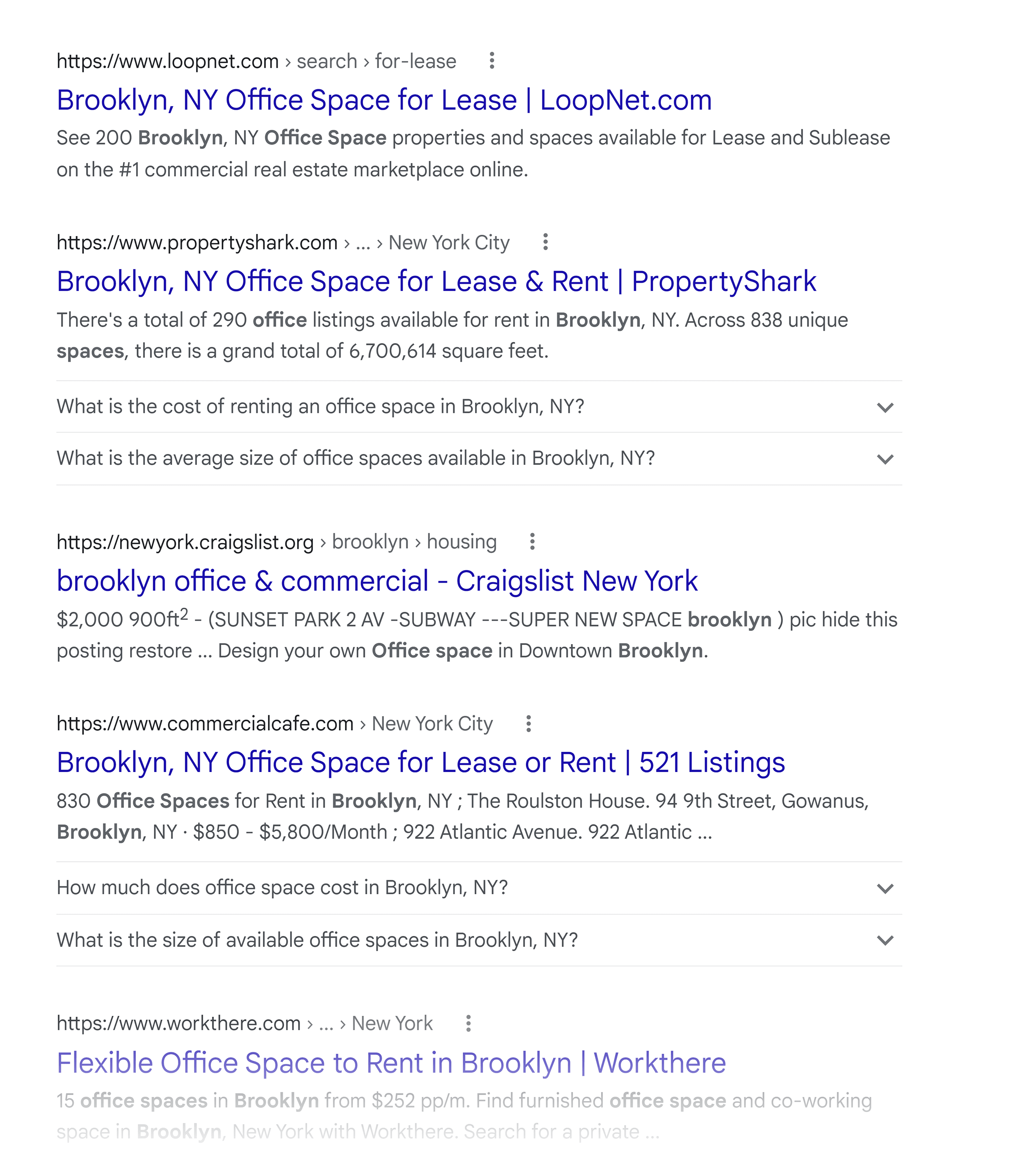
But if you search for “Coworking Space Brooklyn”, you get something completely different:
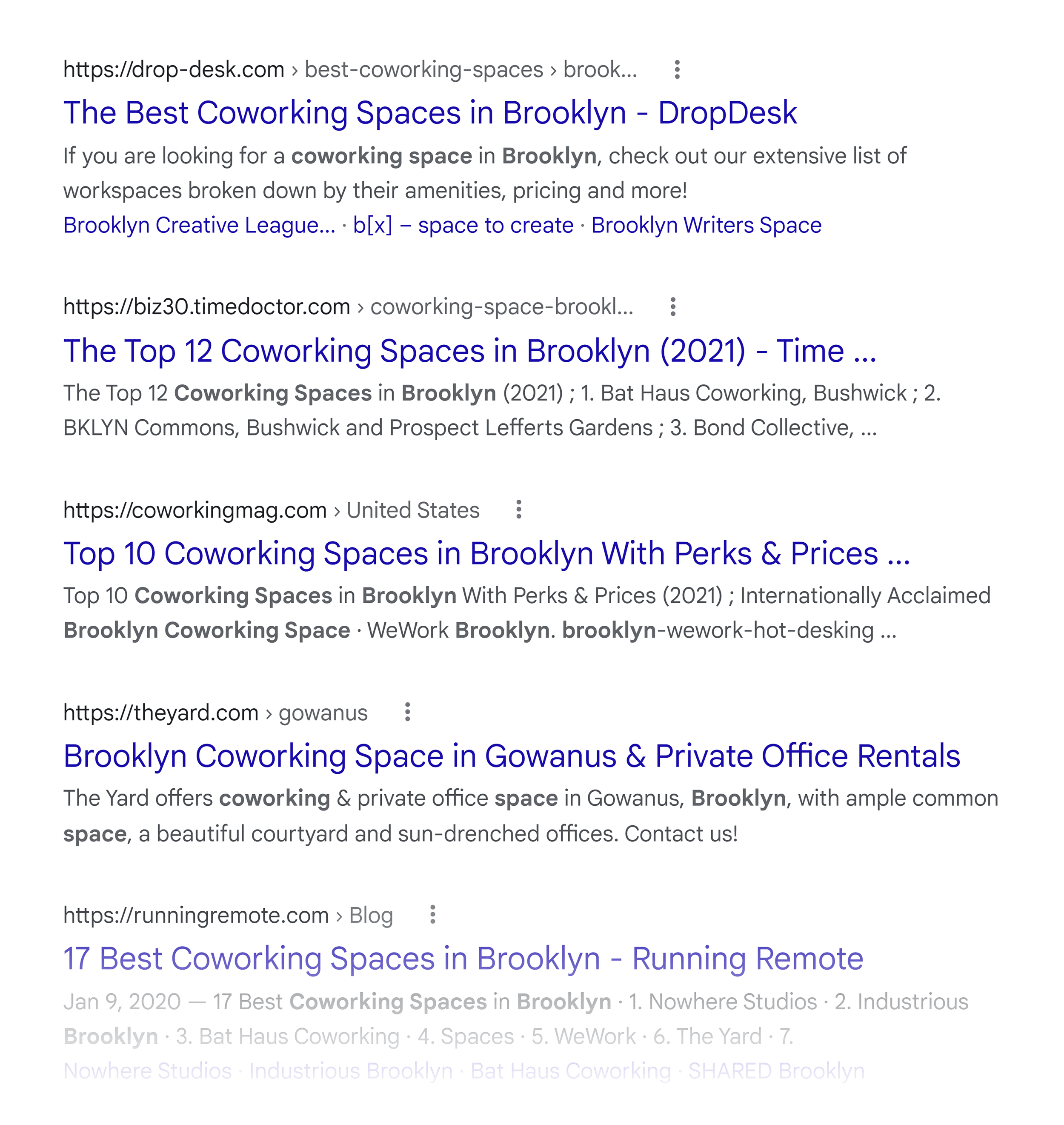
The results are mostly blog posts about the best coworking spots in the city:
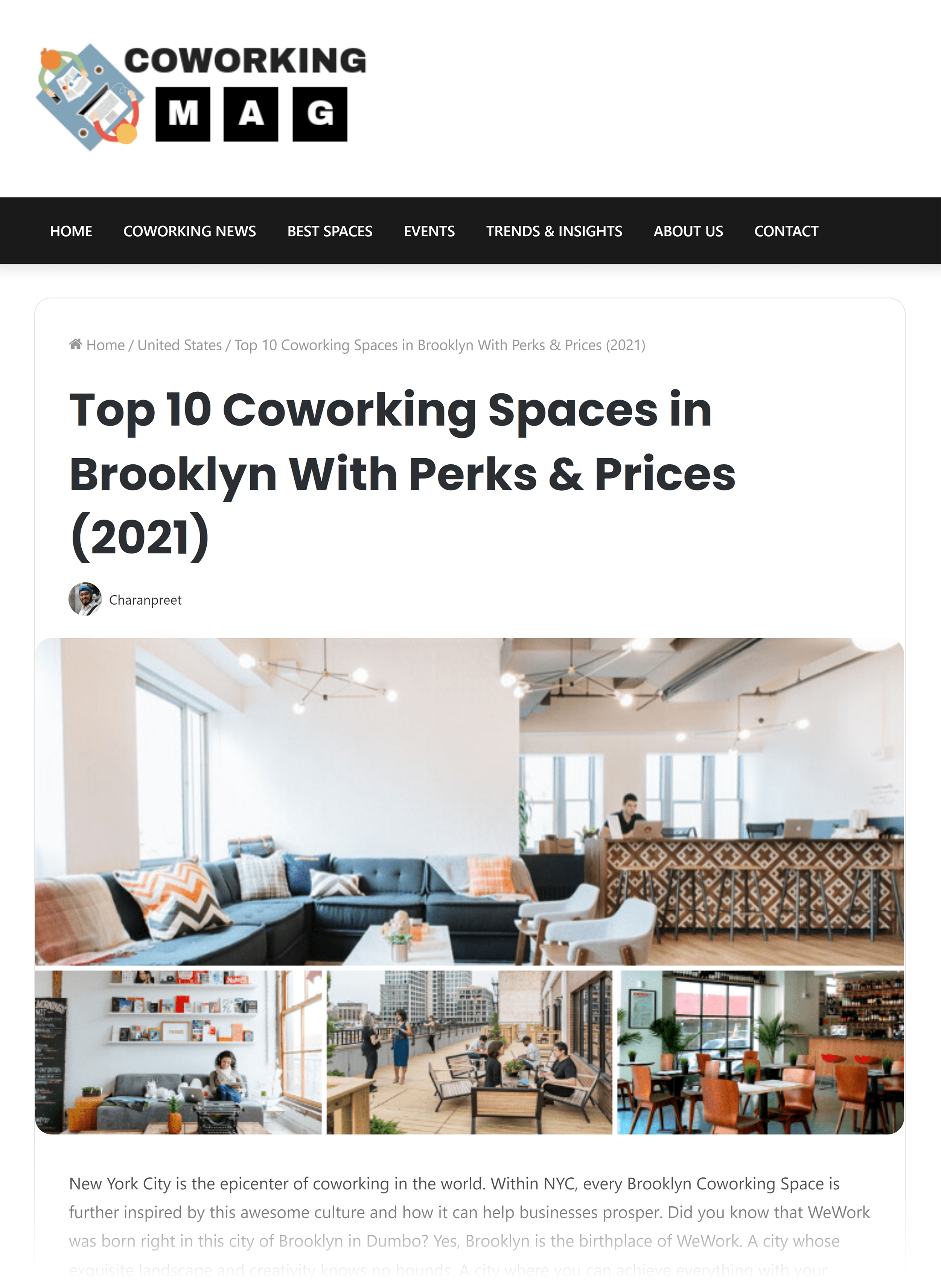
On the surface these keywords seem similar.
But Google’s first page reveals that the User Intent is VERY different.
Look At the Keyword Itself
Sometimes the keyword itself tells you all you need to know.
With my SEO checklist post, I asked myself:
“What does someone searching for ‘SEO checklist’ actually want?”
Duh! They want an SEO checklist.
Despite that, my original post was a case study… not a checklist.
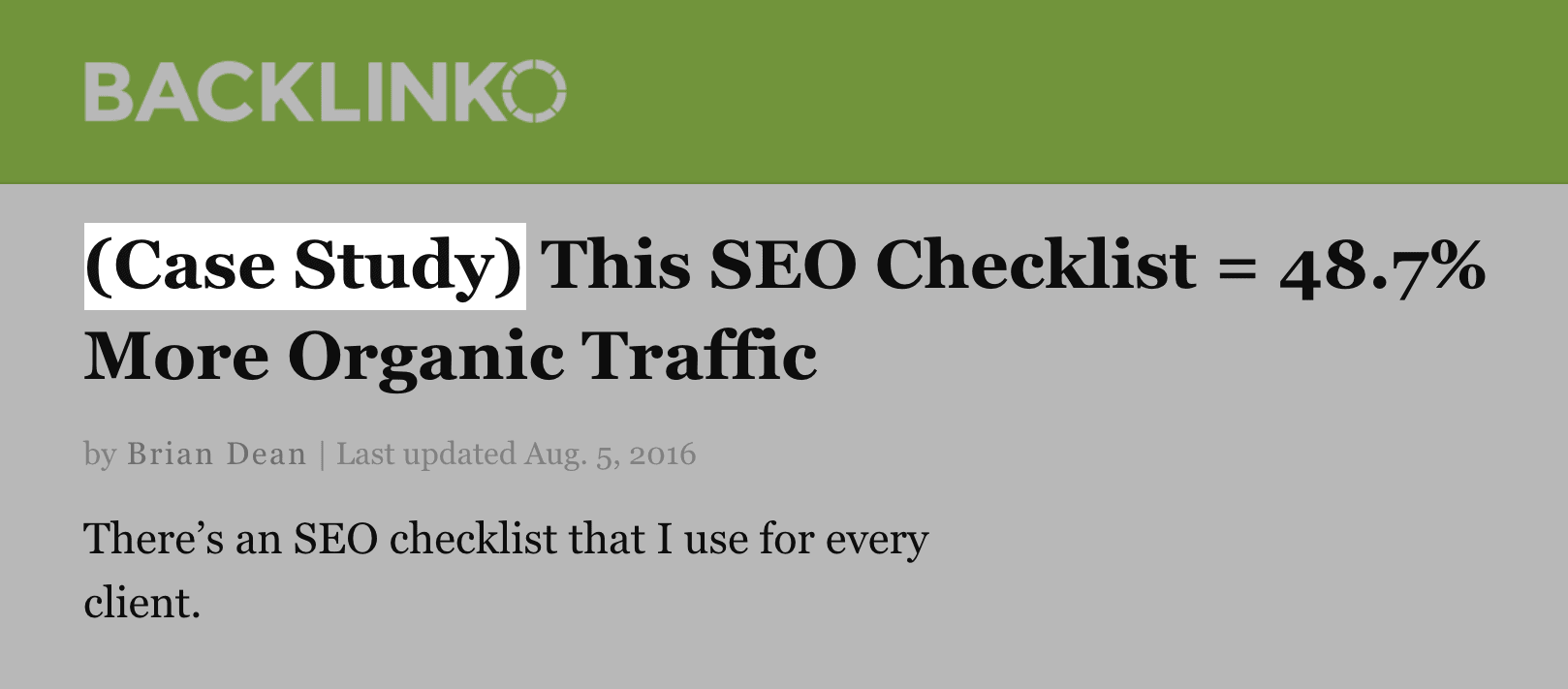
Sure, there were some steps that resembled a checklist.

But it wasn’t the type of detailed checklist that searchers wanted.
And Google noticed.
This leads us to…
Step #2: Satisfy User Intent
At this point I had User Intent figured out.
And now it was time to publish a piece of high-quality content to match that User Intent.
Here’s exactly how I did it:
Covered the Basics
I noticed that other content ranking for the “SEO checklist” had steps for people new to SEO:

And I quickly realized something:
My original post was WAY too advanced.
In fact, the first step was: “Delete Dead Weight Pages”.

This is a strategy that people new to SEO should absolutely NOT use.
So I replaced this advanced strategy with steps for SEO newbies:
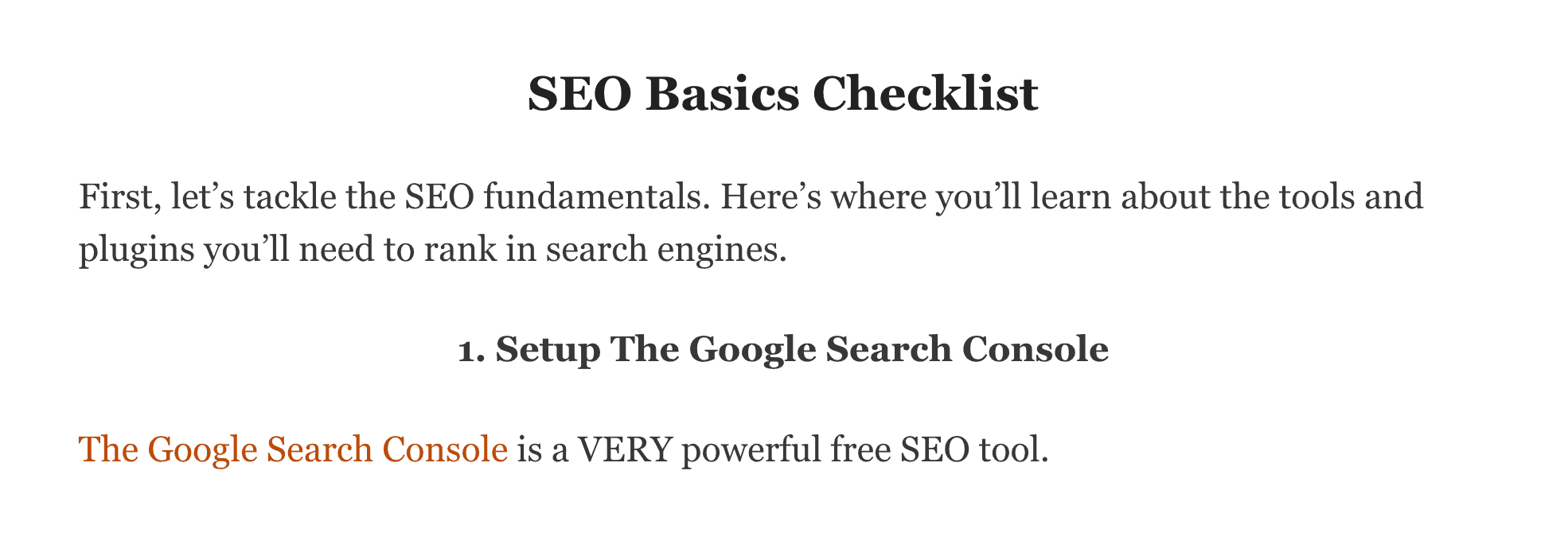
Changed the Format
Like I mentioned earlier, the original version of my post was a step-by-step case study.
So I changed the format.
This time, I made the content more checklisty .
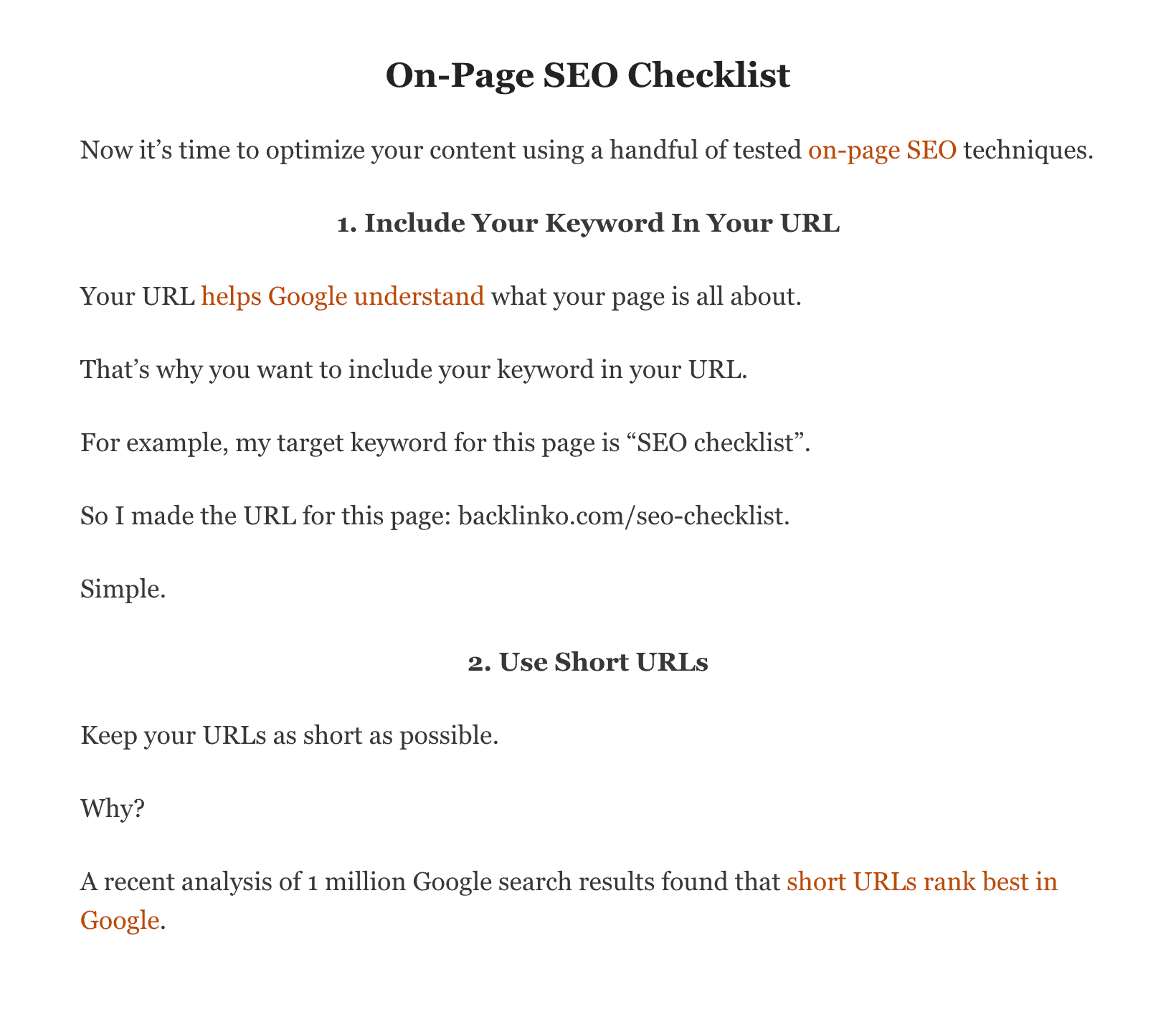
Covered More Stuff
Google’s top 10 results were clear:
People searching for an “SEO checklist” want checklists that cover LOTS of different stuff.
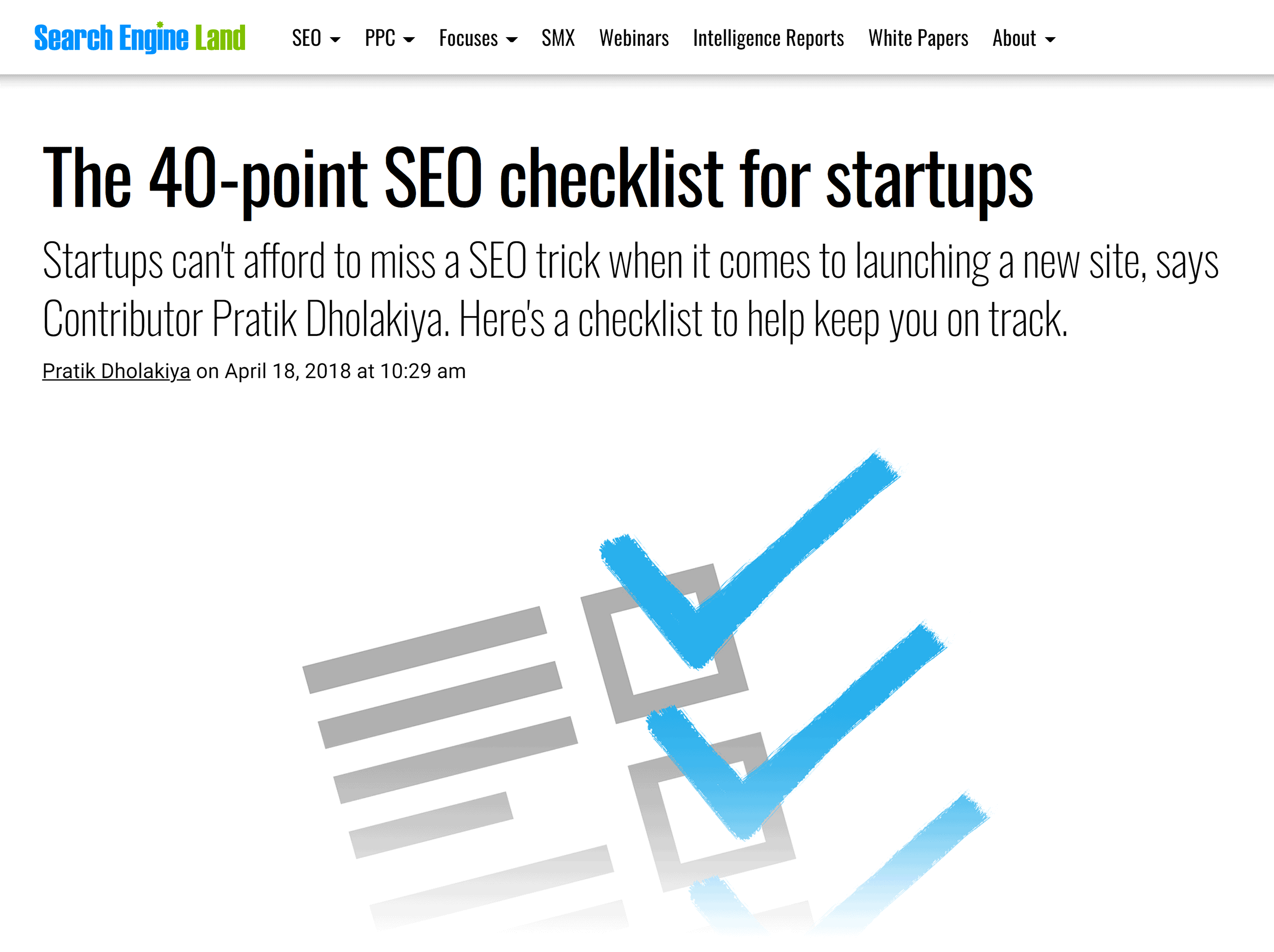
Despite that, my post had ZERO info on:
- Technical SEO
- Link building
- Keyword research
- SEO software and tools
So I expanded my post to hit on these important subtopics:

I Emphasized “2018”
I noticed a clear pattern in the search results:
Most of the content pointed out that their checklist worked in 2018.
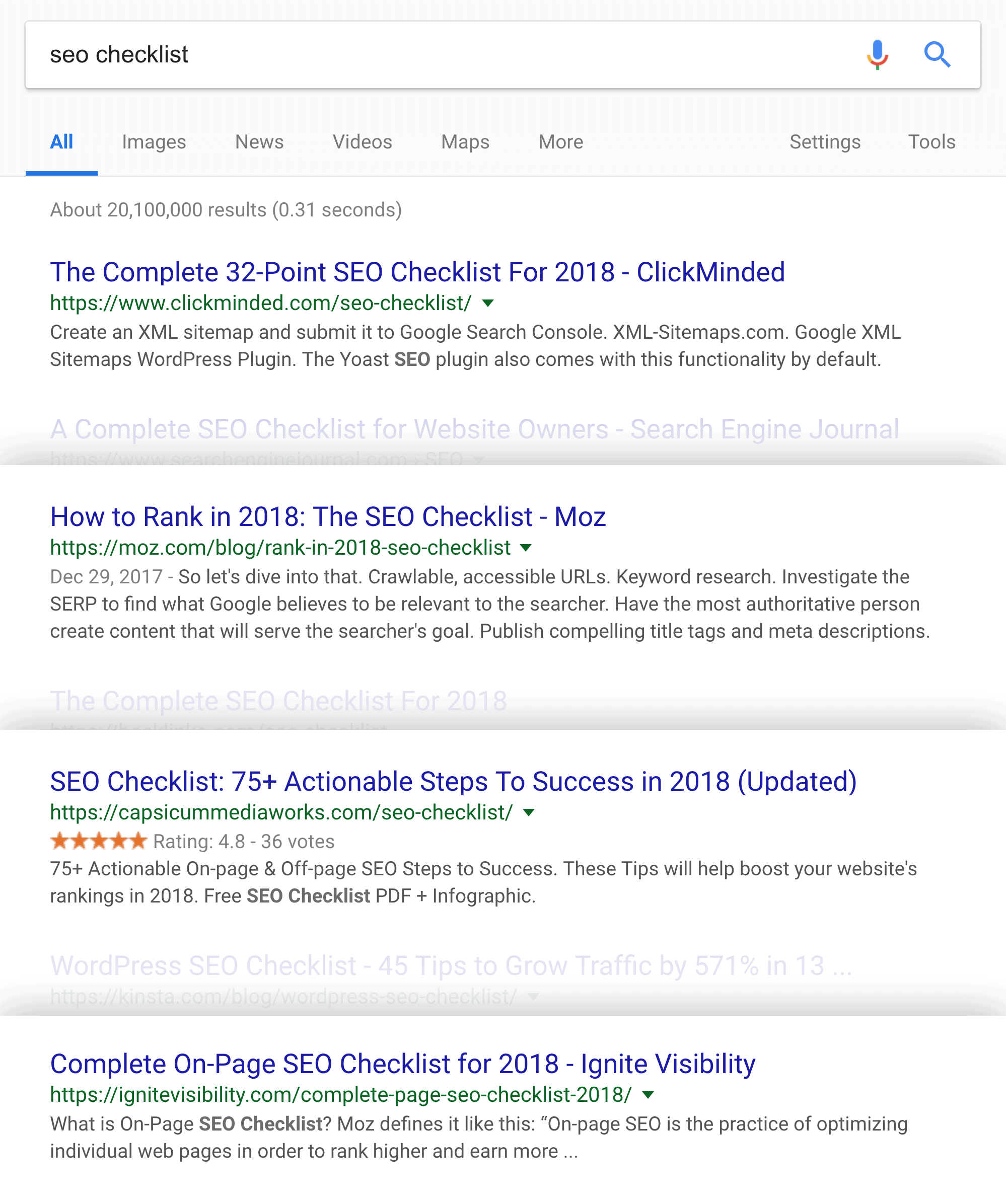
So I emphasized that my checklist was up-to-date.
I included “2018” in my title tag…

…in the introduction…
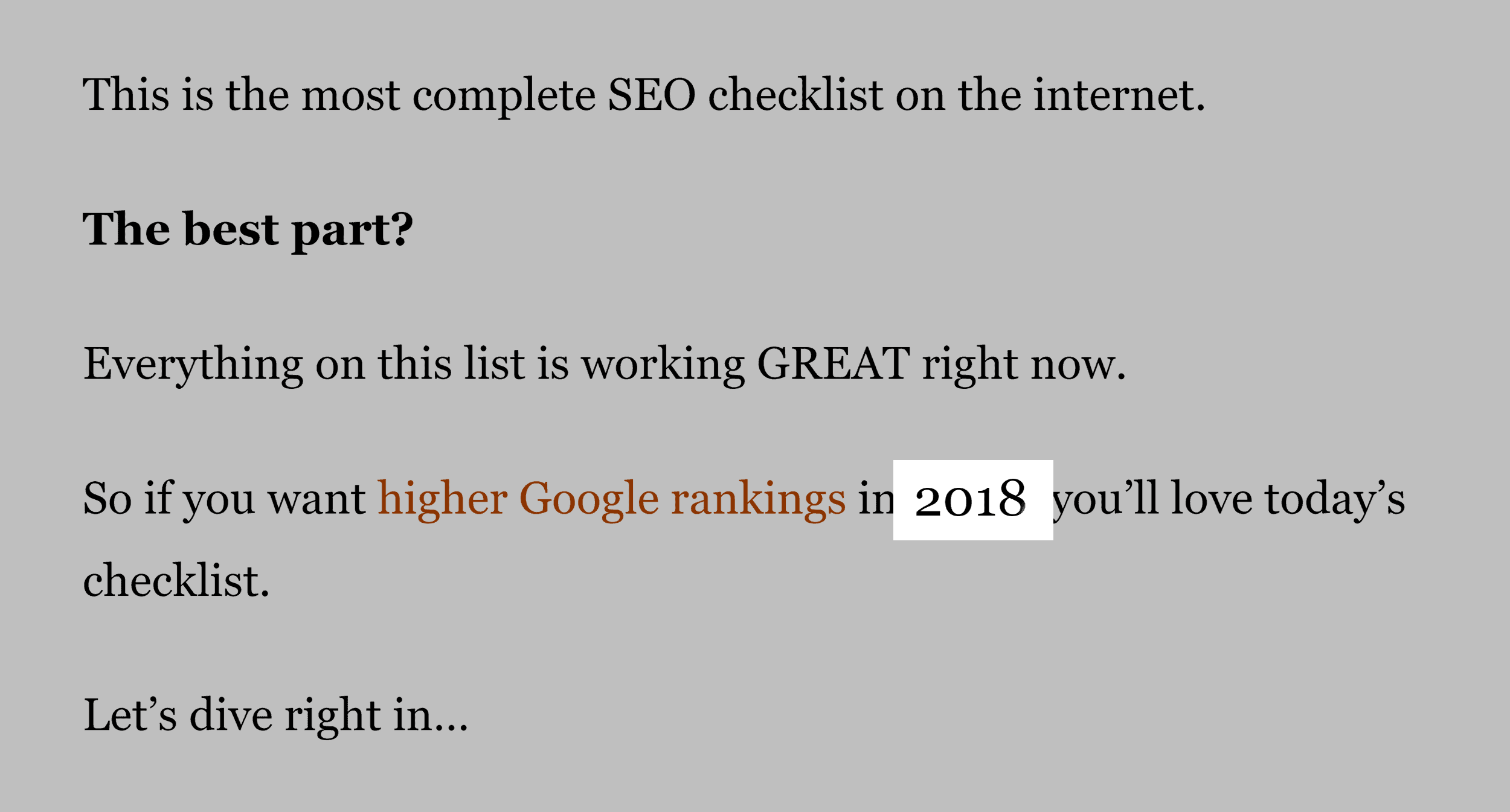
…and I even mentioned “2018” a few times in the content itself:

In this case, I rewrote an existing post.
But you can use this same strategy for brand new content.
A while ago I wanted to write something about mobile optimization.
The first thing I did was a search for “Mobile SEO”… and scan the results.
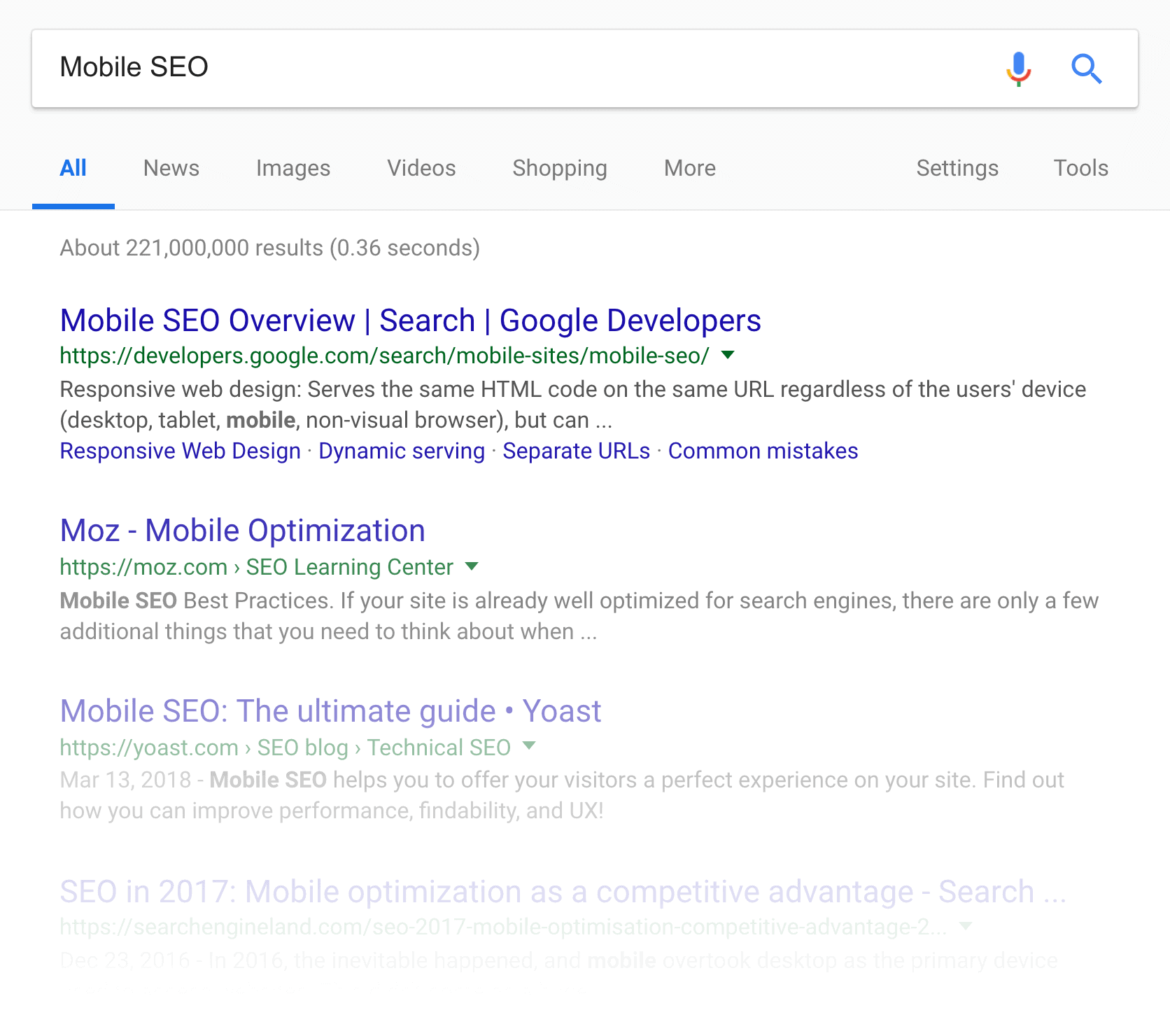
And I noticed 3 things about Google’s first page results:
They covered WHY mobile SEO is important.

So I led off my guide with a handful of stats:
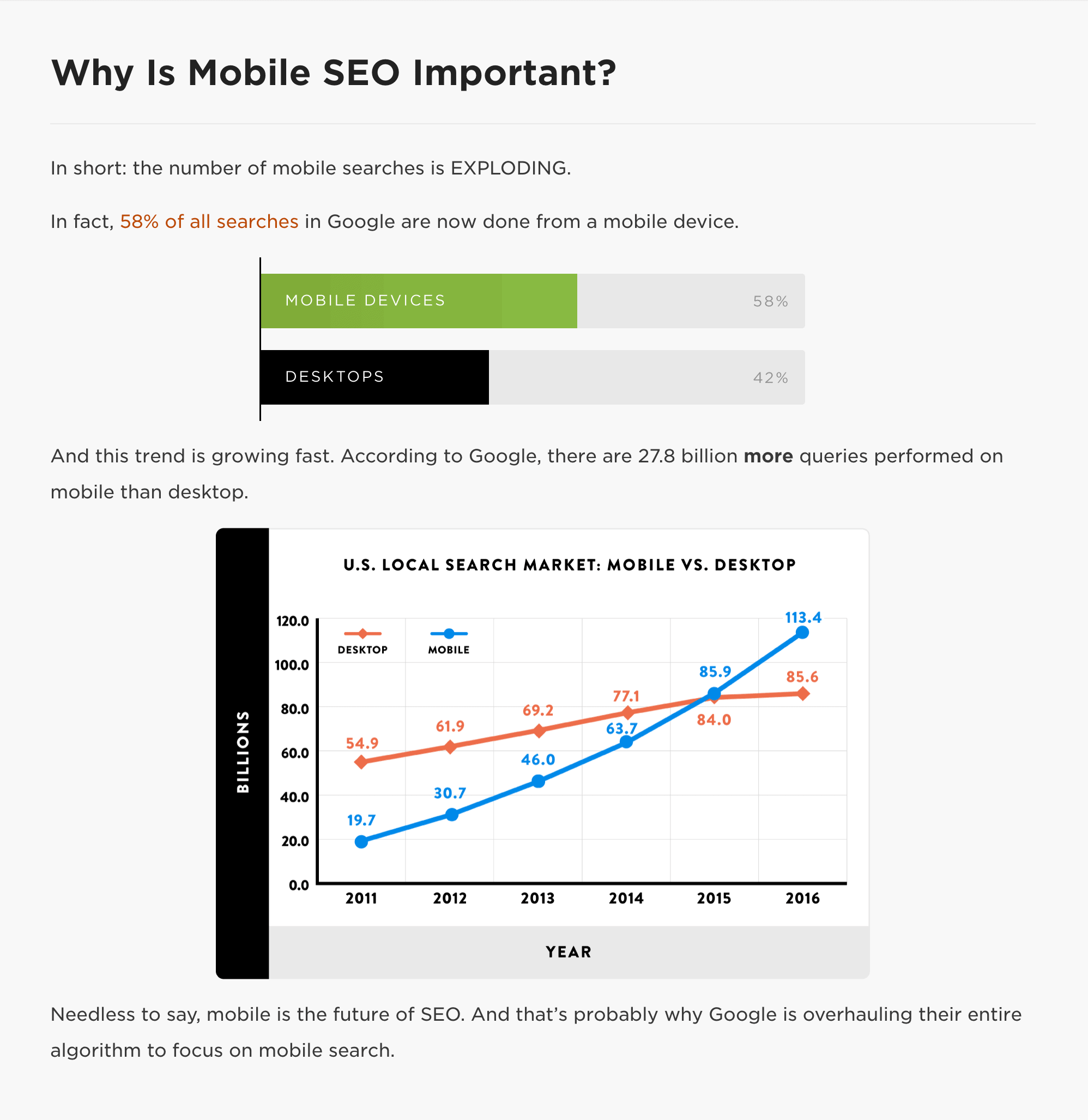
2. They wrote about responsive design vs. dynamic serving vs. “M. mobile sites”

3. They had tips for improving sitespeed.
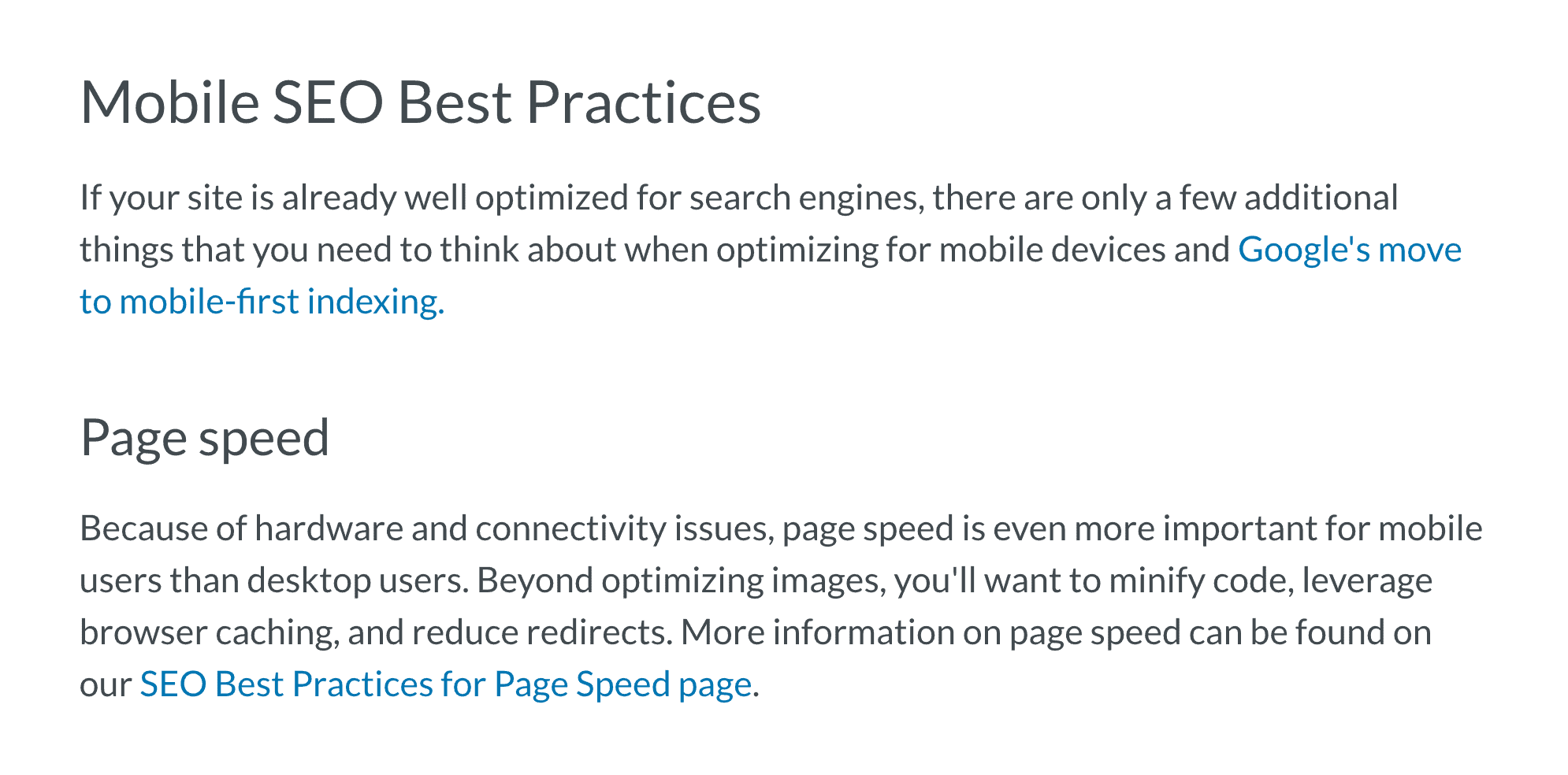
So I included a section on that.
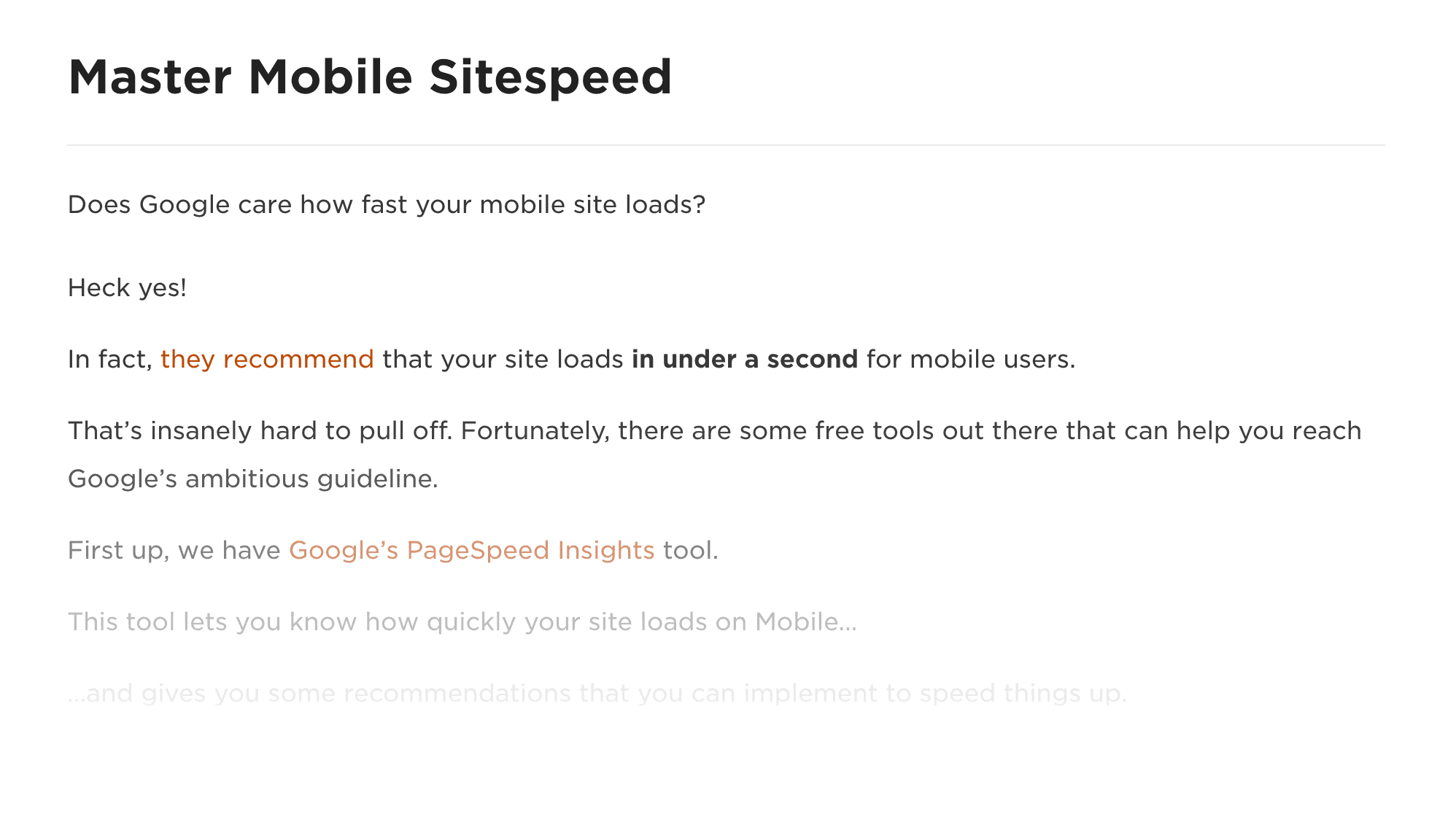
The end result was “ Mobile SEO: The Definitive Guide ”.
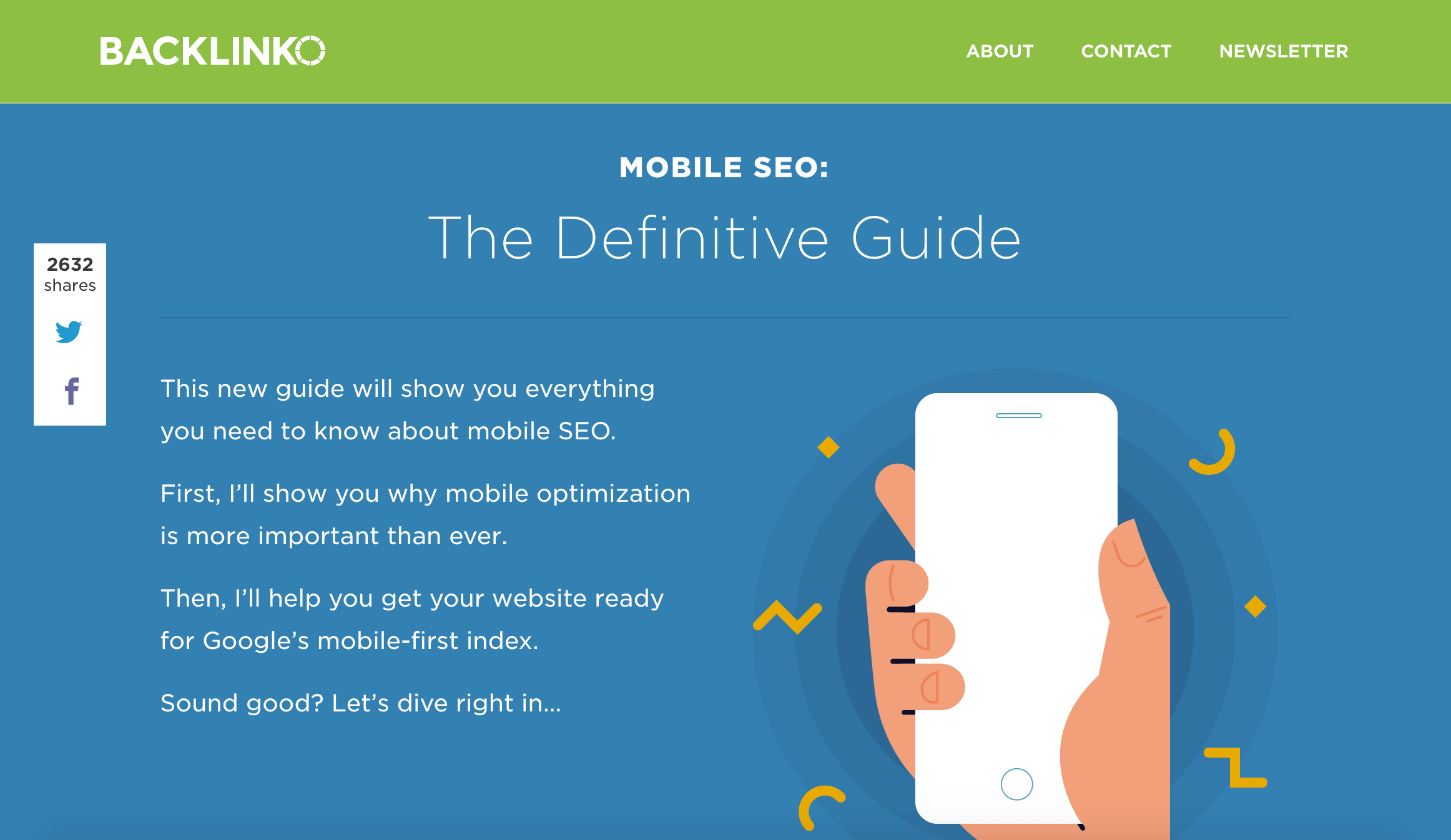
And largely thanks to The Skyscraper Technique 2.0, it quickly climbed to #1 for my target keyword:
(Above heavyweights like Moz, Search Engine Land… even Google itself.)
And now it’s time to…
Step #3: Optimize for UX Signals
Here’s the deal:
Your content can be a PERFECT match for User Intent.
But if it looks like this…
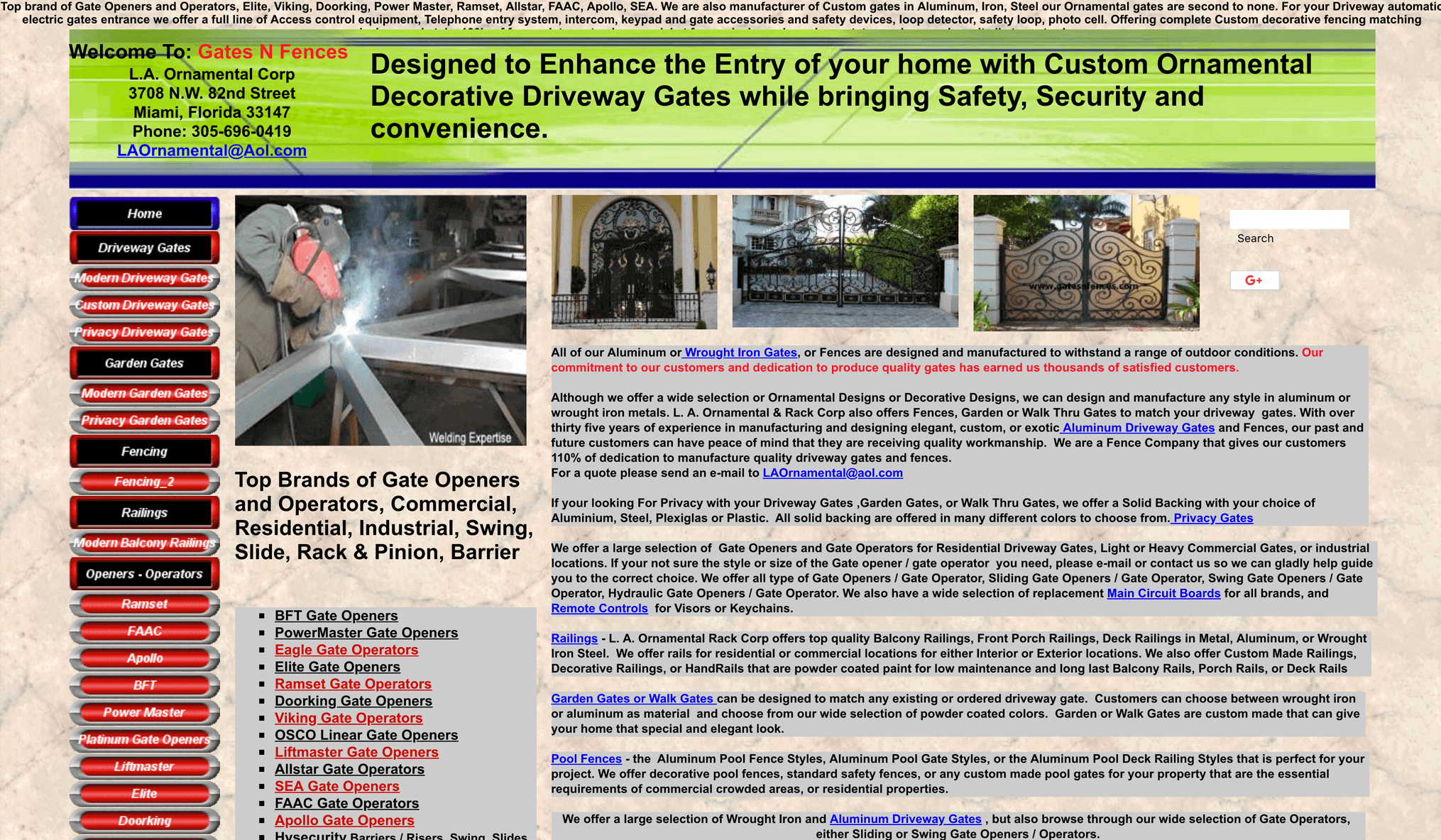
…people are gonna leave your site like it’s on fire.
And Google will quickly downrank you:

So now that you’ve nailed User Intent, it’s time to optimize for UX Signals.
Specifically, this step is all about engineering your content to:
- Maximize Dwell Time
- Maximize organic CTR
- Minimize bounce rate
Here’s how:
Embed Videos
Wistia found that: “ people spent on average 2.6x more time on pages with video than without .”

I’ve never seen a video work THAT well.
But videos can definitely keep people on your site longer.
That’s why I embedded a few videos in my SEO checklist post:
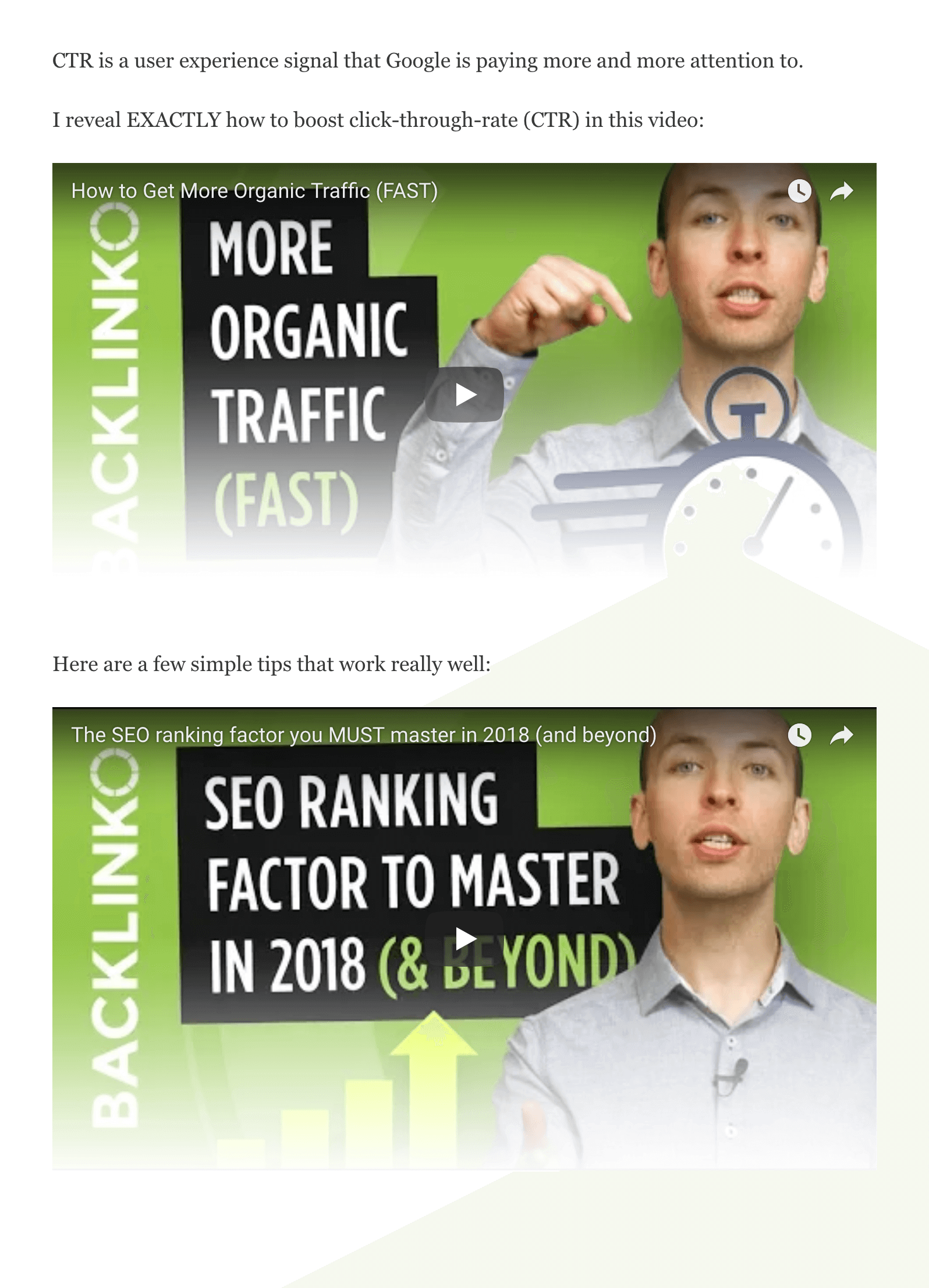
Table of Contents
I added a table of contents to the top of my new post:

And this table of contents got me some sweet sitelinks in the search results:

Needless to say, these sitelinks boosted my organic CTR .
Short Introductions
What’s the first thing someone does when they land on your post?
They read your intro.
In fact, take a look at this heatmap from the Backlinko blog:

As you can see, there’s A LOT of action on the first few lines of my intro:
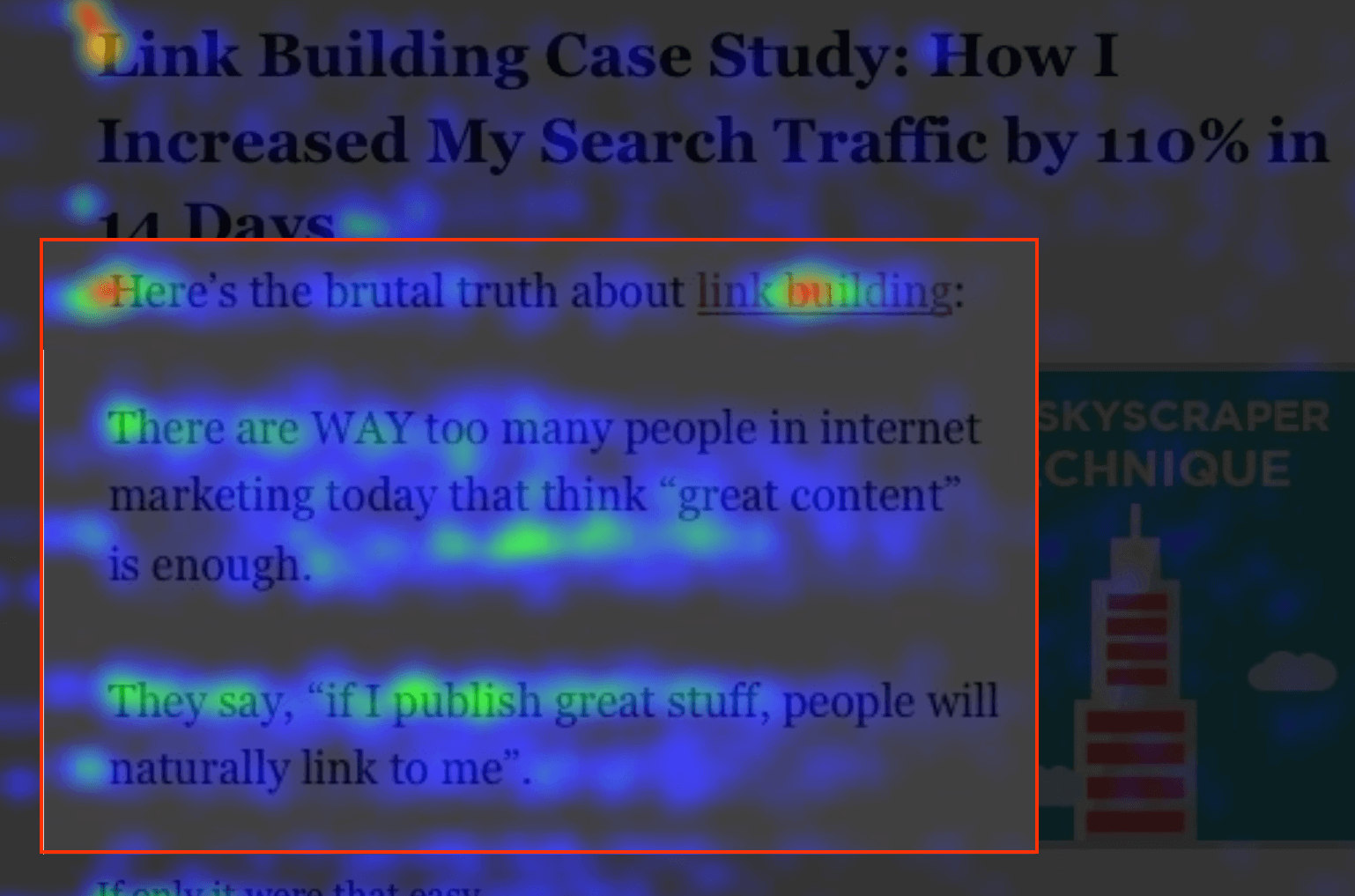
And if you start your post off with a long intro… users are gonna bounce.
That’s why I write short and sweet introductions (5-8 sentences).
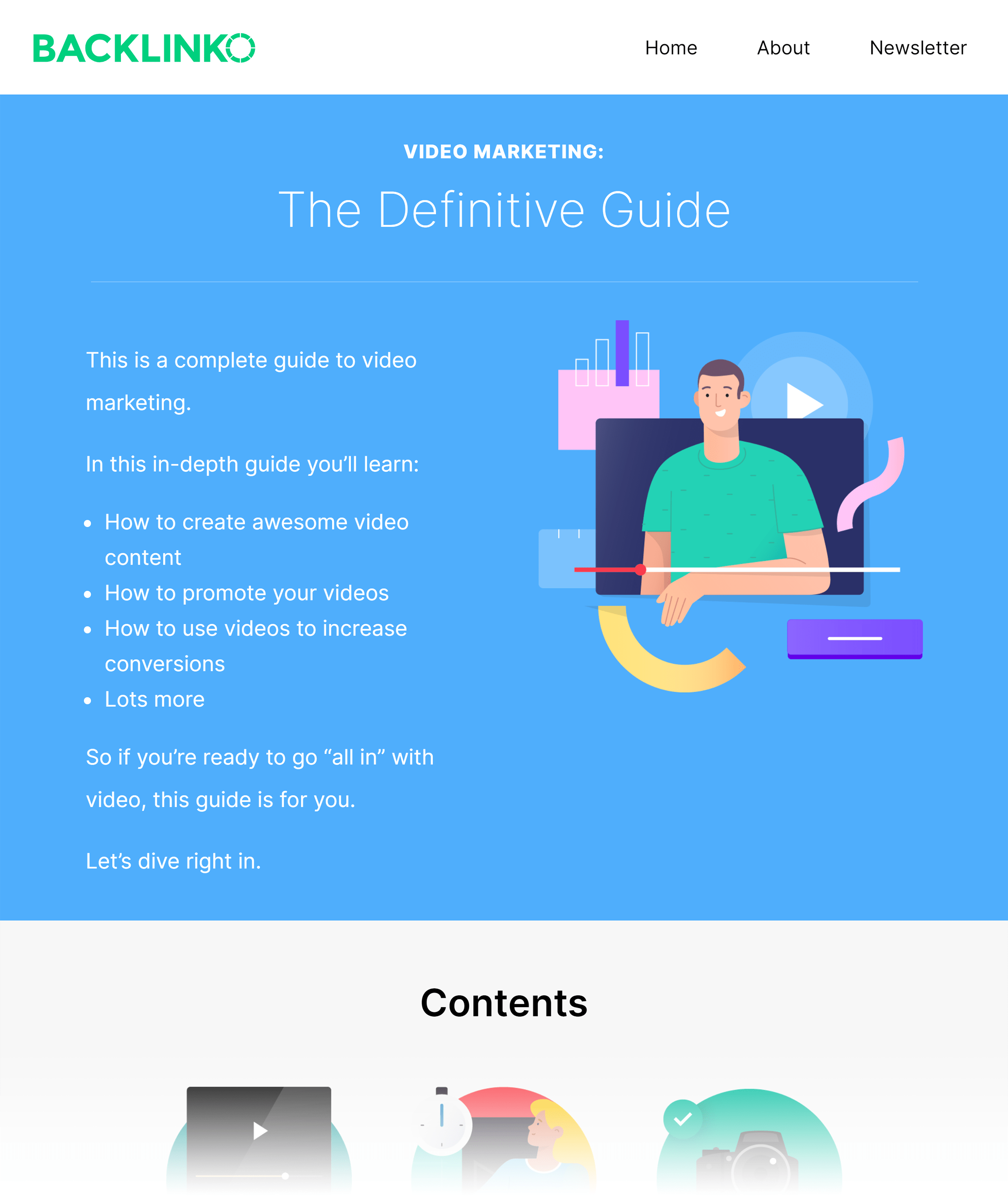
LOTS of Examples
Examples INSTANTLY separate your content from the regurgitated garbage that most people publish.
So don’t be afraid to use tons of examples in every post.
For example:
I included 19 examples in my new SEO checklist post:
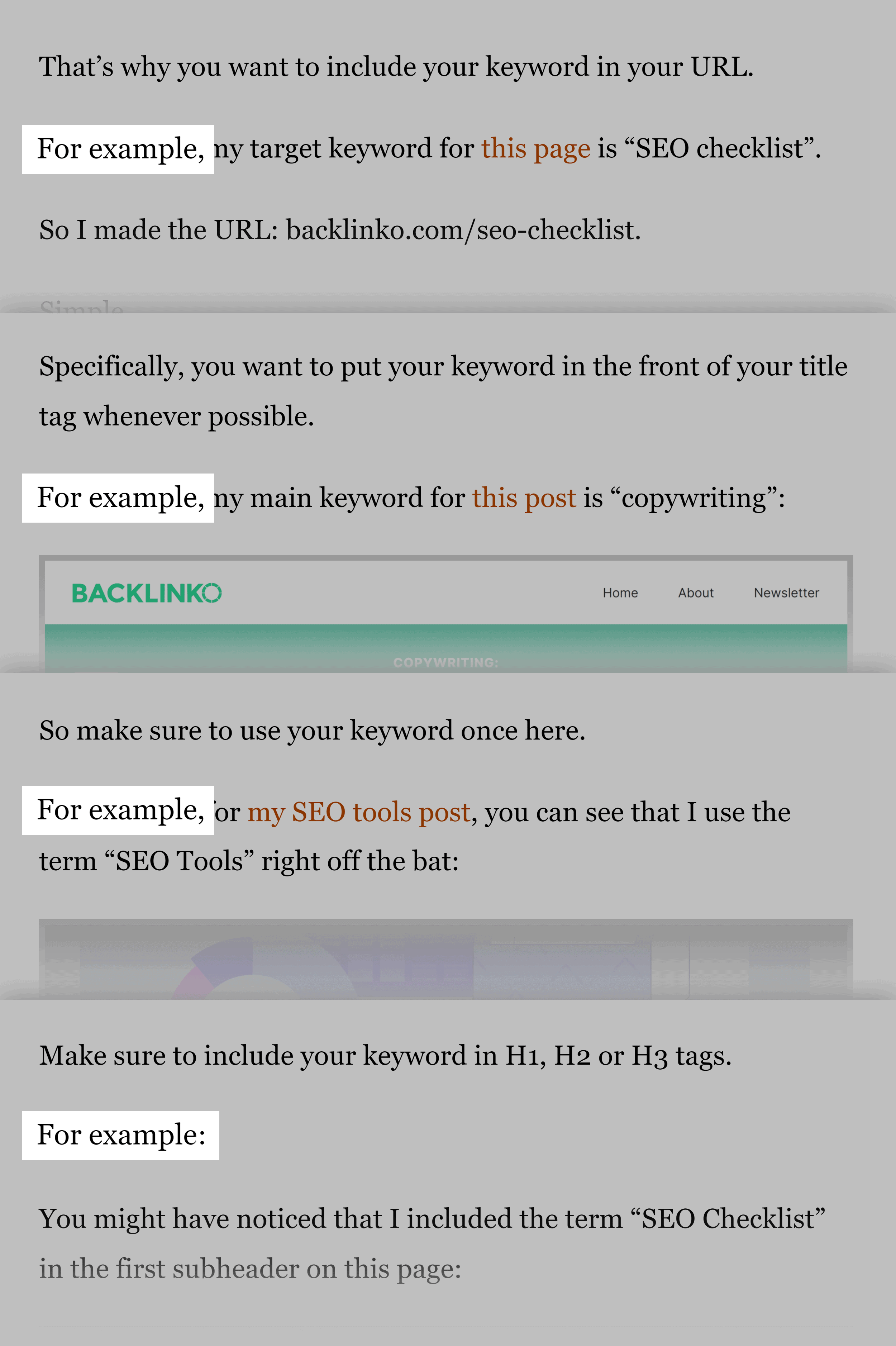
H2 and H3 Subheaders
Subheaders break up your content into chunks:
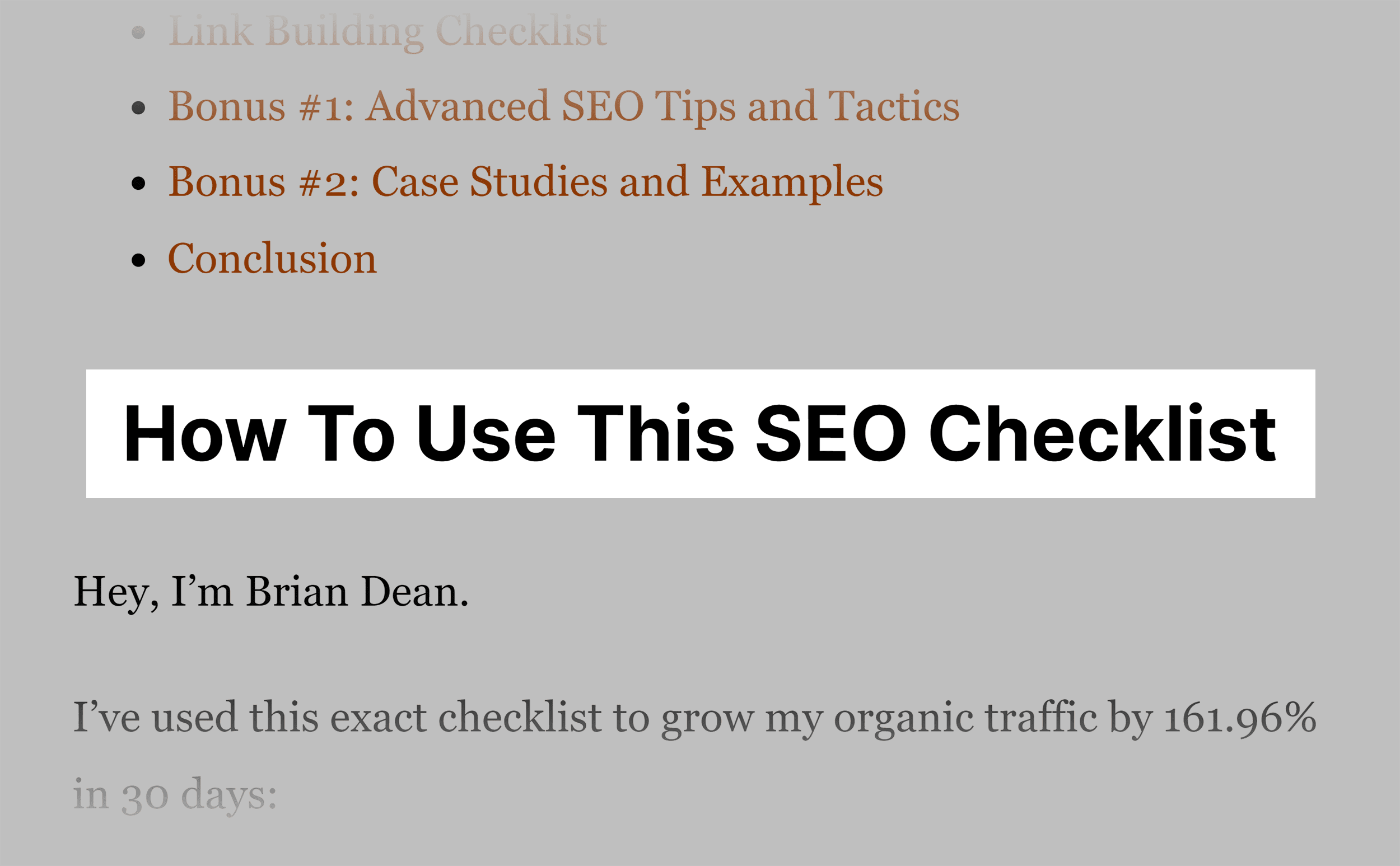
(Which makes your content MUCH easier to read.)
My SEO checklist post had over 9 subheaders:

Short Sentences. Short Paragraphs.
Here’s how to make your content 10x easier to read:
Short sentences. Short paragraphs.
That’s why I write short sentences:
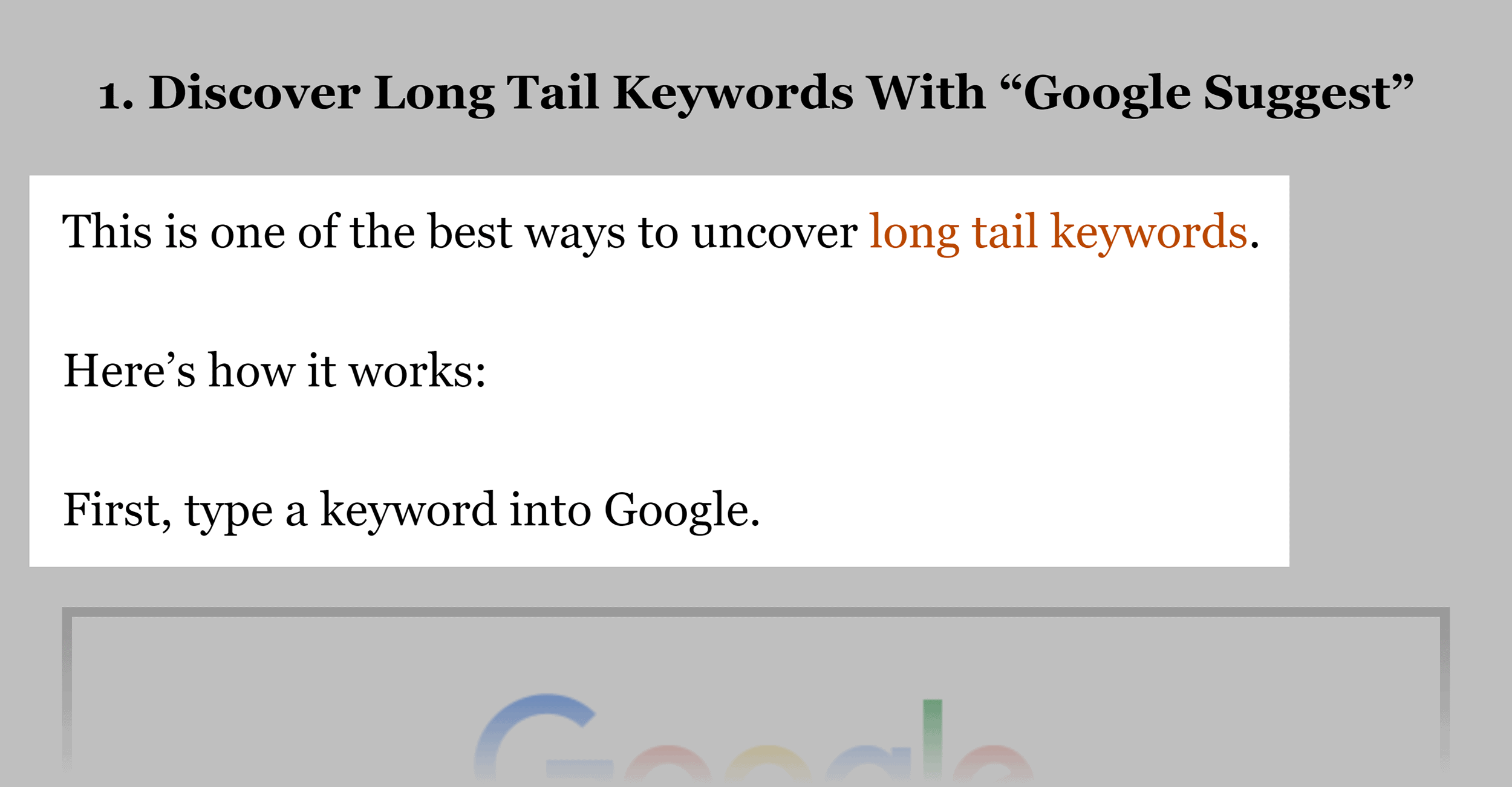
And use 1-2 sentence paragraphs:
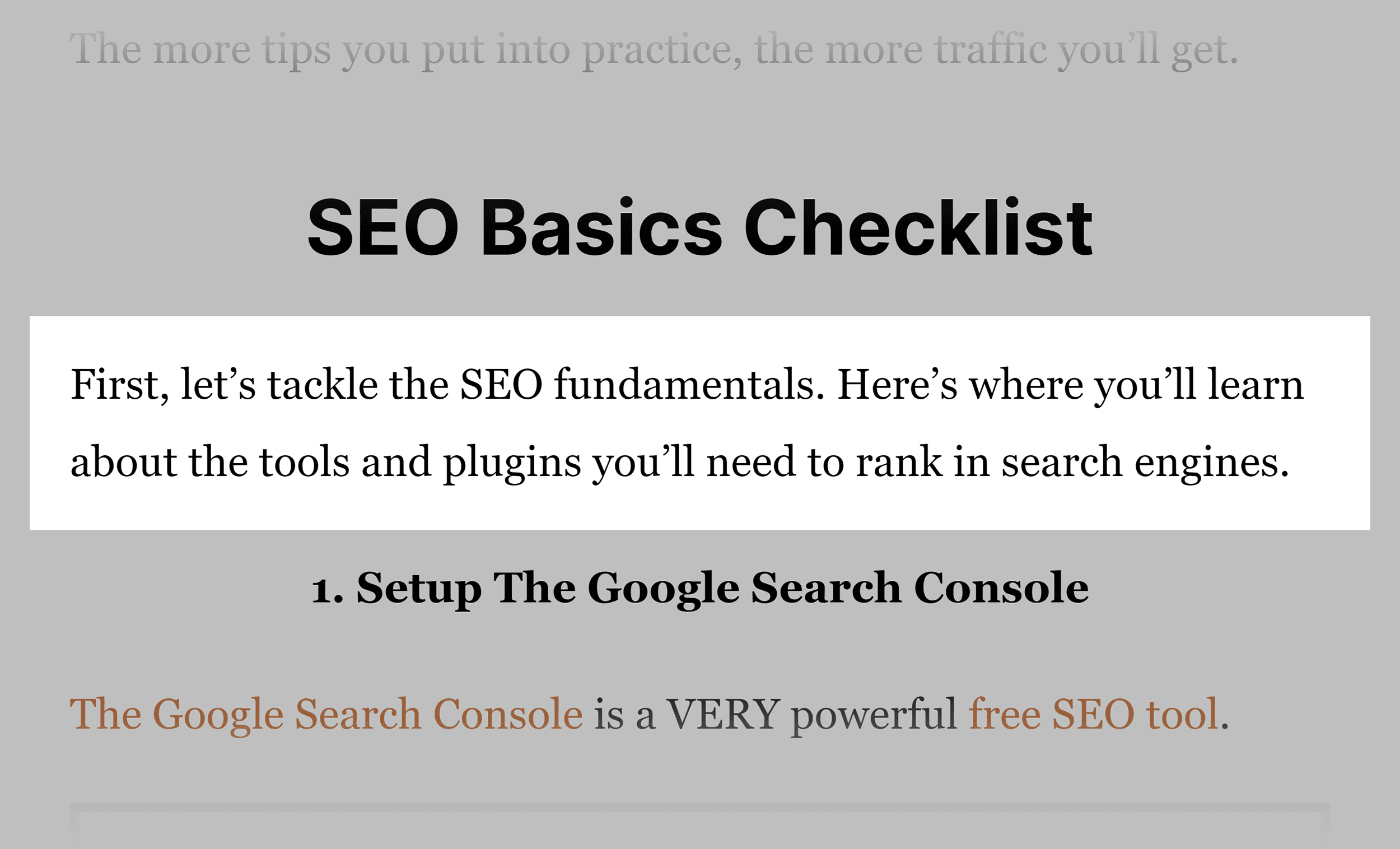
This is a big part of why my post’s average time on page is 5:53:
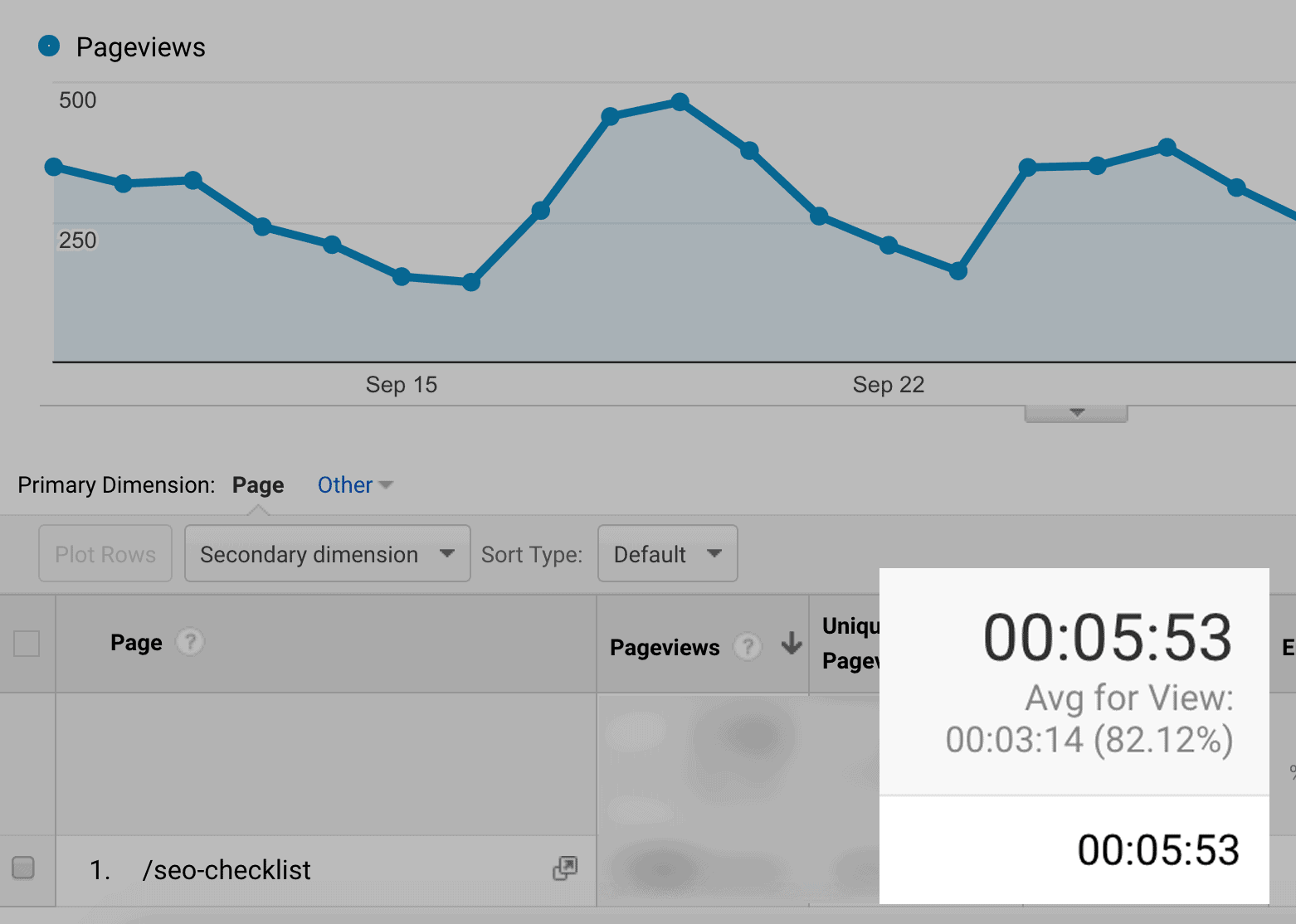
Over To You
Now I’d like to hear from you:
What do you think of this SEO case study?
Maybe you have a question about The Skyscraper Technique 2.0.
Either way, let me know by leaving a comment below right now.
First 🙂 Just Wanna Say That Brian You Rock 🔥 And Happy Halloween Everyone 🎃
Thanks Deep 👍👍👍
Brian i just wanna ask you is that how you create custom pages like Backlinks: The definative guide 2018 post on your blog….Are there any template you use to hire the freelancers to do this work for you ..?
Hi Deep, those guides are all custom designed and coded.
Brian, I have a small request for you why don’t you write about social media traffic generation.?
I’m not a big social media guy
nooooo I didn’t think you could outdo your infamous skyscraper technique but you did!!!
Thanks Austin. I’m not sure I outdid Skyscraper 1.0. But it’s really working well for me right now.
Excellent post for sustainable results.
Thanks Nic. That’s true: my rankings have been super stable on my SEO checklist post since I gave it the Skyscraper 2.0 treatment.
Fantistic Brian, can’t wait to read this article! Thanks again for taking time to put such valuable content together for us!
You’re welcome, Darshana
I can only agree with that. Thanks Brian a lot! Great Posts each time. Have learned so much yet.
Excellent post, Brian. Thanks for the update!
Cheers Calin. The original Skyscraper still works well. But SEO has changed a lot since 2013 (when I first wrote bout The Skyscraper Technique). So it’s good to have a new strategy to use in 2018 and beyond.
you have just nailed it. This article is like never ending with awesome content.
Very interesting Brian. I’m still fascinated by how Google *thinks* it can truly determine user intent. The act of someone coming to a page, quickly skimming or reading it, and then leaving without interacting at all (no sharing, commenting, submitting a form, etc) and certainly without filling out a survey (who the hell has time for surveys!?) does NOT mean that the reader or user was not happy with the result they found. Nevertheless, I guess it’s the best way to guess whether a reader or user was satisfied with what they found.
Thanks Michael.
I agree with you. Google has called those signals “messy”. But they can be pretty conclusive in some cases. For example, if someone visits a page and heads back to the search results and clicks on something else… that is a signal that the first result didn’t satisfy user intent.
(The book “In The Plex” quotes Google employees saying that they use this specific situation in the algorithm)
Fantastic and thorough post as always Brian, thanks for the advice.
You’re welcome, Keith. I try to bring it with every post!
Just saw this in my email haha! I knew its gonna be a bomb..
Awesome new strategy plus great results right here.
I would sure apply the techniques and see how it works….
Google are paying great attention to UX.
Great post once again and have a nice day.
Thanks Noah. I agree: UX signals are becoming more and more important. Let me know how it goes.
Thanks Brian , it is great technique and it is time for us to upgrade!
No problem, Raymond. It’s 2.0 time!
Thanks, Brian for Sharing…. as usual good stuff.
Have been using your tips to improve seo on my website.
Happy Halloween
You’re welcome, Kanuj
As usual, I am impressed with the quality of your content. Thank you Brian for articles like these, as they really help us implement the techniques on our websites! Good luck with your blog.
You’re welcome, Daniel. Happy to help.
Skyscraper 2.0 looks like an SEO CRO (Conversion Rate Optimization) play.
Makes sense- a lot of the technical SEOs I follow speculated that the recent Google algorithm updates (8/1 and 9/27) specifically related to user-intent/user-engagement, on-page factors.
Awesome guide- so Skyscraper 1 is off-page and now Skyscraper 2 is on-page. A good duality.
Thanks Ryan. That’s true: content that matches user intent is also going to help your conversions.
And yes, user interaction signals are HUGE right now. They’re too helpful for Google to ignore.
Well done, Brian! Ignoring user intent was a huge mistake I made with the first posts I published on my new authority site. I recognized that a week ago and now you confirmed with this article that I was getting on the right track. Thanks mate!
You’re welcome, Viktor. You’re definitely on the right track
Amazing content as always Brian! It is a simple thing if you think about, but as you have shown it can have a massive impact on your numbers. I especially agree on short, easy to read paragraphs, it makes such a difference in bounce rate.
Thanks Otto. For sure: readability is one of the most underrated skills in SEO and content marketing. If people can’t read your stuff, it’s not going to do well. Period.
Bro I really dig your work. I have been telling people about “What Is” content (content with an informational bias as opposed to transaction oriented bias) mapping to user intent on highly competitive keywords for a while now, and you hit the nail on the head as usual. Well done.
Thanks man. You’re 1000% right about that.
Brian, it`s f$$#g useful stuff as usual. [went to analyze all my pages…]
God, bless you. and 100000… thank`s.
You’re welcome, Artem
Same here. Now I see serps differently. Just this one article made me capable of finding user intent at an advanced level.
Brian’s topic updates are epic and shouldnt be missed
So as I understand, Skyscraper 2.0 is more of a part B, not necessarily a replacement?
Yes, that’s right Stephen. Both still work well. In fact, I now use both whenever I publish a new post.
Epic post as always, love your blog! It sounds like Google is doing what it should do and that’s giving users what they want and removing sites that are gaming the system.
Thanks Seb! Absolutely: this is the direction Google is going. Whoever delivers the legit BEST result is going to win. And a big part of being “best” is matching user intent better than anyone else.
Hey Brian, I face the same kind of problem. 3-4 month ago my website ranking was in a good position but right now I got lots of downranking. I like the way you describe Skyscraper Technique 2.0 and hope will be back with a good result.
I hope it helps, Ahsan. It’s not a magic bullet, but I’ve seen the Skyscraper Technique 2.0 consistent improve my site’s rankings for some tough keywords.
You’re welcome, Sufyan
Amazing stuff Brian, it’s really indepth analysis and optimization stuff. Definitely it will help to get better rankings in search results.
Keep sharing such wonderful guides.
Glad you liked the new post, Asim
This technique definitely works! I did a case study on Moz earlier in the year with a similar strategy. Across roughly 20 blogs we have gone to page one in most instances, and they stay there.
Overall organic traffic is up 145%.
Well explained.
https://moz.com/blog/influence-googles-ranking-factor
Hey Jeff, Nice! Excellent case study.
Now I figured out why my site is hit with google update. I don’t focus on user intent. I just focus alone on 5000-6000 words post. But thanks Brain for this post. You really is a genius.
Thanks Sachin.
Awesome Strategy Brian !!!
Thanks Anant. 👍👍👍
Hey Brian Great Information. My websites one post was losing visitors last month. My post was taken down from page1 to page2 by google. At that time I really got confused. Then I figured out that my article was not matching user intent query. My article talks about some different topic that a user doesn’t want to read. My bounce rate was high.
Then I optimize my post for user intent by figuring out other websites. Now that post ranks in Top 5 Page of Google. But I want a no1 position and I know how to do that after reading your article. Your post covers all the factors needed for matching user intent. I will definitely give it a shot.
Cheers Jatin Thakur
Awesome Jatin! Let me know how it goes. 👍👍👍
Great article as always! Are you planning to write more about user intent?
Thanks! I tried to cover user intent pretty thoroughly in this post. Is there something I missed?
This is great detail valuable information. I will certainly follow these steps to launch something in the future.
Sounds good, Jitender
Great post as always. Skyscraper techniques are great but getting backlinks in 2018 is getting really tough. Could a site rank in the first page just by using good content without backlinks?
Thanks Maher. You still definitely need links. Links are still super important.
Fantastic as usual! Backlinko is a diamond among dirt and will be my top go-to resource for current SEO trends as long as you’re cranking out the knowledge! Thanks Brian!
Thanks Jason. I’ll keep cranking it out as long as people keep reading 🙂
Reverse engineering eats all.
Pretty much, yeah.
Checklisty! You, sir, are a wordsmith.
Great read as always!
HA! Glad you enjoyed the post, Gregory.
That fantastic, crazy Canadian genius Marshall McLuhan said “the medium is the message” and I love how you consistently, methodically break down what that means for online search.
Thanks Marc!
Yes! This concurs with my experience. I have more authority backlinks, better content but still I get outranked on some keywords. For me it also seems like Google has made a huge shift in the last months toward more user intent and user behaviour.
I am thinking about maybe adding a small non intrusive form on specific pages to ask what visitors are looking for on that specific page.
Also what metric do you think is best to a/b test for? Bounce rate, avg time or amount of visited pages? I would think avg time on page.
Hey Koen, I haven’t tested a lot of interactive stuff (besides videos), but a form could help. Either way, I’d definitely study the first page and see what the user intent is for that particular term. To answer your question: I focus on avg time on page.
Great stuff, Brian. Backlinks definitely help improve rankings, but only if the content matches the searcher intent. I’ve had some of my content rank well with few or zero backlinks by keeping the content as my main focus. Although recently, backlinks seem to be used as a trust signal more heavily since the medic update. What are your thoughts on this?
Thanks for writing this. I’ll definitely be referring to it again in the future!
Thanks Nick. Glad you enjoyed it.
To answer your question: I’m still making sense of exactly what Google was doing with the Medic update. There’s no doubt in my mind that trust was a big part of it. But it’s hard to see if it’s links based or based on other on-site trust signals.
Another awesome article!! i will start to testing some of these examples.
Sounds good. Let me know how it goes, Milad.
In our industry, there are usually two groups of opposing searchers landing on our pages. Landlords and Tenants.
This means intent is very different for the person landing on the page and I try and appeal to both people in the intro copy.
Especially because there are 10 tenants for every 1 landlord.
Our product is geared towards landlords but if the copy appeals to landlords AND tenants it will improve our position over time meaning more landlords will see it.
It’s a rising tide raises all boats type of situation.
It’s good to think about who else might be landing on the page and not just your target demographic.
When we refresh content we keep this in mind now.
Great article Brian… thanks for sharing.
Sounds good, Eric. In that situation I think what you’re doing is smart: trying to appeal to both groups as much as you can. You’re 100% on the right track already.
Good to know Brian. Your content is super helpful for staying on track. The CTR case studies On the GSC guide are great.
After reading that guide I realized how many tenants were landing on our content and started speaking Moreno to both sides. Thanks!
Awesome post. Focusing on UX is very important nowadays which many people don’t do.
Thanks for sharing these tips. 🙂
You’re welcome. I honestly can’t blame them. In the old days of SEO, UX didn’t make much of a difference. But today it’s HUGE
Thank you Brian. I loved the Post, Simply Amazing. I want to apply the tips now and validate the results!
Sounds good, Fernando. Keep me posted on how things go.
Thanks, Boss! No doubt about your strategy and all of the techniques.
Very soon I’ll apply this.
Have a good day.
You’re welcome, Utpal
You’re such an inspiration, thanks for the great work, Brian! Btw, I just finished SEO that Works: I LOVED it! Keep up the great work, buddy!
Thanks Ivan. I really appreciate that. And congrats! 👍👍👍
As always an awesome and comprehensive guide. I was always wondering which plugin do you use for table of contents?
Thanks Vytas. We actually set those up manually using jump links.
That is a fascinating post and really well explained.
Cheers Steve. Glad you liked today’s post
Excellent post as ever, super easy to follow and as always, actionable tips. Thanks Brian
You’re welcome, Gordon. I HATE “high-level” SEO content. SO I try to keep everything super actionable.
Thanks a lot, Brain Dean, I really love reading your blogs, and when I implement this skyscraper technique it improves my blog ranking to 120%.
You’re welcome, Michael. I hope Skyscraper Technique 2.0 also helps you get more organic traffic
I was waiting for your new research. The new skyscaper technique is really amazing. “Step 2: User Intent” is more important for 2018 SEO. I will use the technique. Thanks for coming with the new once.
Thanks Razu
This post is great but I feel you can’t make trademark on this technique.
It is usually obvious to most SEOs and isn’t revolutionary like first Skyscraper technique. I am not saying it bad, it is good but I still think that it isn’t mind blowing like you previously did with post. Sorry if I criticize but I just want to say what I feel.
All good, Cris. Thanks for your feedback.
Hey Brian, I really like all of your blogs and YouTube videos. I watched them over 20 times so far. It really helped me understand SEO in general and also in depth. I appreciate you sharing what you’ve researched! I get super excited whenever I see your email because I just know that I will learn from you. I am waiting to see your upcoming YouTube videos as well!
Thanks again for sharing this awesome content. -Sandy
You’re welcome, Sandy. I actually do have a few videos in the works. See you on YouTube!
AWESOME! I’m so excited to see your upcoming videos! I know you are really busy, but as I was working on growing my channel, I have one question for you.
You know how Instagram only allows up to approximately 30 tags? I was wondering how many tags we can use for YouTube. I want to get discovered my many people out there and was using the same technique as you taught, which is using the exact same tag as competitors, but it didn’t help me to discover on “related video”
Also, vidiq suggests having at least 400 tag characters.
I know you are busy but I wanted to hear from your opinion since you are the SEO king! haha
Thanks Brian.
Sandy, I go into using tags right here: https://backlinko.com/hub/youtube/tags
It’ll explain it better than I could in a comment.
This is really interesting. It seems like long-form content (skyscraper 1.0) is not enough. We need to optimize even more to get better results !
In my experience, Skyscraper 1.0 is usually enough. But not always. For times when 1.0 isn’t enough, 2.0 comes in handy
Leave a Comment
Case Study: 111x Traffic in 4 Months
Join the 1,000+ brands that trust us for their link building.
When I checked Ahrefs to see how this site was doing the day after Christmas (one can only handle so much family time after all), I honestly thought that the traffic graph was bugging out.
It was showing a line going straight up to a level of traffic that just seemed impossible for the site at that point in time given its rankings a few days before.
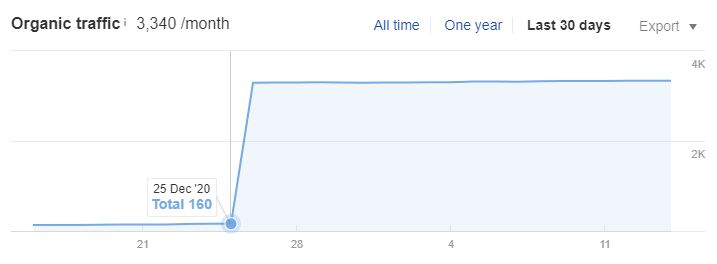
Upon further inspection, it turned out Santa had one last present for me. The site’s main keyword had jumped from #7 to #1 overnight, resulting in a 2,000% increase in traffic. Four months of link building had paid off in spades.
And no, a 301-redirect was NOT used.
Apparently, SEO and link building fundamentals are still being rewarded by Google with much more than just coal.
What is Covered in This Case Study:
Off-Page SEO Analysis Link Building Strategy Link Building Execution Backlink and Anchor Diversity Leveraging the Power of an EMD
What is NOT Covered:
301-Redirects On-page SEO Technical SEO Keyword Research or Content Strategy Monetization, CRO, etc.
Site Background
First things first: this was not our website – it was a client’s site.
This means that we were only building links for the site. All other aspects of SEO were taken care of by the client themselves.
We will touch on a few of these aspects briefly, but the bulk of this SEO case study will focus on link building. Not much was done to the site except for adding backlinks during the 4 months covered in this case study.
As it was a client’s site, we will also not be showing any identifying information (we probably wouldn’t want to show this if it were our own site, either!). Sorry, but privacy and security always come first.
The site is in the business/government niches.
Ahrefs rates the competition for their main keyword as hard.

Ahrefs estimated that we’d need over 200 Referring Domains (individual websites linking to us, not links overall) to rank on the first page.
Here is an overview of the metrics of the sites on page 1 for this keyword:
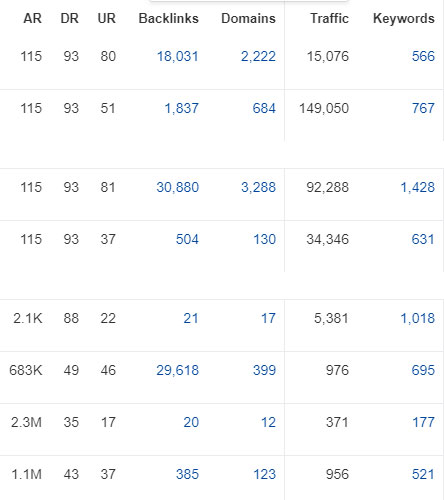
You can see that a couple of the top rankers have thousands of RD, and there was also a government site taking up 3 of the higher positions.
However, the site we were working with was an EMD – Exact Match Domain. This means that all of the site’s main keyword was included in the domain name. This would give us an advantage as well as the site being more focused on the keyword overall than some of the top rankers.
Initial SEO and Off-Page Analysis
When the client first applied for the site to be in our Managed Link Building Program, we conducted an analysis of its current health and previous SEO efforts just like you would do with any new domain or site you had purchased.
We found the following:
- It was a small, niche site with only about 15 pages indexed in Google.
- Its on-page was well done. Nothing fancy – they had just put keywords where they needed to be without going overboard.
- The content was high-quality.
- It was a somewhat new site with its first links showing up about 9 months before. It was currently at about 26 Referring Domains.
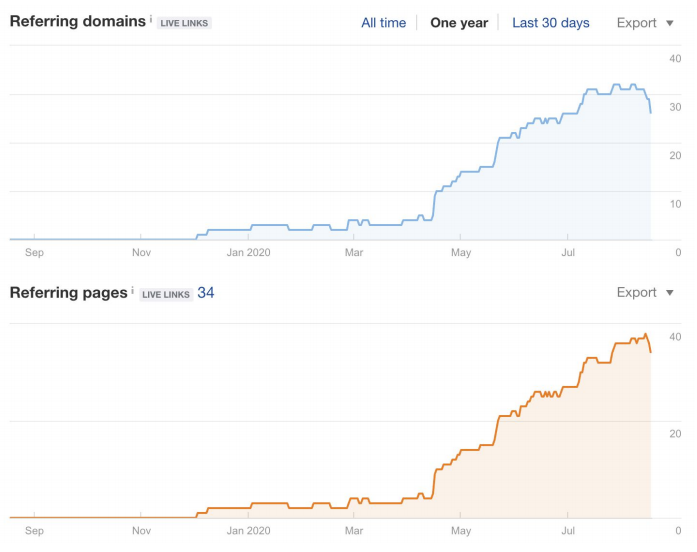
- Its Domain Rating was quite low at 1.7, but that was expected from a website with only 26 Referring Domains. Ahrefs was also showing that the site was currently ranking for about 325 keywords which wasn’t too shabby.

- The keywords and traffic were both trending positively which is a good sign of site health. The site was establishing trust with Google, and Google was allowing it to begin ranking for a variety of keywords.
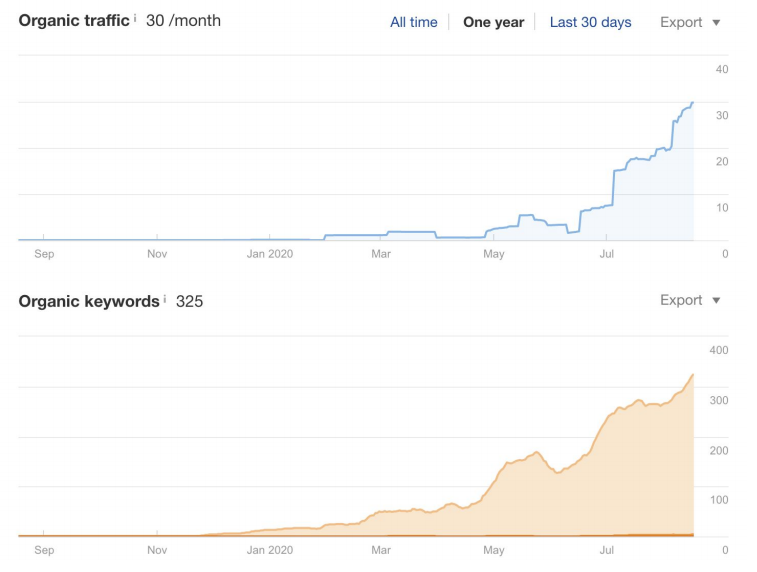
- The backlinks that the site already had were pretty clean for the most part. The backlink profile consisted mainly of some simple, white hat links like directories. They also had a few guest posts and PBN links. The links were pretty relevant overall.
- The anchor text used previously was a little bit more aggressive than we like to see with sites at this stage with a good amount of money anchors. The fact that the site was an EMD would at least help to manage this to some extent.
- The site was at least starting to pop up for a lot of its target keywords, however, they were not in good positions at the moment. The site’s main keyword was ranking on page 6.
- Most of the existing backlinks were going to the homepage – good.
All in all, it was a good-looking, well-written niche site with clean on-page and a pretty clean backlink profile at the beginning of its ranking journey.
The anchor text was slightly over-optimized given its current RD count, however, it was establishing trust with Google and steadily growing its keywords and rankings… and you can’t really complain about that.
We love seeing sites like this in the MLB program as they are clean, focused, and haven’t created any obstacles for themselves such as messy on-page or a spammy, super-aggressive link profile.
Our Proposed Link Building Strategy
We wanted to begin pretty conservatively by building links mainly to the homepage with natural anchors as the site was still at the beginning of its link building journey and was only starting to slowly build trust with Google.
If this were our website, we might have been a little more aggressive. However, with client sites, we always follow linking best practices.
Building to the homepage with natural anchors would take care of the slight over-optimization problem, continue building authority to the site, and lay the foundation for more aggressive link building in the future after additional trust had been built.
As the site was an EMD (Exact Match Domain), building URL and branded anchors to the homepage would be similar to building money anchors – but without the risk. So, we planned on using a good amount of these anchor types to leverage this advantage.
We also planned on doing a little more pillow linking with simple, foundational, white-hat link types in the beginning just to be really sure of a solid, diversified link profile to start building on top of. This would also help with anchor diversification.
After the initial stages, our main tools would be guest posts, niche edits, and maybe a PBN or two. We would vary the authority levels (as this is what occurs naturally) while still using high-authority links to push hard. All links would be relevant .
We would become more aggressive over time in our anchor selection as well as our target selection (meaning we’d start hitting more inner pages and use more non-URL money anchors).
And as always, we would re-analyze the site at the beginning of each month to ensure our building was based on how the site was currently reacting. If the site needed some additional pillowing or anchor dilution at some point, we would have to revert back to that.
About the Backlinks We Used
Links were “ordered” at the beginning of each month and finished sporadically throughout the month, but in many cases, links did not finish building until the end of the month.
This in conjunction with the fact that links can take some time to index and show their effects makes it a little hard to attribute the results analyzed at the end of each month to a particular order of links.
Our teams built all of the backlinks used for this case study, and they can be purchased on our site. You can build these types of backlinks yourself if you have the time, teams, and know-how, or you can also purchase similar links elsewhere from quality, trusted vendors.
I will include brief descriptions of link types/packages used to better illustrate our building decisions, however, if you are unfamiliar with some types of backlinks, you can find more information here .
The overall spend during the full 4-month period was about $5,000. The client was also changing their budget every month, so you will notice some months with heavier building than others. This was the client’s decision, not ours.
The analysis that the first month of link building was based on was outlined previously (initial analysis as part of the application into the MLB Program).
The general idea for this first month of link building was to do some additional pillowing and naturalness-building. Then, we’d start pushing relevance and authority with natural anchors.
All links would be built to the homepage as the site was still quite early along in the link building process, and the client wanted to rank for its main keyword on the homepage.
The link building budget for this month was $700. Here was the order:

The pillow links pack is a pack of 30 white-hat links that most people can create themselves such as citations, niche directories, web 2.0’s, and forum/social profiles. We like to use these on newer sites or sites that just need to diversify a bit.
This only took a small portion of the budget and was used to diversify the link/anchor profile (only branded, URL, and generic anchors were used).
The social signals pack (links, likes, and shares of your content on social media) was very cheap as well and was used to simulate buzz across social media.
The majority of the budget for this order was used on a niche edits pack and a guest post.
The “Level 5” niche edits pack is a higher authority pack, and it contains 3 links from relevant domains with 800-1,200 referring domains of their own. The guest post was a mid-authority post from a domain with 20-35 DR.
These two things are what would do most of the heavy lifting by pushing a good amount of authority and relevance. The niche edits pushed more authority while the guest post was able to supply more laser-focused relevance due to higher control over the article.
After the first month of building, the client was very happy to see their main keyword jump from page 6 to #11, right on the border to page 1. They even sent us this screenshot:
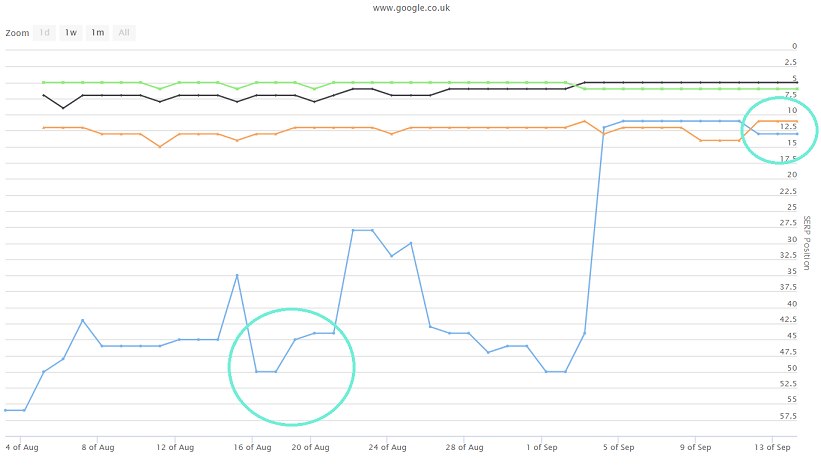
And here’s what the site looked like in Ahrefs:
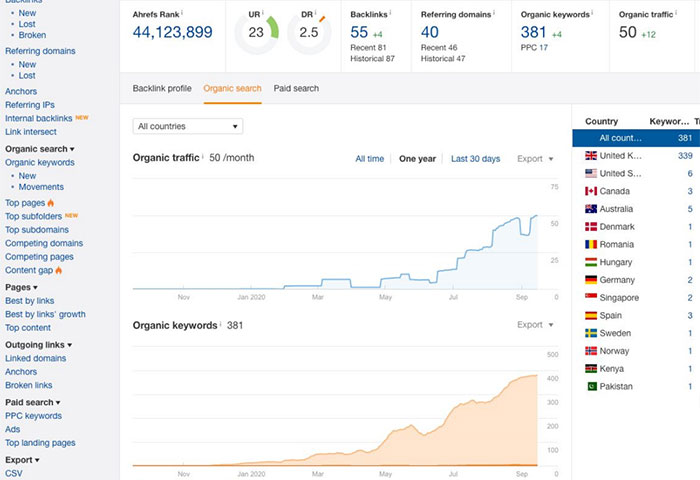
The site was looking nice and healthy. It had almost doubled its traffic (which was still very low) and was starting to rank for about 20% more keywords. Trust with Google was building, and it was clear Google knew what the site was about and what to rank it for.
Based on this information, the general idea for the second month’s link building plan was to continue hammering authority and relevance to the homepage. We liked how the site responded in the first month, and we wanted to continue this trend.
The budget for this month was $1,000. Here was the order:

The total link amount for this order was smaller than the first month, however, you can see it’s a lot more authority as none of the budget was used for pillowing (the client also slightly increased their budget).
Another “Level 5” niche edits pack was used (3 links from domains with 800-1200 RD), and three guest posts with higher authority than the previous month were used as well.
This was a nice balance of authority and relevance while keeping the link profile diverse – the individual signatures of guest posts and niche edits are slightly different (one is new, one is aged), so it’s nice to use them both to avoid too much uniformity.
We also continued to leverage the advantage of the EMD by using a lot of branded and URL anchors to try to boost the rankings for their main keyword as much as possible.
The results after the second month were not as breathtaking as the first month’s results, but progress was still being made.
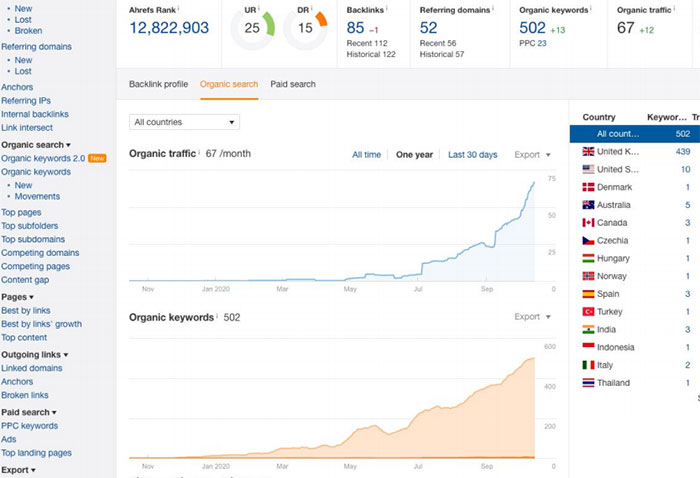
We were still dealing with low levels of traffic and keywords, but they were growing nicely. Traffic was up about 35% and keywords were up about 32% from the previous month.
Here’s what the keyword tracker looked like for a few of the main keywords:

You can see that a few of the terms were bouncing in and out of page 1, and overall they were just showing a lot of volatility. Nothing had settled on page 1 to stay at this point.
Normally volatility is not something people are happy about. But with link building, volatility usually always comes before more positive movements. You often see big losses before your largest gains. In this case, it was more so just bouncing back and forth.
We were convinced we were on the right track. However, the client was a little worried that something may be wrong – why had there not been gains as massive as the first month?
Being experienced SEOs, we knew that the real fight was going to begin here at the edge of page 1. This is where you begin to run up against a brick wall of authority and sites with sizeable backlink profiles.
So, we knew at this point we just needed to accumulate authority. The #10 ranking site (last position on page 1) still had 123 RD compared to our 50 RD that Ahrefs was showing, or about 2.5x the amount of referring domains.
Could we beat them with less?
The general plan for this month of link building was to continue pushing authority to the homepage but to mix things up a bit to keep the backlink profile looking natural.
The backlink budget for this month was $1,500. Here was the order:

We decided to go heavier on niche edits this month instead of guest posts due to their cost effectiveness with pushing authority, but really we could have gone with guest posts here and heavier on edits the following month as well.
We used a Level 6 pack which is the highest authority niche edits pack we provide. Linking domains have 1,200+ RD (and sometimes much more). We also used another Level 5 pack (800-1,200 RD) as well as a lower authority Level 2 pack (100-200 RD).
This month, we also used the only PBN link that would be used throughout the entire process. As you probably know, PBNs push a ton of power and using one also mixed up the link profile a bit by throwing a homepage backlink into the mix. Diversity is always good, and the site had accumulated more than enough RD at this point for a PBN to be used safely.
Social signals were used again to add an extra layer of naturalness and simulate buzz on social media – but again, these make up an extremely small portion of the budget.
We continued to push all links to the homepage with natural anchors, but we mixed up the anchors this time around with less branded/URL anchors and more long-tail, generic, and geo-relevant anchors.
We expected the results from the third month of building to be pretty mediocre. After all, it was just a matter of closing the authority/link gap to be able to compete more seriously with some of the sites on page 1. And that would take time.
And we were right! Here’s where the site landed after the 3rd month:
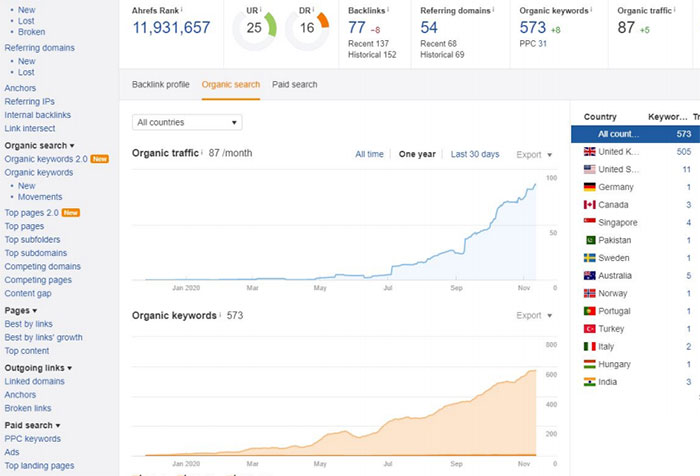
The traffic and keywords continued to grow, but they were still at pretty low numbers. This was a relatively small niche site after all, and nothing had really landed on page 1 to push these numbers higher yet.
Traffic was up about 30% from the previous month or about 300% since we started building links to the site.
Keywords were up about 15% from last month or about 76% from when we started.
The overall plan for the fourth month of building was to continue pushing authority to the homepage to try to close the authority gap while switching up the types of links used.
We’d also add a higher number of cheaper links to help diversify the anchor profile as we had been building a pretty fair amount of URL/branded anchors.
The budget for links this month was $2,000 (we had a 25% off special this month, so the total was more like $2,500). Here was the order:
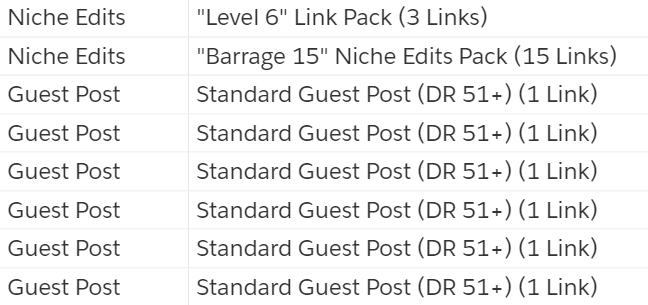
The majority of the budget this round went towards the highest authority guest posts we have. We made use of strong anchors with these links to make the most use of them.
We used another high authority niche edits pack as well (Level 6, 1,200+ RD). We sent these to a few inner pages for the first time since building to push a few new terms with money anchors and a variation.
The remainder of the links were from a Barrage niche edits pack which contains a large amount (15-20) of lower authority links (10-50 RD per domain).
We love using these links to diversify anchors as they are cheaper – you usually don’t want to diversify with expensive links as they are more for maintenance. We added in a bunch of much-needed generic and branded variation anchors to make things look more natural.
Wait, what? Wasn’t the keyword supposed to hit #1 after 4 months?
Here’s what things looked like after the 4th month:
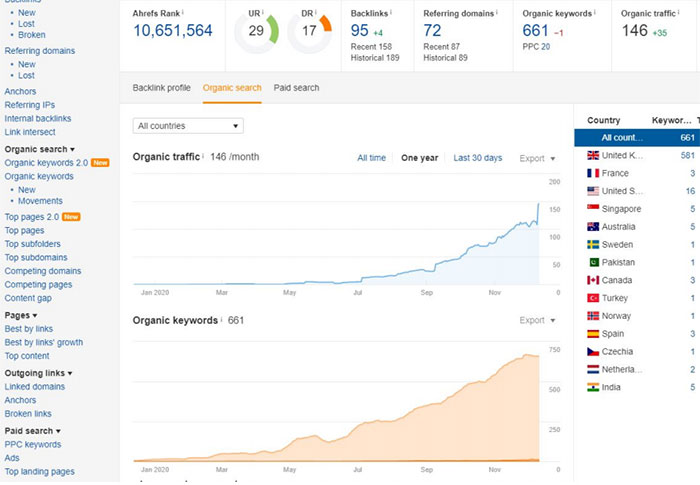
You can see a large spike in traffic in Ahrefs which is the main keyword landing on page 1 and staying there without bouncing back off. Traffic had almost doubled again, and keywords were up another 15% from the previous month.
It was a nice win to finally get the main keyword on page 1 for good, and we kept marching forward with building backlinks.
However, I’ll leave that off of this case study because before any of those links could be finished, the rankings jumped to #1 for the main keyword.
Here’s what that looked like:
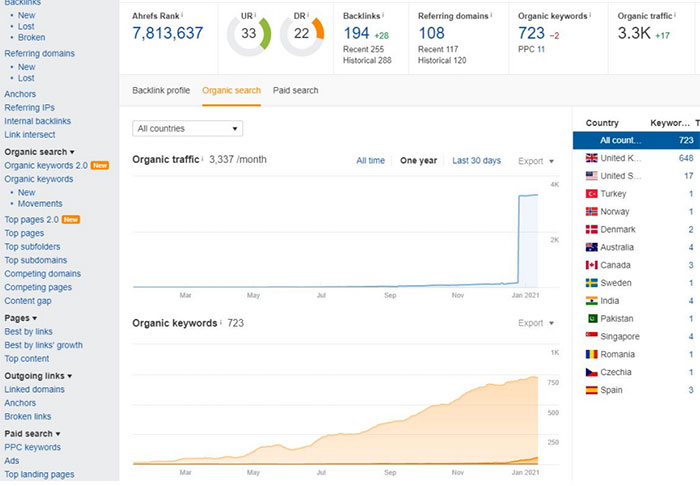
The main keyword jumping to #1 as well as the big gains in other keywords at the same time resulted in an overnight traffic increase of about 2,000% (160 to 3,337), or an 11,000% (30 to 3,337) increase since we started building 4 months prior.
The number of keywords the site was ranking for was also double from where we started.
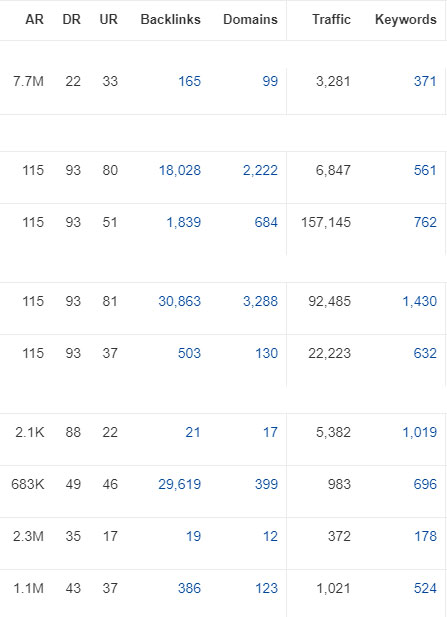
That’s us at the top now. Note the smaller amount of links, RD, and authority over all the site has in comparison to the other top rankers!
Final Thoughts
It’s been almost a month now since this development, and the main keyword still holds the number 1 position with no sign of dropping.
But that is just one keyword. There is still a ton of untapped traffic to go after.
We continue to build links focused on raising the rankings for other important keywords to bring in additional targeted traffic to the site. The site owner is also dusting off their blog and starting to add more fresh content that can also be ranked.
So, what have we learned from this?
Link building remains an incredibly powerful tool
When executed correctly, you can beat out sites with a lot more links than you, and you don’t NEED a massive amount of PBN links to get the job done (although they sure can help!). Different strokes for different folks.
Diversity is key
This goes for both link types and anchor text. Following the principle of diversity ensures your backlink profile and anchor profile emulate that of 100% natural profiles. This keeps you safe and away from penalties.
EMD’s are still very powerful
While we normally stay away from them ourselves, they can still be used to snipe competitive terms much more efficiently. Building a lot of branded and URL anchors to these domains makes the most use of them.
Authority acts as a wall, but you may be able to jump over it.
Smart use of relevance, anchors, link types, domains, on-page, and so on can let you bypass massive amounts of authority with fewer links than you might think.
Relevance, relevance, relevance
While not every link needs to be laser-focused as far as relevance is concerned, you should aim for most of them to be relevant at least at the parent-niche level.
At the end of the day, most of the tactics we used here really fall under link building fundamentals and best practices. We didn’t use any crazy new strategy or ultra-black-hat tactics, and in most cases, you don’t need to.
If these concepts and methods aren’t already part of your game plan, they should be for the sake of your wallet, your rankings, and your sites’ health.
To learn more of our SEO tactics, check out Nick’s affiliate marketing case study next!
And if you have any questions or comments, leave them below!

Hey I'm Chris, one of the founders here at SirLinksalot. I'm into building internet money machines (affiliate websites) and specialize in building backlinks. Find out more about me and my link building team .

We are active in our Facebook Group seven days a week and would love to hear from you. Ask us questions, learn from other group members, and share your knowledge.
Join the discussion on Facebook →
Related Posts
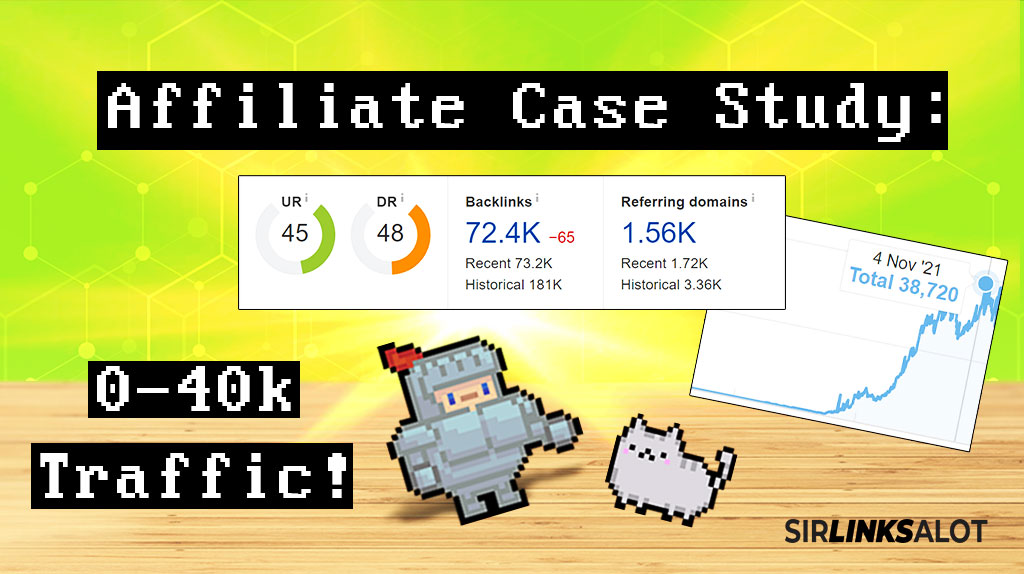
Affiliate SEO Case Study – From 0 to 40,000 Traffic

Case Study: Recovering From Bad Links
No results found.
The page you requested could not be found. Try refining your search, or use the navigation above to locate the post.
Ready To Start Building Your Rankings ?
Your link building journey to the top of Google starts today!
Apply for Managed Link Building to get a free analysis and game plan, or order backlinks a la carte.
- All agencies in the UK
- Bournemouth
- All services in the UK
- All industries in the UK

- All agencies in Canada
- All services in Canada
- Influencer Marketing
- All industries in Canada
- Travel Tourism

- All agencies in Australia
- All services in Australia
- PPC Marketing
- All industries in Australia
- Beauty & Cosmetics
- Hospitality

- All agencies in Europe
- All services in Europe
- Web Development
- All industries in Europe
- IT & Technology

- All agencies in Asia
- All services in Asia
- B2B Marketing
- All industries in Asia

- Agency News
- Marketing Resources
- Industry News

- Digital Ad Campaigns
- Case Studies
- Social Media Campaigns

- Marketing Blog
- Advertising
- Ecommerce Marketing

- Industrial Blog
- Fashion Marketing
- Sports Marketing
- Luxury Marketing
- Legal Marketing
- Healthcare Marketing

- Digital Marketing Tools
- Marketing Reporting Tools
- Digital Marketing Analytics Tools
- Email Marketing Tools
- Other Tools
- Social Media Management Tools
- Social Media Marketing Tools
- Social Media Analytics Tools
- Social Media Monitoring Tools
- Influencer Marketing Platforms
- Web Design Tools
- Landing Page Builders
- UI / UX Design Tools
- Website Builder Software
- Front End Development Tools
- Team Management Softw...
- Project Management Tools
- Agency Management Software
- Productivity Management Software
- Time Tracking Tools
- Sales Tools
- Sales Automation Tools
- Product Feed Management Tools
- Sales Enablement Tools
- AI Design Tools
- AI Content Tools
- AI Analytics Tools
- AI Marketing Tools
- Performance & Software
- Website Optimization Tools
- Content Delivery Network Tools
- Cybersecurity Software
- Web Accessibility Tools
Market your SaaS Tools and reach digital agencies & marketing professionals worldwide.
- All Categories in USA
- Artificial Intelligence Events
- Design & Development Events
- Digital Marketing Conferences
- Social Media Events

GYDA Summit 2024

Social Media Week 2024
Submit your exclusive marketing event today.
Submit your event to reach a wider audience! Whether it's digital marketing, AI, or any related theme, we would love to help spread the word out!
- All Categories in UK
- All Categories in Canada
- All Categories in Australia
- All Categories in Europe
- All Categories in Asia

Inspiring Link Building Case Studies With Actionable Strategies for 2022
When people think of SEO, the first thought that pops into one’s mind is keyword optimization. While there is no doubt that the element is an integral part of SEO, it is not everything that matters. Another important factor is link building. In this article, we will explain link building case studies with actionable strategies for 2022.
In fact, according to Social Media Today, quality links are among the top-ranking factor of the Google algorithm. Yet, over 94 percent of the content online gets zero links!
Why does link building matter? Well, the more links your content has, the more authoritative and credible it is in the eyes of Google. This is why merely getting links is not important. Instead, you must strive to attract quality links so that you can leverage their credibility.
When it comes to building links, there is an array of strategies you can implement to best improve your chances of attaining backlinks. To understand the importance of each strategy, studying a relevant case study can be handy.
Here are some of the most successful case studies of link building that you can surely draw lessons out of.
Case Study #1: David Farkas’s Experimental Adventure
Rather than believing the link building case studies already shared by the various experts, David Farkas set out to gauge the effectiveness of link building via creating a website within the health niche.
The Beginning
After the development of the website, Farkas and the team went ahead to develop 26 pieces of pithy and highly optimized content over the course of six months. However, no promotion or link building efforts were made. You can say that the first six months were the “control” environment of the experiment.
After the first six months of content development, the team waited another six months to see whether the website will attract any traffic purely on the basis of quality content. Long story short, it didn’t.
The Next Step
After a year of barely any traffic, the team decided to begin its link building campaign. Each decision made was on the basis of the answers to two questions:
- Why would other websites want to link back to my website?
- What are content pieces within my website worthy of being linked to?
This helped the team in identifying what content is most valuable to its target audience. Since the website operating within the health niche, Farkas decided to leverage its specialty as a content attraction – an educational resource. This allowed the content to be precise, profound and hence helpful.
After creating linkable content, the SEO expert supplemented it with an extensive outreach campaign. Here, efforts were first made to search for authoritative and relevant websites that would ideally find the health-based website a linkable asset.
The Results
As a result of the link building efforts, the site witnessed a jump in organic traffic by a whopping 2000 percent! And the website now ranks on the first page for 2245 keywords. Here is a graph that best illustrates the outstanding result of the campaign.

Source: The Upper Ranks
Actionable Strategies to Learn
To sum it up, here are the link-building strategies you can learn from this case study.
- Develop valuable content that is linkable in nature.
- Leverage your specialty and your niche. Doing what you know best will ensure that you sound credible.
- Don’t underestimate the power of outreach. Do your research and email all relevant websites about linking back to your site.
Case Study #2: Chris Tzitzis’ Link Building Efforts for a Client Website
Chris Tzitzis, another SEO expert, helped further elevate the link-building efforts of a client website that functioned in the business/government niche.
Chris began by conducting a site audit of the website, which surprisingly showed promising results. He used one of the many available SEO tools for the audit, which highlighted that the website had:
- Simple yet clean backlinks, with links like directories, guest posts, and PBN.
- Main keyword ranking of page 6.
- Most backlinks that the website had were linking back to the homepage.
All in all, while the website had a long way to go for effective optimization, it was surely on the right track.
The budget allocated for the link building strategy was approximately $5,000. Since the website already had some basic links, during the first month, the SEO team focused on natural-ness building to make the site look more credible.
Content types included guest posts and niche edits. Again, all backlinks were directed to the homepage. This reaped favorable results in the first month. Therefore, the team decided to continue on the tactic to build relevance and authority of the homepage for the next three months.
In the fourth month, the team added other lesser authoritative links to the mix to help in diversifying the anchor profile – which at that point was mainly based on branded and URL anchors.
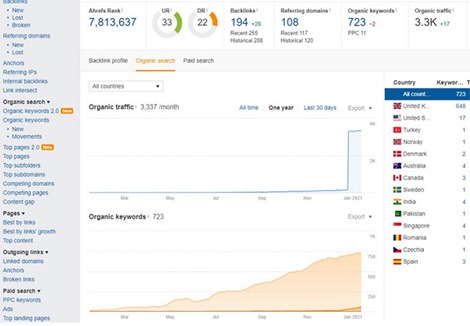
Source: Sir Links A Lot
By the end of five months, the site succeeded in gaining the number one rank for its primary keyword. Additionally, owing to the increase in its organic traffic, the site also achieved an overall SERP of number 1. Compared to other top rankers, the site achieved this feat with a lower quantity of links.
The top strategies you can drive from this case study include:
- Focus on quality rather than quantity of backlinks.
- Diversify the type of links you attract to ensure that you cover all grounds.
- Linking back to the homepage is a great success that every website should strive for since it increases the chances of conversion.
Case Study #3: Pat Ahren Prodding a B2B Towards Success
After researching the various SaaS SEO agencies , a hosting provider ended up knocking on the doors of Pat Ahren and his team. The brand was struggling to assert its online presence and uniqueness in the face of competitors like HostGator and GoDaddy.
Working with a minimal budget and within a highly competitive industry, Pat Ahren surely felt that the odds were against him. However, he and his team still succeeded in improving the online presence of one of its clients.
The SEO team began by conducting competitive research, which unearthed a content marketing opportunity for the B2B website. A lot of its target audience, over 10,000 to be exact, were looking for information regarding DDoS attacks.
Ahren took this as a clue to shift the main keyword from a general phrase like “web hosting” to a specific phrase like “secure web hosting”. After doing so, it optimized the website’s content accordingly and moved on to creating relevant premium content—this laid ground for their link acquisition techniques
After optimizing the content of the website, the experts began building links to boost the backlink profile of the B2B website.
The prime focus of the link-building campaign was on guest posting. The writers of the team wrote valuable content for various authoritative websites and blogs to acquire high-quality backlinks that the team could control.
To establish authority as a secure web hosting provider, the team used tools like SEMRush and Ahrefs to identify potential content topics pertaining to DDoS protection. The tools also came in handy in detecting other links that wrote credible articles on the topic.
Over 1000 authoritative websites were shortlisted, and a relevant premium article about DDoS security on the B2B website was shared with each of the bloggers. Those who responded with praise were encouraged to link back to the content.
By promoting a single premium article to over 1000 bloggers, the B2B website was able to attract over 43 backlinks from a total of 15 different sites. This figure does not take into account the numerous social media shares of the content received.

Source: Inter Growth
Now, the premium article is one of the highest performing pages of the website, with over 700 readers a month! It also increased the average time spent on the website to four minutes.
The campaign ran for three months and increased the organic traffic by over 55 percent.
You might think that this case study doesn’t teach us any actionable strategy we haven’t already discussed. Well, read it again! There is a very important insight that we learn from this case study.
And that is the power of finding your unique positioning and then altering your link building efforts around it. Rather than targeting all websites for link building, these experts focused on only those that dealt with online security – thereby ensuring that the target audience of their website aligned with that of the guest posting platform.
Additionally, it also showcases how in case of a lack of budget, you can easily improve your links via one premium piece of content, a handy SEO tool, and dedicated outreach efforts.
Now It’s Your Turn!
Are you inspired by the three starkly different yet successful case studies? Gain insights from these stories and use their tried and tested actionable strategies to improve your link-building efforts.
Who knows, maybe by the end of this year, your website would be the next case study every SEO expert would be raving about. Till then, keep building links or explore our best SEO agencies for startups if you’re looking for one. You can also read our Guide On Above The Line VS Below The Line Marketing .
Share this post

Agencies of the Month

Related Posts

Subscribe to keep up with fresh news and exciting updates. We promise not to spam you!
This website uses cookies. Continued use of this website indicates that you have read and agree to our Terms & Conditions and Privacy Policy .

- List Your Site
- Case Studies
Case Study: Link Building, ROI and Quality Over Quantity
Tom Buckland

Foreword by Matt Diggity
Very soon I’ll be passing things over to Tom Buckland.
Tom is a very clever SEO who founded Ghost Marketing , based out of the UK.
I’d “known him” for a while on the interwebs, but we recently connected when I saw he was ramping up as an Authority Builders customer and coming to the Chiang Mai SEO Conference.
In this article he’s going to be going through a high-ROI link building campaign that he used to significantly propel his client’s organic growth.
When it comes to link building, quality is a tough metric to analyse, but one thing most SEOs will agree on in the 2019 onwards Google era is quality over quantity. I would take 10 great editorial links over 100 average links any day of the week.
Most people know that link building offers a great ROI and is a fraction of the cost of traditional marketing, PR or advertising techniques.
A lot of people overestimate the number of links required to get great results. This really does depend on the “quality” of the links in question, which boils down again to the techniques you use to achieve said links.
Again, it all comes down to quality over quantity.
The case study we are going to examine demonstrates this principle.
Through a data-driven approach, we built a small number (18) quality, highly relevant links for a client.
At the end of the project’s timeframe, the results were significant, with huge increases in sales leads and revenue, and an overall ROI for the client of around 1000% for the brand-new targeted lead generation site.

Project Background
The project described in this case study was conducted over a 6-month period. We took on this project as part of our smallest link building package for an almost brand-new lead generation site.
The client was a B2B service provider which offered a very specialised service. For this reason relevancy was extremely important.
At the start of the project, they were generating essentially zero sales through organic search.
The client had struggled for a long period of time to generate links or rankings, and organic traffic had suffered considerably – A familiar story agency owners hear from clients, usually with an element of distrust around the potential link building or SEO service being offered.
The overall strategy for this campaign was very simple;
- Build links to the correct pages within the client’s site.
- Build high quality, relevant links (Quantity wasn’t so important).
BONUS: Download 3 Case Studies for 3x Organic Growth
The Challenge
The screenshot below shows the organic traffic to the client’s site, generated through the organic search feature on Ahrefs .
As you can see, traffic was extremely minimal, and after a small increase in Jan 2017 had dropped to close to zero before we began our project in November 2017.
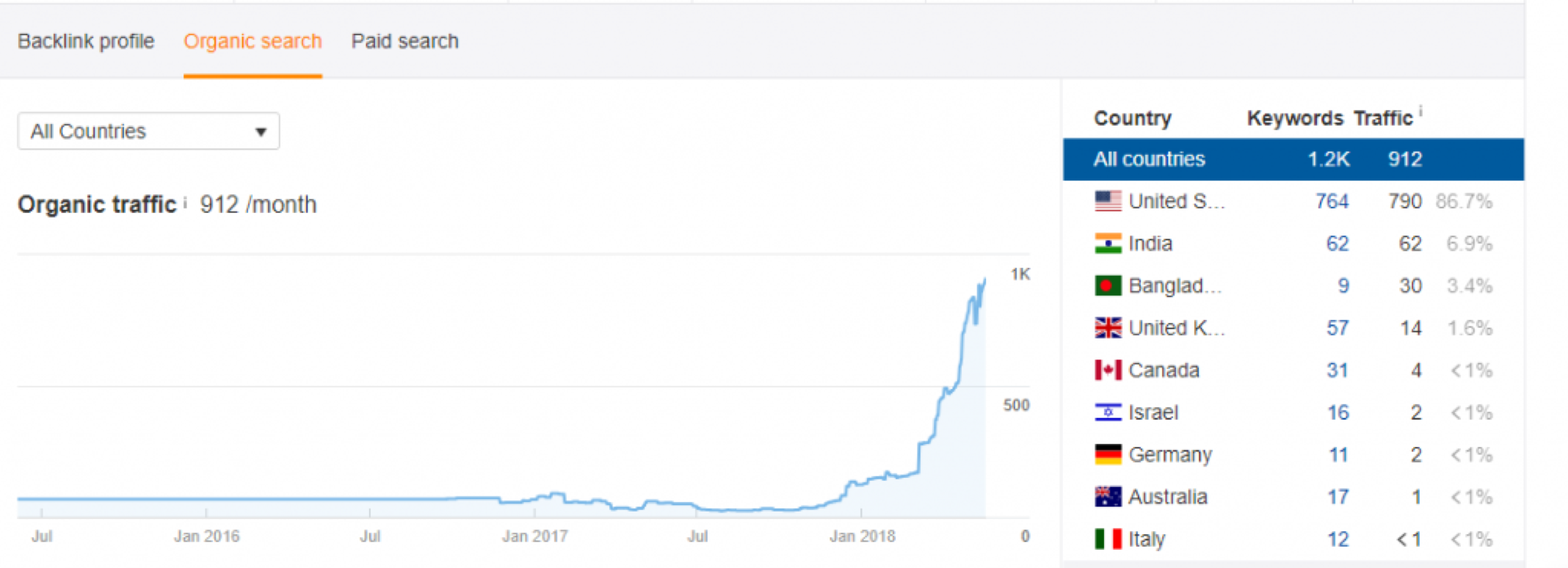
Leads generated through links had the potential to generate high revenue for the client, with the average first sale of new business being between £1,500 and £6,000.
Therefore, the potential impact from even a handful of small links was significant.
How we approached the challenge
Background analysis.
As part of our research into which links to build, we looked at the pages from the client’s site which were already ranking on page 2 or page 3 of SERPs.
More importantly, we looked at the pages which were ranking this way for extremely powerful keywords .
One of the key tools we used in this case study, and that we use daily in our agency, is Ahrefs . As part of our data-driven approach, we used this tool to analyse both the clients’ site and top ranking competitors.
As a first step in any process you should paste the homepage into Ahrefs’ site explorer and start digging (the site in this screenshot is purely an example and not associated with this case or our business):

By analysing the client’s site we can easily find out key info such as:
- Number of referring domains
- Domain Rating
- Ahrefs rank (Ahrefs own ranking of all websites based on size and quality of backlink profiles)
- Organic traffic levels
- Traffic value estimates
This is incredibly useful to gain a baseline for any link building project, track progress and measure results.
Pay attention to Ahrefs’ traffic value but take this particular metric with a grain of salt.
In our experience working with clients, we have found that Ahref’s traffic value is generally very much of an underestimate. We would generally take Ahref’s estimate of organic traffic and multiply it by 5 to 10 times to get to an estimate of what we will see as an actual traffic value.
For example, the below screenshot shows the estimated traffic value on Ahrefs for an eCommerce site, which is estimated at $480K per month by Ahrefs.
However, we know from Google Analytics that this site earns approximately $5 million through organic traffic alone.

The next step in analysing any site through Ahrefs is to check the backlink profile in Ahrefs, by looking through the anchor cloud section.
By looking through the links, you can see pretty easily whether the links are branded, relevant and natural, or if they appear spammy.
If a site you are working on has unnatural links which may attract an unnatural link penalty, it is important to disavow these links before the penalty is applied.
The below example from alternativeapparel.com (again, no relation to this case study or our agency) shows a backlink profile of natural anchor text phrases without spammy links:

Focus on Quality Links
Obviously, the aim of any link building strategy is to build a strong backlink profile. However, it is not just about the number of links.
Links which come from quality sites – that is authoritative, well-known sites and online publications – carry much more weight in real terms, both in terms of SEO and in driving organic traffic .
Furthermore, a link from a top site in your industry is highly valuable because it is virtually unbeatable by your competitors.
Build 100 links from lower value sites and these can easily be replicated by your competitors. However, build links from some of the most reputable and authoritative sites in your niche and it will be almost impossible for your competitors to replicate this, even if they look at your site and work out where the links are coming from.

For this reason, we conduct undertook a long-term digital PR strategy involving research into the top industry sites and effective outreach to them.
Anchor Text Keywords
Next, we identified the best anchor text to use for the links we were going to build. The anchor text of the link needs to have the most relevant and profitable keywords which you are aiming to rank for.
For this client, we knew that relevancy was critical.
Because they had a very specific service offering, ranking for variations, synonyms and other terms would have a huge impact in terms of ranking for organic traffic and could triple organic revenue.
We used Ahref’s site explorer function to research the most relevant keywords by reverse engineering keywords from top ranking competitors.
The first step in this process is to identify the top-ranking competitor sites – this can be as simple as doing a Google search relevant to the business and seeing what are the sites which rank at the top of page 1 of results.
Ahrefs will then tell you which keywords the URL is ranking for:

As a final step, we checked the competition of each keyword on Ahrefs in order to avoid hyper-competitive keywords.
This essentially comes down to weighing up keyword search volume versus competitiveness. Keywords with high search volumes can obviously be beneficial as they have the potential to reach a much larger audience.
However, these keywords are also likely to have much more competition, including well-known, established online publications which are very difficult to rank against.
Which strategy you pursue, or how you combine both strategies, will be different in every situation. For example, established sites with a strong domain authority may choose to aggressively pursue rankings using highly-competitive keywords. Newer sites may choose to build their domain authority by targeting lower-volume and low-competition keywords.
The keyword search volumes in this case were relatively low, at 10-200 searches per month in most cases. However, low competition levels for these combined with the client’s specific service offering meant this approach had huge potential to drive organic traffic and revenue.
Identify the Correct Links
The next step was to work out which pages of the client’s site we should build links to. As a guide, we started by looking at the pages of the client’s site which were already ranking on page 2 or page 3 of SERPs for relevant keywords.
We used the site explorer function in Ahrefs to see which pages were currently ranking well for our target keywords. We then took this information and used it to build links to these pages.
In this case, this actually meant primarily focusing on building links to the client’s homepage, which is relatively unusual.
Most of the time it is most advantageous to build links to already high performing content within the site.
If the site has a quality, useful blog post which is already performing well on Google, building links to this post will improve the post’s rankings and can drive it on to the first page of results.
You can also use Ahref’s organic search feature to test keywords against estimated number of visitors the site can expect to receive when using these keywords:
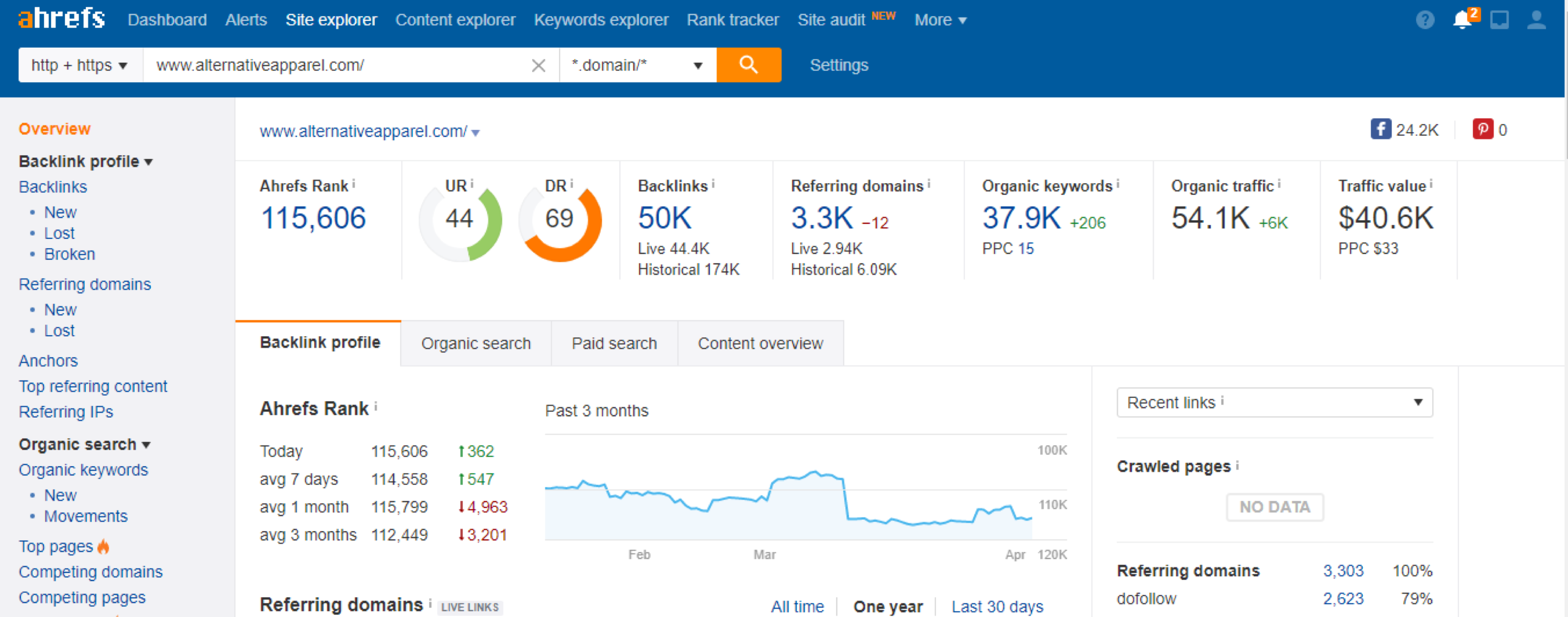
However, it is also important not to over-optimise.
While taking a data-driven approach, you also need to apply judgement in order to avoid pulling out irrelevant keywords, while still keeping competitiveness in mind and avoiding hyper-competitive keywords.
This is essential to achieve the goal of meeting the best ROI efficiently and as soon as possible.
URL and Keyword Sheets
We then compiled this on a Google sheet to get a summary of the target URL and keywords for the links we would be building.
This can be tracked in a variety of ways, but we find Google sheets a simple and effective way to compile and track this, in a space which allows collaboration between our team and the client.
Our Google sheet template looks like this:
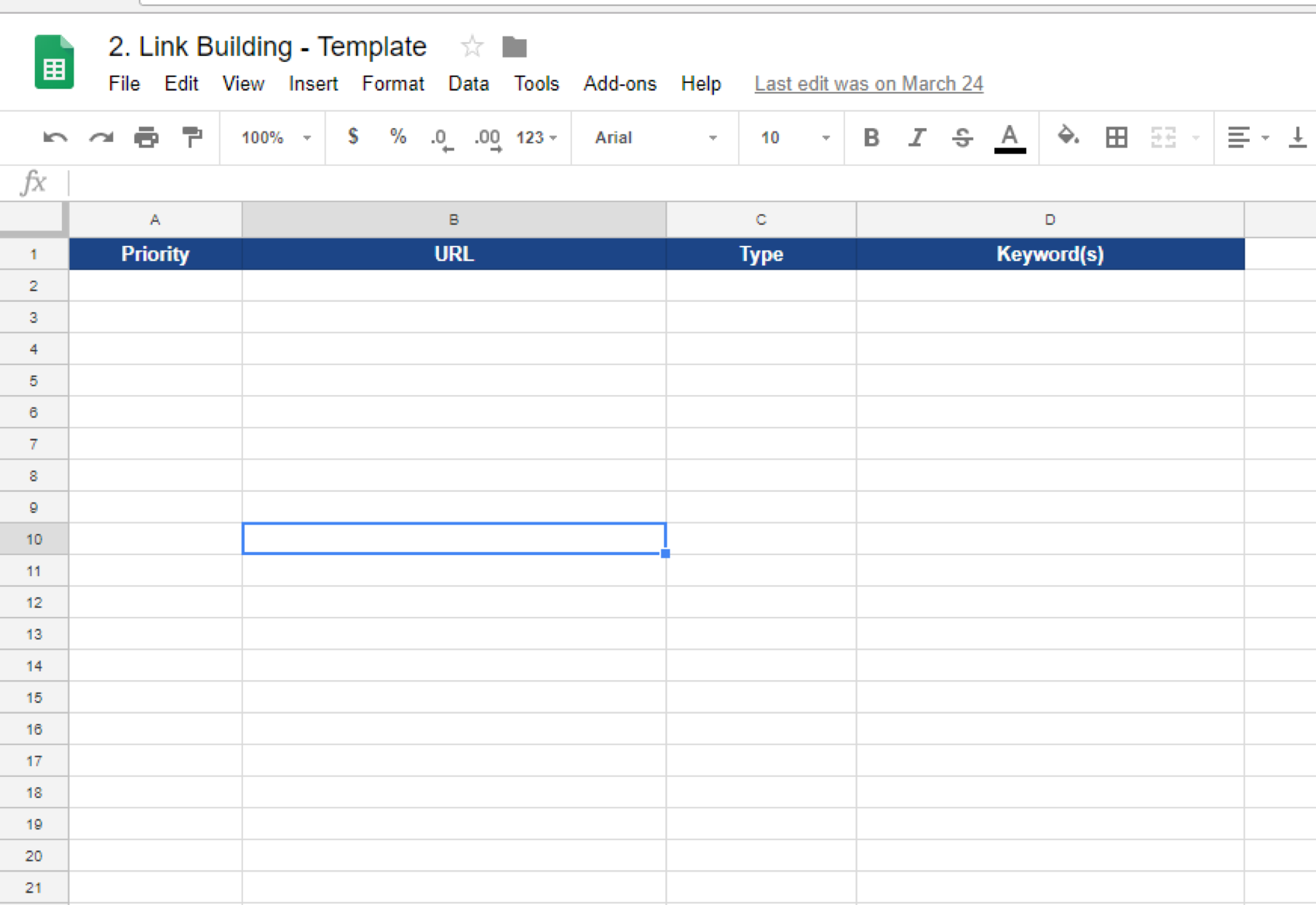
We then simply built out the spreadsheet based on the budget of the client, number of links, anchors and data from Ahrefs.
Authority Builders
Increasing volume of links in a reliable way is a very tough part to add.
If we’re aiming to build 20 links a month but are going to be a bit behind, having a service such as the one that Authority Builders runs is incredibly helpful.
Although our main focus is on content creation and digital PR, using a platform like this is a great supplement to increase total number of links in a reliable, quick and most importantly safe manner.
Just purchasing post and knowing it’ll be live in 6ish days really helps keep the agency scaling and filling in any gaps.
It also helps that ABC has a network of sites you can choose from enabling us to keep niche relevancy very closely focused.
Interface is also 10X better than most of the other services on the market.
Apply to ABC here
Our Strategy and Techniques
For the digital PR segment, we identified the top 100 blogs in the client’s industry and specific to their bridged-niche, looking at the most popular relevant sites in the industry.
A bridged-niche is where we’ll take a client’s real niche (say SEO for example) and build a bridge to another industry (say fitness for example).
If you approached a fitness site as an SEO agency stating the generic “can we write a guest post” you’ll get ignored 99 times out of 100. But if you create a bridge or an angle, such as: “Hey, we’re building a piece of content on how personal trainers can generate more business through Google” – Your results will go through the roof.
We then reached out to the editors of the blogs and offered to become a contributor.
This process is simple enough but is extremely time-consuming and draws out over time as you need to wait for responses from the editors which can take weeks or even months, follow up and so on.
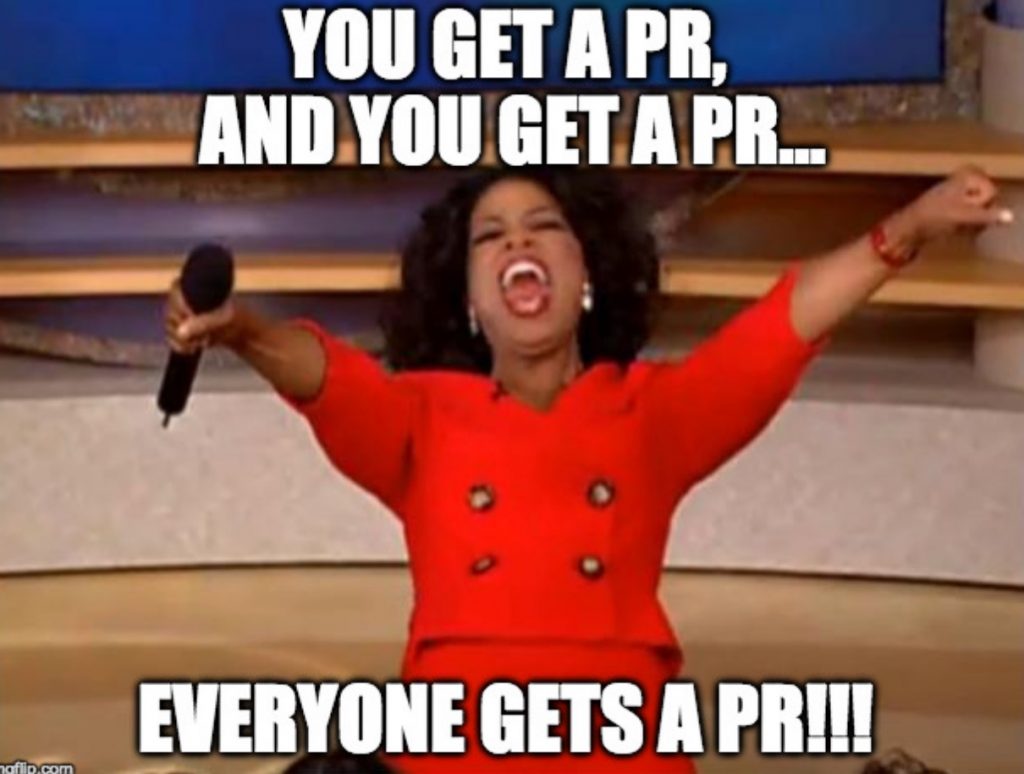
Many companies do not invest the time and energy in this process, meaning excellent opportunities for powerful, relevant links for those who are prepared to suffer the frustrations and waiting required.
As part of the Digital PR component of this project, we developed a non-media list of the top 100 blogs in the client’s industry which were relevant to their niche.
In other cases, we often build both non-media and media lists. It depends on the business, niche and the overall strategy.
In all cases, we apply a personalised approach to all outreach and therefore have a much higher success rate compared to a scattergun approach of sending generic emails to thousands of prospects. We work on building relationships and rapport with our media and non-media contacts as an important part of the process.
In this case study, because the client had such a specific service offering, it would have been difficult to find enough quality sites in their very specific niche.
Therefore, we looked for “niche-bridge” opportunities: those which were related and relevant to the client’s service offering.
Our strategy was to pitch in-depth guides to be published on their blogs. Because we were pitching to top industry sites, we wanted to use quality, detailed and interesting guides as offering a valuable form of content.
Link Building
As already mentioned, the approach in this case was slightly unusual in that we were aiming to build links to the client’s homepage rather than to other content or posts on their site.
The in-depth guides we requested to create for these sites included links back to the client’s homepage.
The majority of the 18 quality links we built linked to the homepage directly. However, four of these links were to inner post pages on the client’s site.
For these, we then internally linked back to the homepage using the target anchor text.
As part of our process, we always conduct a backlink analysis of relevant competitors to get insight into which backlinks are working well in the niche. This can be done very simply using Ahrefs’ backlink analysis features.

Conduct a Google search for the keywords you have already identified and pull out high ranking sites, avoiding listlicles and similar.
You can then run these sites through Ahrefs’ site explorer and see the URLs’ backlinks profiles. You will want to filter these by: 1) One link per domain, 2) Dofollow links only and 3) English. This will get results down from the hundreds and a manageable amount for analysis.
Once you have these results, you can scroll through the links to see which may be useful for your link-building strategy. Of course, you will want to exercise judgement to ensure they are relevant, authoritative and “buildable”.
Brand Building
The other approach we took as part of this project is something which is not very common in link building: to build the customer’s brand. For this client, the brand name was also the primary keyword, so building the brand and targeting keywords were closely linked.
Digital PR and content marketing are both solid brand building strategies in their own right.
In this way, brand building and link building have a great synergy, with the same techniques working together for shared goals.
Anchor Text Diversity and Keywords Variations
We focused on keyword variations, making sure to include all possible variations of the keywords in order to achieve rankings in all possible relevant searches and hence capture as much traffic as possible.
In order to identify keyword variations, we used the keywords explorer function in Ahrefs – which helps generates additional topic queries, even on very generic searches.
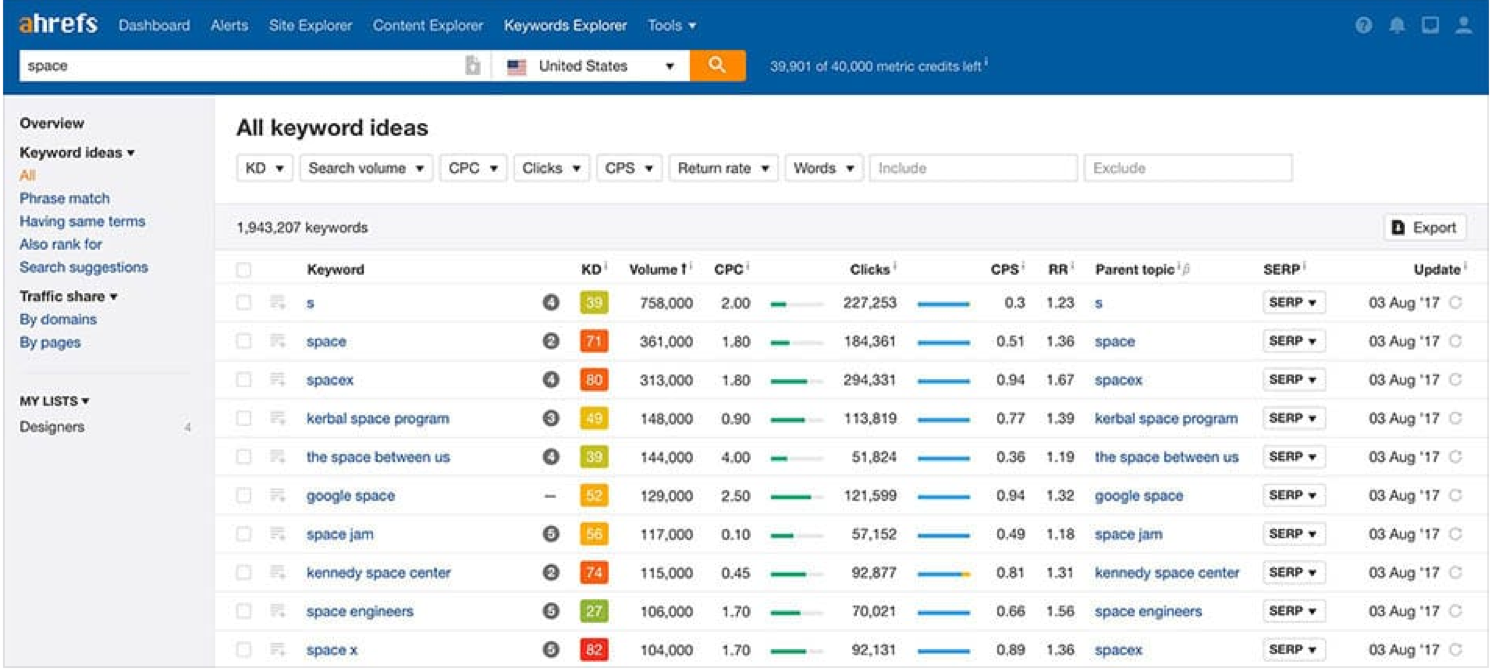
Obviously keep an eye on anchor text and over-optimisation as this can result in a lack or movement or a penalty at worse.
To do this we were careful to maintain anchor text diversity. While it is critical to make sure to include relevant keywords in anchor text for great SEO, Google penalises sites which are over-optimised through too much repetition of the same primary keywords in anchor text.
As we know, in this case the brand name was also the primary keyword. Therefore, we needed to be extremely careful in not over-using branded anchors (that is anchor text which was the company name), which would result in over-optimisation.
We aimed for 5-10% of branded links in the anchor text only, and using keyword variations, synonyms and even generic options for the rest.
Measuring Project Results
The key tool we used to measure the KPIs and results of the project was Google Analytics’ organic search feature.
Although this tool is influenced by the quality of technical and on-page optimisation, this remains one of the best ways to measure organic traffic and therefore measure results in this type of project.
The screenshot below shows the steady increase in organic searches over the project period of November 2017 – April 2018.
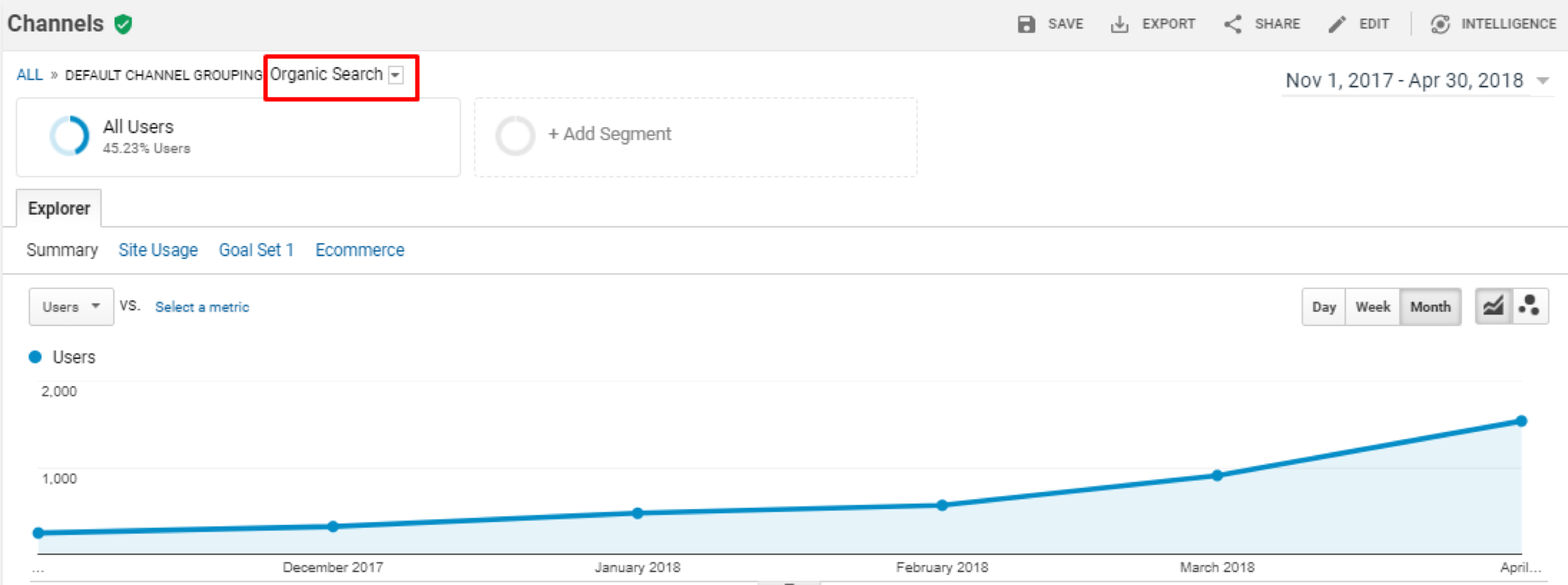
Finally, we used serpbook ’s tracker tool to see keyword performance over time in order to make any adjustments or improvements.
The screen shot below shows results for our core, highly profitable keywords in the top section, and all keyword variations we were looking to rank in the section below.

The most important results from the client’s perspective, however, were organic lead generation and increased revenue. More on this below
The Results
Over the course of the project, we built a total of 14 links to the home page and 4 links to inner post pages.
18 links built over 6 months, that is just three links per month may seem like a low result. However, our approach is always to assess results from the perspective of ROI (return on investment).
The end result for the client was 18 links delivered with £12k Per Year Link Value, with a monthly ROI of 1000%.
At the end of the six months, the project was generating 30 new leads per month, a 550% increase in organic leads. The average first sale from new customers was £1500-£6000.
Overall the company’s revenue increased by £12,000-£18,000 per month, based on the 18 links built.
Thus each link built was individually worth £1,000 per month, or £12,000 per year.
This represented a monthly ROI for the customer of around 1,000%.
The client also saw exponential increases in terms of rankings and traffic. Looking again at the screenshot of Ahrefs organic traffic feature for the client, we can see that after the project commenced in November 2017 there was a significant increase in traffic.
The results were not immediate, but started slow and gained momentum over time, resulting in huge growth over the 6-month project timeframe, and particularly in the last two months.
You will also note that growth continued past the end of the 6 month period as the impacts of the strategy continued to develop.
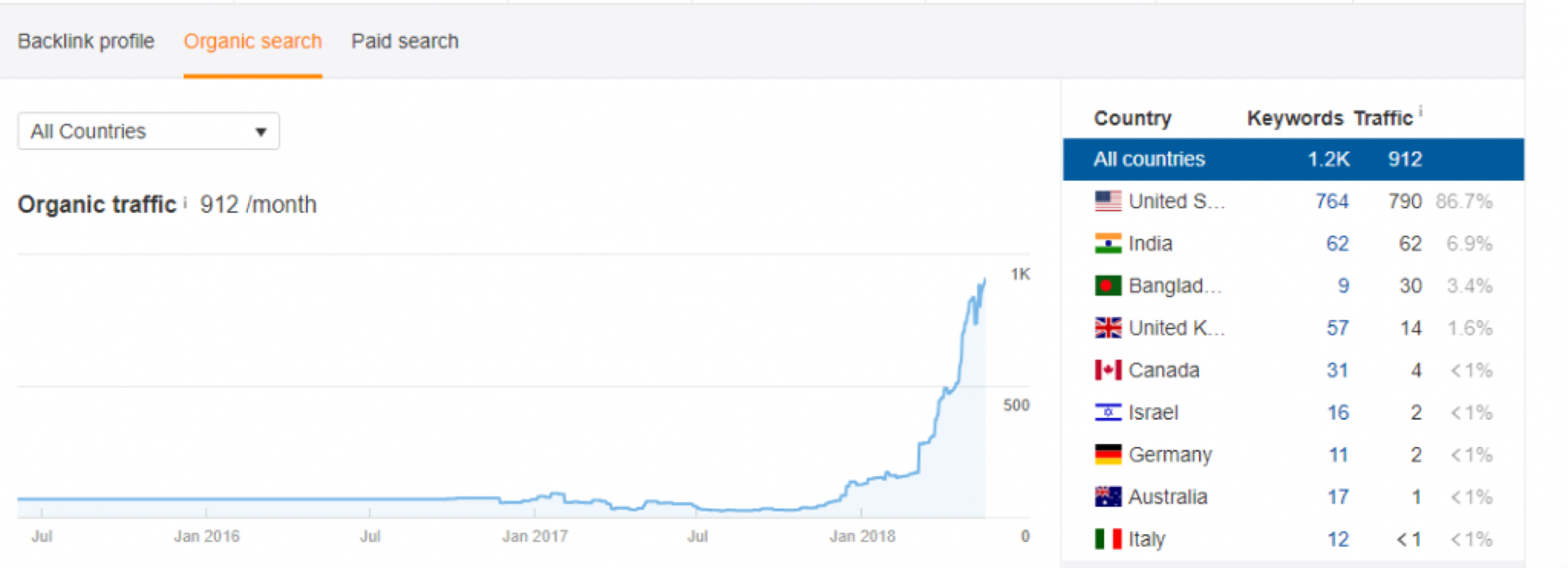
Having this strong result means we can now continue to build off this success and develop a larger link building campaign targeting more competitive keywords.
These incredible results in terms of ROI show the importance of quality over quantity when it comes to link building. At our agency , ROI for our clients is always our primary focus and the number one KPI.
With an ROI of over 1000%, and an increase in revenue of £12,000-£18,000 per month from just 18 links, this case study demonstrates the effectiveness of data-driven link building which focuses on building quality, relevant links.
The results did not happen overnight – the entire project ran for 6 months, with results starting gradually and then scaling up over time. However, once the investment started to pay off, this pay off was significant.
What’s more, these results lay the ground work for continued business growth and great potential for further development through link building.

SEO Link Building Case Study
582% growth in organic traffic with link building and on-site optimization.

Sure Oak is the best SEO firm I’ve ever worked with Edmund Zaloga, Founder, & CEO of Responsify
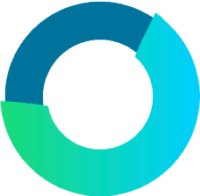
DA 16 to DA 30

Who is Responsify?
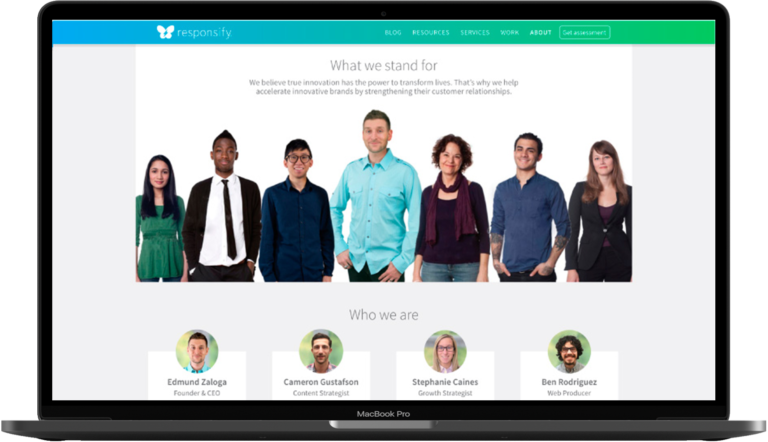
Needed Higher Domain Authority
As experienced inbound marketers, Responsify had specific goals when approaching Sure Oak SEO for help. They sought to increase their domain authority to 30. By having a specific goal in mind for domain authority , they aimed to get a lift in high-intent keywords and an increased presence on search with competitive key phrases that are most relevant to their target customers so they could see increases in revenue from site traffic. To help increase their authority, Responsify needed link building strategies around the services and industries they already serve. Due to their time being maxed out on serving their clients, they also needed assistance executing thought leadership pieces on high authority websites.
Revamping Their Website
Before any link building could begin, Sure Oak SEO completed a technical audit to their website and its existing content along with extensive keyword research . In a series of recommendations, new keywords were identified and keyword density was also implemented to drive more incoming traffic. o increase their brand awareness and domain authority, a variety of link building strategies, integral to our link building services , were executed. Once they established citations and SERP stacking as foundational links, the focus went to powerful editorial links around their main targets:
- Healthcare marketing
- Ed tech marketing
- Inbound marketing funnel
Guest posts were written on Responsify’s behalf by Sure Oak SEO and placed on high authority websites to help increase their domain authority and awareness with their ideal audience.
In addition to the powerful editorial links, Sure Oak SEO also ran a scholarship campaign which helped to acquire 80+ .edu links. These links are typically websites with high trust and authority, helping to boost the website’s domain authority and trust significantly.
“It had an overwhelmingly great response which directly linked back to our site from a number of high-quality educational sources and universities,” Edmund says.

Since working with Sure Oak SEO, in just six months Responsify’s domain authority reached 30 as they hoped for, increasing by 87.5% with over 345 linking domains.

Ranking keywords increased nearly tenfold with over 1,500 keywords. A 582% increase in organic monthly traffic over the previous year.

Organic monthly users compared to the previous year increased by 810%.
Looking to increase your search rankings and get more leads directly from your website?
©2024 sure oak solutions llc., terms of use , privacy policy , sitemap, privacy overview.
How to Use Case Studies for SEO
Customer case studies are the most versatile marketing asset you can have.
And that versatility even extends to adding extra juice to your SEO.
Because you can use case studies—and the inputs, outputs, and byproducts of the case study creation process (such as social media cards, video testimonials, audiograms)— to attract new eyeballs online through thoughtful SEO practices.
(For more specifics on how to implement SEO strategies and practices, check out these resources from Moz .)
Here are just some of the ways you can use case studies for SEO:
- Target [service] + [customer]
- Target “how to” phrases
- Target prominent brand names
- Target thought leaders
- Link to related services, products or offers
- Use as link building material
- Create additional assets to target long-tail search phrases
1. Target [service] + [customer]
Typically, case studies tell the story of how your product or service helped your customer solve a specific problem.
So try targeting those keywords in combination in your SEO.
For example, say your case study describes how a crypto exchange company (let’s call it “ABC Company”) is using your crypto platform to scale. You can try to rank for that combination of keywords: “crypto platform” + “ABC Company.”
This strategy may catch the attention of people who’re trying to figure out who provides that service (i.e. crypto platform) to that company (i.e. ABC Company.).
2. Target “how to” phrases
Case studies naturally lend themselves to “how to” keyword phrases. In fact, many of our case study headlines use the “How Company A helped Company B achieve XYZ” format. With just a few tweaks, you can change that format to match a “how to” keyword search phrase.
So a headline such as:
“How Company A Achieved 100% ROI With Service X”
becomes the keyword phrase…
“How to achieve ROI with Service X” or “How to achieve ROI with [non-branded description of service].”
Let’s look at another example.
The headline “How Company A Stops Cyber Attacks with Product X” can be tweaked to target these keyword search phrases:
“How to stop cyber attacks with Product X” or
“How to stop cyber attacks with [non-branded description of service].”
3. Target prominent brand names
If the company or product featured in your case study has brand name recognition, you can use that name as a keyword to capture the attention of people searching for that brand.
In this case study example, SearchLab Digital (our client) helped Panama City Toyota triple its organic traffic.
Here’s a screenshot of the cover page:
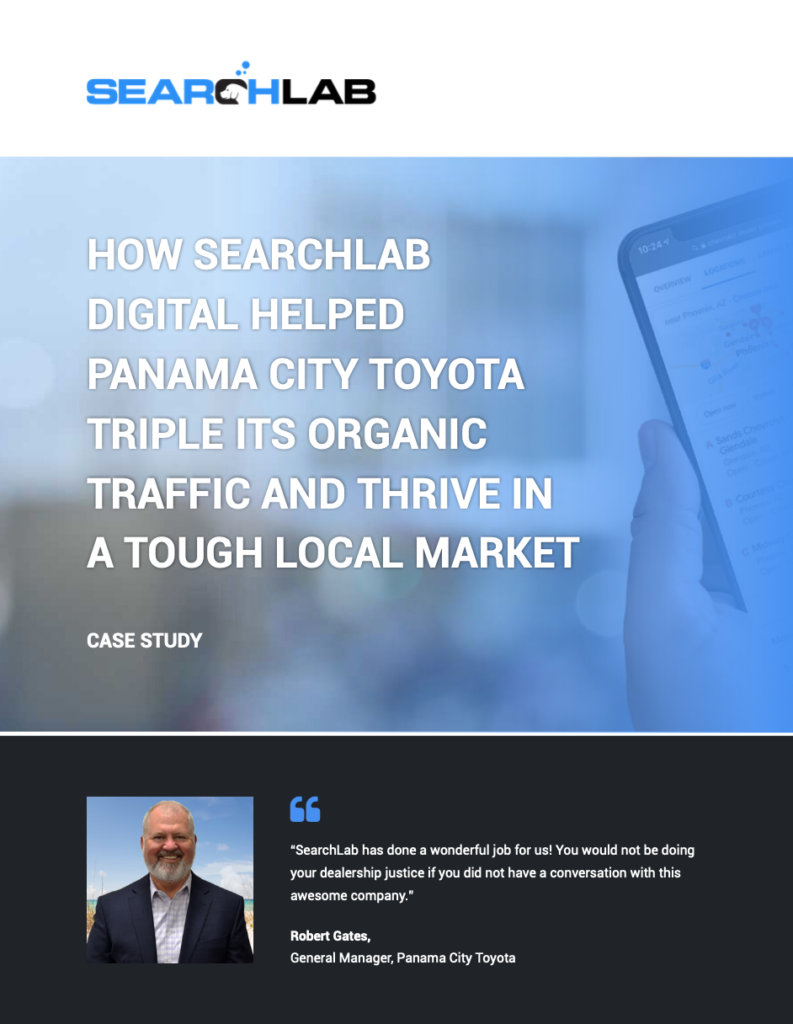
Given its expertise in SEO, you can bet that SearchLab Digital will take steps to benefit from the authority of the Toyota brand name.
4. Target thought leaders
Similarly, if your case study includes a quote or two from a thought leader who garners search traffic , then that’s another keyword term you can target in your SEO.
So, for example, if you’re fortunate enough to have a thought leader speak about the benefits of your product/service—you’ll absolutely want to put their names front and centre in your keyword list.
5. Link to related services, products or offers
Case studies also provide excellent linking-off points.
So if your case study describes how you provide Service A to your client, you can link from that case study to the page of your website that describes Service A.
This kind of link allows readers to learn more about your service, product, or offer —immediately after learning how you used that service/product/offer to solve a pain point for a company just like them.
6. Use as link building material
You can go further with this linking approach and use your case study as link building material , especially if it’s a great story with a prescriptive angle that you can leverage.
7. Create additional assets to target long-tail search phrases
As hinted at above, case studies don’t just deliver a single sales and marketing asset. You also get all the inputs, outputs and byproducts of the case study creation process.
And you can use these for SEO purposes too.
For example, say you work with our team to create a powerful video testimonial stemming from the same customer success story. You can use that video asset to rank for long-tail search phrases that go beyond those contained in the written case study.
Put the power of case studies behind your SEO
It’s astonishing how much value you can derive from a single case study—including pumping up your SEO.
So don’t let those valuable assets languish on your website. Wring out every drop of value by targeting related search terms and building quality links.
Want to create powerful case studies that will help improve your SEO?
Contact us to start the conversation and learn more.
Head of Writing and Interviewing
Based in Vancouver, Canada, Holly is pumped to tell stories of companies succeeding and doing good in the world.
Ya, you like that? Well, there’s more where that came from!
Should you send case study interview questions in advance.
Sending your case study interview questions to your interviewee in advance sounds like a no-brainer, doesn’t it? And certainly, if you type “should you send case study interview questions in advance” into Google, that’s the boilerplate advice everyone gives. But is that truly good advice? Or does it depend on the situation? At Case Study Buddy, we’ve conducted (literally) hundreds and hundreds of case study interviews, and we’re continually testing new and better ways of conducting them. And the answer...
Best AI Case Study Examples in 2024 (And a How-To Guide!)
Who has the best case studies for AI solutions? B2B buyers’ heads are spinning with the opportunities that AI makes possible. But in a noisy, technical space where hundreds of new AI solutions and use cases are popping up overnight, many buyers don’t know how to navigate these opportunities—or who they can trust. Your customers are as skeptical as they are excited, thinking… “I’m confused by the complexity of your technology.” “I’m unsure whether there’s clear ROI.” “I’m concerned about...
How to Write Cybersecurity Case Studies
When it comes to case studies, cybersecurity poses special challenges. The cybersecurity landscape is saturated with solutions—and so sales and marketing teams have never been hungrier for customer success stories they can share as proof of their product’s abilities. But cybersecurity clients are very reluctant to be featured. They don’t want to talk about the time they almost got hacked, they don’t want to disclose the details of their setup and risk more attacks, and they just plain don’t want...
Let’s tell your stories together.
Get in touch to start a conversation.
Free tracking template:
How to capture video, testimonials at live events.
Free Report:
The big list of 100 ways to use your case studies.
If your case studies and video testimonials live only on the customer success page of your website, you’re missing out. You can do SO MUCH MORE with these versatile assets.
Get our actionable guide to using case studies across your sales and marketing funnel (and beyond) to wring out every ounce of value.

- Not sure where to start? Chat with us
Managed SEO Banner
Authority building, link building service, haro link building, publisher outreach, guest posting, partnership-led seo, gmb management, local seo services, seo auditing, website migrations, page speed optimization, technical seo, content strategy, copywriting, keyword research, on-page seo services, blog writing services, paid media management, facebook ads, other services, our blueprint, seo advisory, brand defense, conversion rate optimization, youtube seo, see all services, chat with us, software seo banner, search atlas, search atlas seo software, blog topic generator, content audit tool, content planner, competitor research, bulk da checker, seo content optimizer, seo content assistant, rank tracking, backlink analysis, phone number, agency services, white label link building, white label seo, white label seo software, white label ppc services, video section, by industry, seo for b2b companies, seo for ecommerce brands, seo for saas companies, seo for healthcare companies, seo for government, seo for enterprise companies, seo for law firms.
- SEO for Dentists
Blank space
Seo for doctors, seo for startups, national seo, international seo, small business seo, big commerce seo, shopify seo.
- The Ultimate SEO and Digital Marketing Resource Network Skyrocket your SEO strategy with LinkGraph's expert resources. Browse our content to stay ahead of the curve, drive business growth, and crush your SEO goals. Free Consultation
Case Studies
The Ultimate SEO and Digital Marketing Resource Network
Skyrocket your SEO strategy with LinkGraph's expert resources. Browse our content to stay ahead of the curve, drive business growth, and crush your SEO goals.

Link Building
- Supercharge SEO with White Label Backlinks
- Link Building for SaaS Companies: 2023 Guide
- 12 Best Link Building Strategies for 2023
- What Are Backlinks and Why Do They Matter in SEO?
- Link Building Outreach: A Guide for Beginners
- Domain Rating vs. Domain Authority
- Is My Website Ready for Link Building?
- How to Get Permanent Backlinks to your Website
- Why Anchor Text Diversity is Good for your Backlink Profile
- What is a Backlink Profile and How to Analyze Yours for SEO
- White Hat Link Building Methods vs. Links to Avoid
- How To Choose The Right Link Building Package For Your Business
- How To Use A Backlink Generator For Your Website
- The Best Ways To Get Links From Guest Posts
- The Most Effective Ways To Increase Your Website’s Domain Authority
- How to Execute The Broken Link Building Method
- SEO Content Marketing
- How to Find Link Building Opportunities for your Business
- The Best Techniques For Obtaining Links From Other Websites
- Link Building Training Course
- The Best Link Building Tools For SEO
- What To Look For When Choosing A Link Building Service
- How To Use Tiered Link Building To Improve Your SEO
- How To Do Tier 2 Link Building The Right Way
- 16 Link Building Tips to Improve Landing Page SEO
- Link Swapping: The Dos, Don’ts, & Google’s Guidelines
- 7 Contextual Link-Building Tips & Techniques
- Link Exchanges: Do They Work & Are They Safe?
- Should Your Business Buy Backlinks?
- How To Choose the Best Quality Link Building Services
- How to Maximize the SEO Power of Links with Annotation Text
- What Are Orphan Pages in SEO: Causes, Impacts, and Solutions
- The Google Indexing Coverage Report: Get your Web Pages into Google’s Index
- HTML Href Attribute Guide for Beginners
- Common Javascript SEO Issues and How to Fix Them
- A Guide to CSS File and How to Use Them for Better SEO
- What Is Duplicate Content in SEO and How to Fix It
- 7 Tips for Better Information Architecture on Your Website
- Noindex Nofollow and Disallow: Search Crawler Directives
- How to Whitelist the Search Atlas Site Crawler on Cloudflare
- The Most Important HTTP Status Codes for SEO
- Hreflang Tags: What They Are and When to Use Them
- A Complete Guide to Schema Markup
- A Guide to SEO HTML Tags
- How to Use Twitter Cards to Make Content More Clickable
- Open Graph Tags Implementation & Best Practices
- 301 Redirects for SEO & Common Redirect Issues
- How to Improve Website Performance for Better Rankings
- The Google Page Experience Update Guide
- What Is Crawl Budget & How to Optimize for It
- A Guide to HTTPS vs HTTP Protocols and More
- An Easy Guide: How to Create a Sitemap for Google
- What Are Canonical Tags and When to Use Them
SEO Software
- Analytics Tracking Detection in Search Atlas
- 8 Essential Tools for SEO Freelancers
- Keyword Tracking: How to Choose a Rank Tracking Software
- Ultimate SEO Toolkit: 10 Essential Tools For Digital Marketers
- A Guide to SEO Reporting Software for Clients
- Does Your Favorite SEO Tool Have Accurate SEO Rank Tracking?
- How to do SEO Copywriting with the SEO Content Assistant
- 4 Local SEO Tools to Boost Site Traffic and Foot Traffic
- 7 SEO Agency Tools to Accelerate your Client Growth Campaigns
- Powerful SEO Tools in Your Customer Dashboard
- 6 Brand-New (Free) SEO Tools to Take Advantage Of
- How to Spy On Your Competition with SEO Competitor Analysis Software
- 10 DIY SEO Software Tools & Tips for How to Use Them
- The Definitive Guide to Enterprise SEO Software
- 5 Ways to Use Content Writing Software to Write Articles Faster
- What Are The Best Backlink Generators On The Market?
- Digital Marketing Tools
- Customer Dashboard Basics
- Directory Listing Scan

Content Marketing
- A Guide to Creating SEO Content Briefs | Examples + Free Template
- What is a Content Manager and Should I Hire One?
- 14 Content Upgrades That’ll Skyrocket Your Lead Generation
- 5 of the Most Impactful SEO Content Marketing Moves to Improve your Organic Traffic
- Information Marketing: How to Share (and Sell) your Knowledge
- Content Development: Improve your Content Strategy for SEO
- What to Do After Keyword Research: 5 Next Steps
- Holiday Music Search Rumble
- Keyword Clusters Guide for SEO Strategists
- What Are Negative Keywords & How Should You Use Them?
- What is Keyword Difficulty & How Does It Affect Your SEO
- Keywords 101: What Are Keywords in SEO?
- Long Tail Keywords
- Choosing Keywords for SEO: A 6-Step Guide
- Jeweler SEO: 9 Ways to Get More Organic Traffic to your Jewelry Website
- Niche SEO: A Guide to SEO for Niche Markets
- WordPress SEO
- Retail SEO Guide: Get More Eyes On Your Online Store
- Law Firm SEO – A 20 Step Action Plan for Attorneys
- Voice Search Optimization: An Updated & Comprehensive Guide
- LinkGraph’s Guide to the Best SEO Strategies for B2B companies
- Mobile SEO – The Complete Guide 2022
- SEO for Ecommerce
- SEO Project Management: A Start to Finish Guide
- Essential Guide to SEO for Contractors
- 10 Small Business SEO Tips to Earn New Customers
- SEO for Photographers
- SEO for Nonprofits
- SEO for Insurance Agencies & Agents: The Basics & Beyond
- Yelp SEO: How to Improve Your Yelp Reviews
- Cannabis SEO: Best Practices for CBD/Marijuana Companies
- 14 SEO Tips for Accountants and Financial Advisors
- Essential SEO Tips for SaaS Companies to Rank Higher and Reach More Users
- Corporate SEO: Best Practices for Large Organizations and Brands
- 18 Real Estate SEO Tips to Generate Leads from Search
- Visual Search: The Next Wave of Search is Already Here
- Plumber SEO: A Straightforward Guide
- Simple SEO Steps for Doctors and Therapists
- 9 SEO Shopify Tips to Optimize Your E-commerce Website
- A Complete Guide to SEO for Startups
- What Are Citations in SEO? A Guide to Local Citations
- How to Rank in the Google Map Pack with LinkGraph’s Local SEO Guide
- How To Set Up Your Google Business Profile Listing
- The Importance of Local SEO
General SEO
- Understanding the Average Cost of SEO and Budgeting Tips
- How Long Does SEO Take to See Results? The Final Answer.
- 30 Ways to Improve SEO Performance
- 6 SEO Strategy Tips For Better Rankings in 2023
- What Are Core Web Vitals? (+4 Tips for Improvement)
- How to Learn SEO: 11 Resources for Beginners and Intermediates
- How to Increase Online Sales During the Holidays with SEO
- Search Visibility Guide
- Celebrate the New Year with a New SEO Strategy for 2023
- BERT: Google’s Largest Update in Years
- 4 Cost-Effective SEO Strategies that You Can Implement Right Now
- Google Algorithm Update History
- Master the SERPs with these 10 SEO Skills
- Guide to the Relationship Between Organic CTR and SERP Position
- New Website SEO
- How to Increase Website Traffic: Direct, Organic, Paid & Referral
- SEO 101: Understanding the SEO Environment
- Mastering SEO and White Label Partnerships
- 10 Questions to Ask Before Hiring a Professional SEO Company
- 10 Steps to Launching a Successful SEO Campaign
- SEO Checklist for Growing Your Site’s Search Rankings
- SEO Outsourcing Made Easy: A How-to Guide for Businesses
On-page SEO
- Everything You Need to Know on How to Buy Referral Traffic
- Topic Clusters and Pillar Pages: A Complete Guide
- What is Search Intent?: A Guide to Search Intent Optimization
- Content Pruning Guide for Content Managers and SEOs
- SEO-Friendly Blog Posts: How and Why to Write Them
- 10 Tips for On Page SEO in 2022
- How to Write Alt Text for SEO & Accessibility
- Semantic SEO
- SEO for PDFs: Get your PDFs Ranking in the SERPs
- Understanding Google NLP Algorithms for Better Content SEO
- What is Google Author Authority?
- The Beginner’s Guide to Writing Web Content for SEO
- Outbound Links and SEO
- Content Length and SEO: Does it Really Matter?
- How to Achieve Optimal On-Page SEO – The 10 Definitive Factors
- On-Page Content 101
- How to Write SEO-Friendly URLs
Public Relations
- How to Create a Future-Proof PR Plan (Template and Tool List!)
- 9 PR Strategies to Multiply Your Brand Presence
- How to Increase Brand Mentions with Digital PR Tools
- How To Measure The Success Of Your Digital PR Campaign
- The Most Effective Ways To Reach Out To Journalists And Bloggers
- Tips For Running A Digital Pr Campaign
- The Power of Digital PR in SEO
Advanced SEO
- Master Global SEO with Advanced SPC Monitoring
- Unraveling Babylon Traffic: How Does It Flow?
Marketing Basics
- 5 Best Omnichannel Marketing Tips to Increase Your Business Sales
- Corporate Reputation Management for Enterprise Brands [2021 Guide]
- Targeted Email Marketing 101: A Beginner’s Guide
- 5 Tips to Elevate your Online Reputation Management Strategy
- GPT-3: The 5 Things SEOs & Digital Marketers Need to Know
- How to Build your Brand Online in 3 Months or Less
SEO Reporting & Analytics
- Measure SEO
- How to Use Google Search Console for SEO Best Results
PPC Advertising
- A Brief Guide to Mobile Ad Types
- Mastering SEO Content Writing Skills
- Top Funnel SEO Content Strategies
- LinkGraph: Mastering Bulletproof SEO Content Strategies
- Tackling SEO Challenges: Thin Content
- Syndicating Content Without SEO Mishaps
- Ultimate SEO Content Checklist
- Types of Content for SEO
- SEO vs Content Marketing
- SEO Value Content: Unlocking Success
- SEO Topic-Driven Content: A Strategic Approach
- Decoding SEO Metrics: Maximizing Content Marketing ROI for Businesses
- SEO Content Links
- SEO Content Writing
- SEO Content Tips
- SEO Content Marketing Trends Recap
- SEO Content Readability
- Laser Hair Removal Company Skyrockets
- Ecommerce traffic soars with technical SEO campaign
- Ecommerce retailer doubles organic traffic in 3 months
- Luxury home interior company skyrockets organic traffic
- LinkGraph’s Guide to Paid Media – Part I
- LinkGraph’s Guide to Link Building
- LinkGraph Negative SEO Services: How to Combat a Negative SEO Attack
- SEO On-Page Content Optimization Guide
- Mastering Link Building: Exploring Strategies, Google Patents, and Using HARO | Webinar
- How to Maximize Your Agency’s ROI with White Label SEO Services | Webinar
- AI and SEO Software: Tips, Trends, and Tactics | Webinar
- SEO Content Strategy: How to Work SMARTER When Content Planning | Webinar
- Boost Your Small Business Growth with SEO | Webinar
- Boost Customer Retention: The Ultimate Guide to Reducing Churn through Customer Experience
- Facebook Ads: Wizard’s Toolkit Expert Tactics Revealed
- Why Your Content Is Hurting Your Website’s SEO
- How to Generate High Quality Leads with Google Ads
- Search Atlas Software Suite Updates 2022 – The Best SEO Platform
- How to SEO Optimize Your Content
SEO Tutorials And Tips
- How to Publish 100+ SEO-optimized articles per day using Search Atlas Bulk AI Content Generation
- How to Build a Topical Map in SearchAtlas to boost Topical Authority
- How to use the “Write With AI” Workflow in SearchAtlas
- How to use SearchAtlas to Create NLP/Entity Optimized Content and Instantly Publish to WordPress
- How to Use the SearchAtlas Site Auditor | Tutorial
- Keyword Research for Landing Pages – SearchAtlas SOP
- How To Use The Report Builder | SearchAtlas
- How To Create a Local SEO Report | SearchAtlas
- OTTO- SEO AI by SearchAtlas
- How To Use The Site Explorer In SearchAtlas
- How To Setup a Local Heatmap in SearchAtlas
- How to Use the Keyword Gap Tool in SearchAtlas
- Perform a Backlink Gap Analysis using SearchAtlas
- How to Use the Content Planner in SearchAtlas
- How to Use the On-Page Audit Tool in SearchAtlas
- Full SearchAtlas SEO Software Suite Walkthrough
- SearchAtlas SEO Content Assistant
- How Is The COVID Shutdown Impacting SEO and Digital Marketing
- SEO Case Study Auto Auction Mall
- SEO Case Study – BrightPattern
- How To SEO Optimize Your Content | A LinkGraph Webinar
- On-Page SEO 101 with Manick Bhan
- Negative SEO Attacks with Manick Bhan
- White Label SEO Services at LinkGraph
- Enterprise SEO Services | LinkGraph
- How to Research Your Competitors’ SEO Strategy
- How to Generate 6 Months of Content (In One Day)
- How to Create a Content Calendar for SEO | Search Atlas Tutorial
- How to do an OnPage SEO Audit | Search Atlas Tutorial
- How to do Keyword and SERP Analysis for SEO | Search Atlas Tutorial
- How to Use AI to Create SEO Content Faster | Search Atlas Tutorial
- How to Track SEO Campaigns with GSC Insights | Search Atlas Tutorial
- How to Create an SEO Report for Clients (in Under 30 Seconds) | Search Atlas Tutorial
Search Atlas Tutorial
- How to Optimize for People Also Ask | Search Atlas Tutorial
- How to Optimize Existing Content | Search Atlas Tutorial
- How to Draft a Blog Post with AI (In 90 Seconds) | Search Atlas Tutorial
- How to Create a Content Brief for Writers | Search Atlas Tutorial
- How to Choose a Keyword Your Site Can Rank For | Search Atlas Tutorial
- How to Choose Blog Topics for Keywords | Search Atlas Tutorial
- How to Optimize Internal Links to Rank Higher | Search Atlas
Expert Tips
- Link Building 101 with Manick Bhan
- Google Ads/PPC
- Facebook Advertising
- Retargeting/Remarketing
- Reputation Management
SEO Case Study
SEO Case Study: Doubling Traffic With Strategic Keyword Optimization In a digital landscape where visibility equates to viability, mastering search engine optimization is not just an option—it’s […]
SEO Case Study: Doubling Traffic With Strategic Keyword Optimization
In a digital landscape where visibility equates to viability, mastering search engine optimization is not just an option—it’s a necessity.
The case study at hand presents a compelling narrative of how strategic keyword optimization can lead to a substantial growth in search traffic.
By delving into the meticulous process of analyzing and enhancing keyword strategies, the client experienced a remarkable outcome: doubling their website traffic.
Keep reading to uncover the granular insights and tactical maneuvers that culminated in this SEO success story.
Key Takeaways
- Strategic Alignment of Keywords With User Intent Drives Increases in Traffic and Keyword Rankings
- Adaptable SEO Tactics Are Essential to Overcome Competitive Pressures and Changing Search Algorithms
- On-Page SEO Enhancements Are Key to Establishing Content Relevance and Authority
- Utilizing Advanced Analytics Is Crucial for Measuring the Impact of SEO Strategies on User Engagement and Website Performance
- Versatile, Client-Tailored SEO Strategies Are More Effective Than One-Size-Fits-All Solutions
Introduction to the SEO Traffic-Boosting Journey

In the dynamic landscape of search engine optimization, the application of Strategic Keyword Optimization stands as a cornerstone for augmenting web traffic.
The focus of this case study is a granular examination of a meticulously devised SEO campaign orchestrated by LinkGraph’s SEO services .
As they set out on the SEO traffic-boosting journey, the priority is to establish a clear understanding of initial traffic numbers and set quantifiable objectives.
By sketching an accurate traffic and SEO blueprint, LinkGraph emerges as a catalyst for empowerment, aiming to double the website traffic and elevate the visibility within the search engine result pages through their proven tactics and SearchAtlas SEO software .
Setting the Scene for Our Keyword Optimization Case Study
LinkGraph’s renowned SEO services positioned their latest client, a burgeoning B2B SaaS platform, at the cusp of a transformative leap in search engine visibility. With a crafted SEO content strategy , aspirations were high to revolutionize their online presence by enhancing organic search results.
The SEO audit plowed through layers of the website’s digital soil, uncovering pivotal user intent insights and technical SEO foibles that required rectification:
Identifying the Baseline Traffic and Goals
Embarking on a momentous campaign, LinkGraph’s SEO services initiated a rigorous analytical phase, pinpointing where the client’s digital footprint stood amidst the competitive cacophony of search engines. Central to this initiative was establishing a baseline for organic traffic and keyword rankings, benchmarks against which the forthcoming success of the SEO deployment could be precisely evaluated.
LinkGraph’s strategic approach underscored an ambitious yet attainable set of goals, integrating the intelligence amassed from their free SEO audit with the capabilities of their SearchAtlas SEO software. This synthesis aimed not only to amplify the client’s search visibility but to also cultivate a resilient online stature capable of sustaining and scaling traffic growth.
Analyzing the Original Keyword Strategy

At the outset of the SEO odyssey, LinkGraph’s SEO services embarked on a critical analysis of the initial keyword selection, which serves as the lifeblood of any content marketing campaign.
The team meticulously scrutinized the keyword choices to discern their potential in driving targeted traffic and aligning with user search queries.
Parallel to this, an all-encompassing assessment of the competitive landscape for these target keywords was conducted.
LinkGraph sought to identify gaps and opportunities within the market that could be capitalized on, ensuring the client could assert a dominant presence among its competitors.
Understanding the Initial Keyword Selection
In the nascent stages of refining their search engine optimization plan, LinkGraph’s SEO services meticulously dissected the chosen keywords anchoring the client’s content. The examination focused on aligning these terms with the user’s quest for answers, ensuring they possessed the requisite relevancy and search volume to drive meaningful traffic increases.
LinkGraph’s strategic keyword assessment dug deep into the semantic core of each term, evaluating their ability to not only draw in visitors but convert them into engaged users. This level of scrutiny was integral to laying down a robust foundation for the comprehensive SEO efforts poised to follow.
Assessing the Competitive Landscape for Target Keywords
Upon venturing deeper into the competitive landscape, LinkGraph’s SEO services uncovered layers of nuanced competition vying for supremacy over identical target keywords. Their comprehensive analysis examined myriad factors affecting keyword viability, including the presence of entrenched competitors and the intricacies of their SEO tactics.
Recognizing the pertinence of strategic positioning in search results, the team identified strong contenders and dissected their domain authority, backlink profiles, and on-page SEO practices:
- Evaluation of competitor keyword difficulty and search engine ranking positions.
- Analysis of competitors’ page SEO elements to benchmark content quality and relevance.
- Inspection of competitors’ backlink strategies to understand the potential for white label link building implementations.
This thorough competitive analysis illuminated pathways toward dislodging market rivals and devising a superior, tailored SEO strategy that positions LinkGraph’s client to climb the ranks in the search engine result pages.
Crafting the New Keyword Optimization Plan

As the team at LinkGraph’s SEO services surveyed the digital terrain, they recognized the power of precision in keyword selection for unlocking untapped traffic potential.
With their SEO blueprint in hand, the time had arrived to construct a future-facing keyword optimization plan.
To secure proliferating search traffic, the company channeled its expertise into choosing high-potential keywords and infused the plan with a deft mix of long-tail keyword variants aimed at exacting niche targeting.
This forward-thinking approach presented an arsenal of terms primed to not only resonate with user queries but to also catalyze substantial growth in organic traffic.
Choosing High-Potential Keywords for Traffic Growth
In the realm of SEO, LinkGraph’s team understood that harvesting the most substantial traffic increments hinges on the identification and incorporation of high-potential keywords into one’s digital narrative. To that end, the service pinpointed terms not just with high search volumes but with relevance so acute that they mirrored the specific vernacular of the client’s target audience, creating a confluence of interest and discoverability.
Wielding a judicious blend of analytics and creativity, LinkGraph’s SEO services meticulously curated a list of keywords poised to catapult the client’s search engine ranking. This selection was designed to cut through the competitive noise, directly addressing user intent and thus facilitating a significant surge in qualified website traffic.
Incorporating Long-Tail Keywords for Niche Targeting
LinkGraph’s SEO services discern the distinct advantage of long-tail keywords for niche targeting, acting on the knowledge that specificity can greatly enhance visibility and attract highly targeted traffic. This adoption of nuanced, longer phrases captures the precise language used by searchers, leading to improved relevance and a higher probability of conversion.
By including these detailed phrases, the strategy under LinkGraph’s guidance positions the client’s content to effectively address the exact needs and questions of its audience. This tactful inclusion enables the SaaS platform to dominate niche segments, securing an authoritative stance that compels recognition from both search engines and users alike.
Implementing on-Page SEO Enhancements

Transitioning from the meticulous planning phase, LinkGraph’s SEO services embarked on the quintessential task of implementing on-page SEO enhancements.
They knew that for the wielded strategies to yield a doubling of traffic, each webpage must act as a beacon of relevance and authority for chosen keywords.
Charting a course through the optimization of meta titles and descriptions and invigorating the content quality, the team stood poised to navigate the client’s digital assets through the algorithmic tides of search engines.
These on-page modifications mark instrumental steps towards achieving an online presence that resonates more profoundly with both user intent and search engine algorithms.
Optimizing Meta Titles and Descriptions for Chosen Keywords
In the labyrinth of search engine algorithms, the vitality of meta titles and descriptions is indisputable, forming the first interaction many users have with a website on the search engine result pages. LinkGraph’s SEO services meticulously sculpted these elements to encapsulate the essence of the target keywords, ensuring an immediate and powerful connection with potential visitors.
Capitalizing on the brief yet potent opportunity to engage searchers, the craft of optimizing these meta elements was executed with precision, directly influencing click-through rates (CTR) and bolstering the site’s relevance for the defined keywords. The meticulous attention to meta data ensured that each page conveyed a compelling narrative to both search engines and users, thus facilitating enhanced search visibility and user engagement.
Improving Content Quality for Better Keyword Relevance
LinkGraph’s SEO services progressed to refining the client’s website content, ensuring each page mirrored the sophistication expected by modern search engines and the discernment of the target audience. The enhanced content, rich with relevant keywords, was now primed to serve as a touchpoint for user engagement and a beacon to bolster search engine rankings.
With a commitment to an SEO content strategy that melded authority with accessibility, LinkGraph’s team implemented textual improvements that transcended mere keyword density. The reinvention of content not only addressed technical SEO standards but also aimed to resonate deeply with user intent, setting the stage for increased organic traffic and engagement.
Measuring the Impact of Keyword Changes

As the execution phase winds down and the digital dust settles, attention shifts to the quantitative aspects that gauge the efficacy of the deployed SEO strategies.
This critical juncture marks the beginning of an insightful evaluation of LinkGraph’s efforts in keyword optimization to substantiate their effectiveness in elevating website traffic and improving user experience.
The subsequent analysis encompasses a dual focus: meticulously tracking keyword rankings to observe the ascent in search engine result pages and dissecting website analytics to reveal shifts in user engagement and on-site behavior.
These measurements serve as the indisputable indicators of success for LinkGraph’s SEO services, anchoring the client’s ascent in digital prominence.
Tracking Keyword Rankings and Website Traffic Increases
With LinkGraph’s SEO services at the helm, tracking the progression in keyword rankings and monitoring traffic growth became the beacon of success, post-implementation. As the client’s website climbed the search engine ladder, each stride was meticulously chronicled, providing tangible evidence of the campaign’s momentum.
Steady increases in organic traffic were observed, reflecting the potency of LinkGraph’s tailored SEO strategies. These strategic alterations to the client’s website resonated with their desired audience, yielding not just quantity but quality in visitor engagement:
Analyzing User Engagement and on-Site Behavior Shifts
Complementing the scrutinized keyword rankings, LinkGraph’s SEO services turned their analytical acumen towards the nuances of user engagement and on-site behavioral shifts. Post keyword optimization, this SaaS platform experienced a palpable change in user interaction metrics, such as time spent on-page and bounce rates, indicating that the content was not only more discoverable but also increasingly engaging and relevant to the audience’s needs.
Through the utilization of Advanced Analytics , LinkGraph’s team observed a notable uptick in key engagement indicators like pages per session and conversion rates. These metrics firmly established that the enhanced content strategy and keyword optimization efforts effectively aligned with user search behaviors, fostering a more intuitive and satisfying site experience for the client’s visitors.
Lessons Learned From Doubling Traffic

The culmination of a meticulously executed SEO campaign spearheaded by LinkGraph’s SEO services culminates in a multitude of takeaways, pivotal for the digital marketing community.
The successful doubling of on-site traffic via strategic keyword optimization offers rich insights into the malleable nature of SEO methodologies.
With adaptability as a guiding principle, the case at hand elucidates how personalized strategies, responsive to the ever-evolving algorithms and user demands, can result in triumphant SEO outcomes.
These learning points not only celebrate the victories of a specific campaign but also suggest a template for other SEO initiatives eyeing similar success.
Key Takeaways From the Strategic Keyword Optimization
One salient takeaway from LinkGraph’s successful strategic keyword optimization underscores the significance of meticulously aligning keywords with user intent. This precision fostered a symbiotic relationship between the client’s content and the queries of their target audience, driving up both keyword rankings and website traffic concurrently.
Another pivotal element of the traffic increase derived from an agile adaptation of SEO tactics to counter competitive pressures. LinkGraph’s SEO services adeptly navigated search engine nuances and evolving ranking criteria, a move that not only solidified the client’s digital footing but also acted as a launchpad for sustained traffic growth and online dominance.
Adaptable Strategies for Different SEO Campaigns
In the intricately interconnected world of SEO, LinkGraph’s SEO services have demonstrated that adaptable strategies are critical in surmounting the unique challenges each campaign may face. Tapping into an extensive suite of tools such as the SearchAtlas SEO software enables the customization of SEO tactics to maneuver through various industry landscapes and algorithm changes.
By embracing versatility and resilience as foundational elements, LinkGraph’s SEO services effectively implement strategies that respond to the distinct digital ecosystem of each client. The evolutionary nature of search engines and user behaviors necessitates a dynamic approach to SEO that transcends one-size-fits-all solutions:
- LinkGraph’s assessment and application of white label link building to support diverse client profiles.
- Utilization of free backlink analysis and local SEO services to enhance regional search relevance.
- Deployment of targeted on-page SEO services to amplify content alignment with user search intent.
The SEO case study centered around LinkGraph’s strategic keyword optimization campaign underscores the pivotal role of precise keyword alignment with user intent for boosting website traffic.
By conducting a thorough analysis and tailored implementation of high-potential and long-tail keywords, the campaign effectively doubled the client’s website traffic.
The process involved meticulously enhancing on-page elements such as meta titles, descriptions, and content quality, which led to marked increases in keyword rankings and improved user engagement metrics like time on page and bounce rates.
This case study demonstrates that adaptable and client-specific SEO strategies, responsive to the ever-changing landscape of search engines and user needs, are essential for achieving and sustaining increased online visibility and traffic growth.

Did you like the post? Share it with:
Drive Your Revenue to New Heights
Unleash Your Brand Potential with Our Award-Winning Services and Cutting-Edge Software. Get Started with a FREE Instant Site Audit.
Real-time SEO Auditing & Issue Detection
Get detailed recommendations for on-page, off-site, and technical optimizations.

Privacy Overview
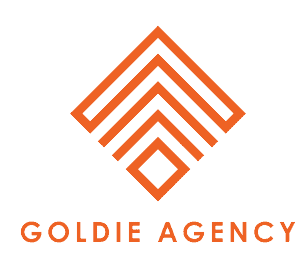
Link Building Case Study: SaaS Website Jumps From 0 to 145,000 Visitors P/Month With Backlinks!
- May 17, 2021

They hired us to build high quality backlinks that would actually increase their rankings, drive more traffic and help rank on the first page of Google.
HOW WE HELPED
We focused on HARO link building:
A way of pitching journalists to land backlinks from real websites with a lot of authority.
In fact, our client was so happy with the results they even hired us for 2 of their other websites:
We even landed them backlinks from Forbes!
HARO is one of the best platforms to land backlinks right now:
But it’s not easy to scale.
We’ve created a link building system around HARO that build backlinks at scale and helps you grow your website.
THE RESULTS
In less than 6 months of link building, their site saw a HUGE increase in traffic.
They went from ZERO organic visitors per month to 145,000+ per month.
If you gained 145,000+ visitors from Google per month, can you imagine what that could do for your business?

The link building package paid for itself 10X in the number of sales, customers and revenue gained from this traffic increase.
The ROI was HUGE:
And to get the same amount of traffic from PPC would literally cost hundreds of thousands of dollars.
WHAT THE CLIENT SAID:
“Julian’s link building techniques had a big impact on our site’s rankings. Overall we increased our traffic, ranked higher and gained some high quality backlinks.
If you want backlinks that actually work, then you’ll love his agency.”

Schedule A Call:
If you’d like to boost your SEO rankings, drive more traffic & land more customers with link building, please book in a call below:
Related Posts:

Julian Goldie
Hey, I'm Julian Goldie! I'm an SEO link builder and founder of Goldie Agency. My mission is to help website owners like you grow your business with SEO!
How to Buy Expired Domains with Traffic and Quality Content
Best seo tools 2024, link building case study: saas website 4x their organic traffic in just 4 months.
With a team of 70+ people, our link building agency has over 5 years experience building backlinks for SEO, working with hundreds of clients to grow their websites with SEO.
- Facebook Group
- Our Case Studies
- Privacy Policy
- Terms of Service
Address : GOLDIE AGENCY PTE. LTD. 160 robinson road #14-04 Singapore 068914 Reg no: 202007996N
Tel: +1 6083054549

WANT TO BOOST YOUR SEO TRAFFIC, RANK #1 & GET MORE CUSTOMERS?
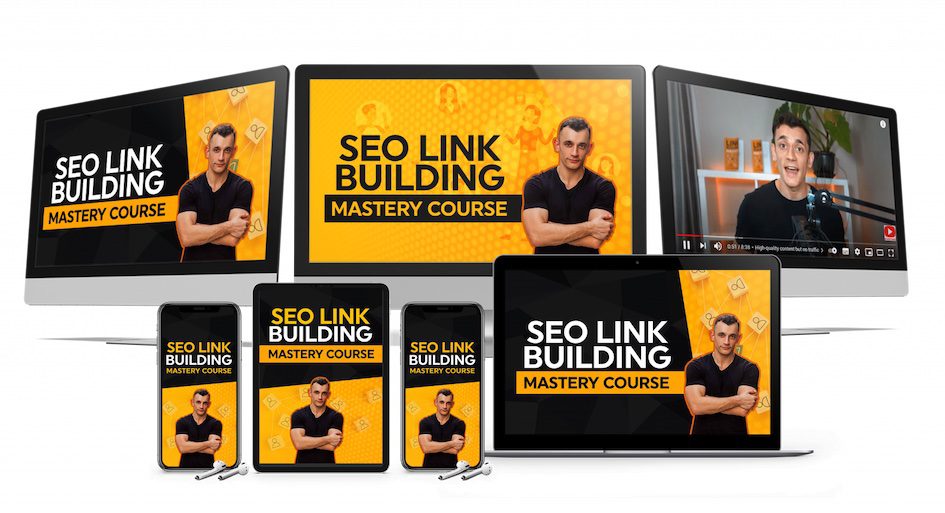

Case Studies
- Testimonials
Getting Started
Seo case studies, keyword research, content creation, on page seo, link building, penalties & updates, general seo, seo tools & reviews.

SEO Checklist: 45x Ways To Increase Your Search Traffic

What Is SEO And Why You MUST Pay Attention To It!

How Many Backlinks Do I Need To Rank?

How Do Search Engines Work? What You Need To Know

These Are The Best SEO Tools That Money Can Buy

27 Google Tools You Should Know About

From Google Penalty To 5x Search Traffic

Growing Revenue $17,122 To $92,119 Per Month

How To Triple Ecommerce Revenue

+73% Search Traffic With These 6 Fixes

Ecommerce SEO Case Study: 3x Revenue In 90 Days

How To 14x Search Traffic In 8x months
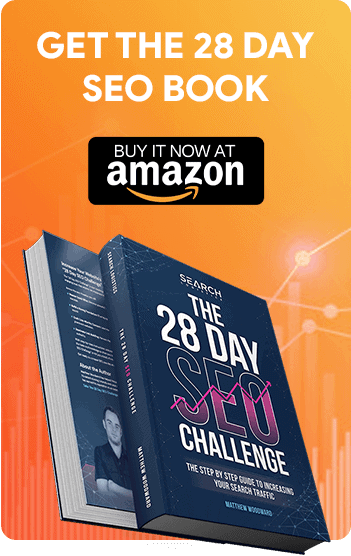
Download My Intelligent Keyword Research Template Now

These 7x Types Of Keywords Will Increase Your Search Traffic

How To Use Buyer Keywords To Boost Your Sales

Keyword Research: The What, Why & How

The Best Keyword Research Tools (And How To Use Them)

Google Keyword Planner: How To Use It The Right Way

Take The 28 Day SEO Challenge Now

How To Write Killer Website Content That Attracts People

18 SEO Copywriting Hacks That Get Instant Results

How To Write A Listicle That Attracts Traffic & Backlinks

How To Increase Search Visibility With FAQ Schema

What Is On Page SEO? How To Perfectly Optimise Your Page

6x Free Ways To Increase Website Speed (and search traffic!)

The Ultimate On Page SEO Checklist To Increase Rankings

The Hidden SEO Ranking Factor You’re Probably Deleting

3x Ways A Silo Structure Will Boost Your Search Traffic

15x Incredible Link Building Strategies

Link Building Services: What You REALLY Need To Know

Backlink Analysis – The Easiest Ways To Build Links

Podcast Jacking For Links, Traffic & Authority

8x Ways To Build Powerful Edu Backlinks

Testimonial Link Building: Powerful Homepage Links

7 Google Penalty Checker Tools

The Step By Step Process To Recover From Any Penalty

Google Page Experience Update Checklist

Drop In Search Traffic? Watch This Video Now!

How To Get Out Of Google Sandbox As Quickly As Possible

How To Improve Your Core Web Vitals In 15 Minutes

How To Exclude Words From Google Search Results

Testing The 12 Fastest WordPress Hosting Providers

Learn How To Find Powerful Expired Domains Step By Step

The Fastest & Easiest Way To Get Wikipedia Backlinks

The Ultimate Guide To Search Engine Submission

SEMRush Review: How To Increase Search Traffic

Surfer SEO Review - How I Used It To Win The #1 Position

NitroPack Review & Case Study

WPX Hosting Review – Faster Than You Might Think

My Kinsta Hosting Review & Case Study

5 Guest Posting Services You Can Rely On
Zero link building case study: 44% increase in traffic, zero links: +44% search traffic, campaign challenges:.
- Finding content gaps
- Optimising on-page SEO of service pages
- General improvements to technical SEO
Campaign Results:
Organic Traffic
Top 10 Results

🔥 Increase your traffic with the 100% free 28 Day SEO Challenge .
There are a number of simple ways to increase search traffic for just about any site in any niche.
But the heart and soul of any long term SEO strategy , comes from content.
So I want to show you how we increased this B2B clients monthly search traffic from 5.4k to 7.8k without building any links !

All we did was focus on
- Creating new content to fill the “content gap”
- Optimising service page content
- Fixing some technical SEO issues
All of that led to a 44% increase in monthly search traffic with zero link building .
This is how we did it…
What Will I Learn?
A Closer Look At The Case Study Site

About 12 months ago, the client came to us with new goals to expand their business.
So, we sat together and set two ambitious targets for their SEO campaign:
- Goal #1 -Increase the number of keywords in the top 10 from 2,500
- Goal #2 – Increase qualified search traffic to the site
With that in mind, our team developed a new SEO strategy to help our client increase their brand awareness and grow their business simultaneously.

The Biggest Challenges We Had to Overcome
The client operates in a constantly shifting industry but hadn’t published new content for a long time.
This was in stark contrast to their competitors who were publishing new content regularly and keeping pace with the ever changing niche.
So to combat that we needed to:
- Complete a content gap analysis
- Subscribe to relevant news/media outlets
That meant we could keep our finger on the pulse of the industry and stay ahead of the game with new high quality content.
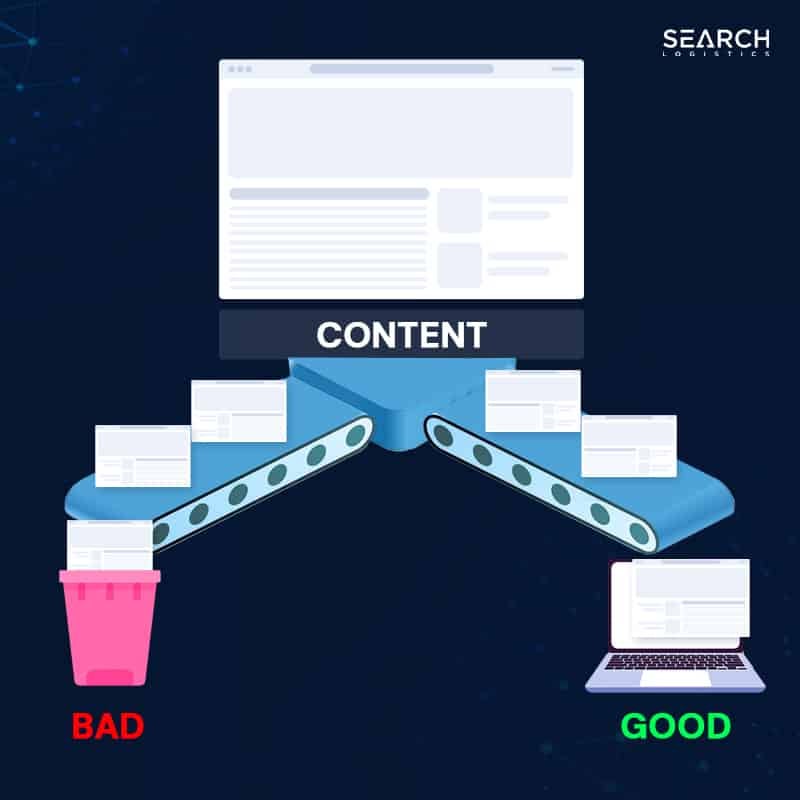
But that’s not all…
The client had added several new service pages to the site that had been struggling to rank.
This was a huge pain point because these were important money pages that generated real revenue for the client.
So, we focused on making sure that the content and on-page elements of these pages were optimised for the service-related keywords they wanted to rank for.
The final challenge was to continue improving the website’s technical elements.
The two main issues were:
- Optimising the images on the website to improve loading times
- Ensuring canonical tags were correctly implemented
This was to resolve problems related to duplicate content.
Here is a recap of the main challenges our team identified:
- Identifying content gaps between the client’s website and their competitors
- Optimising the on-page elements of the service pages to improve rankings for relevant keywords
- Improving the technical elements of the website by optimising page speed and implementing canonical tags to prevent duplicate content
Creating A Plan Of Attack
With the challenges laid out clearly, it was time for our team to create a plan of attack to address each issue individually.
Below are the exact steps we took to fix all of the issues.
Feel free to take notes for your own website. We wrote each step out clearly so you can apply them to your own site.
Step #1 – Identify Content Gaps Through Competitor Research
If you don’t have your finger on the pulse of your industry – you will get left behind.
That’s just the nature of any competitive business.
Adjusting your content to the changes in your industry is a surefire way to know that you are satisfying your visitor’s search intent.
And the proof is being rewarded by Google with higher rankings and more organic traffic.
Who doesn’t want that, right?
Finding content gaps between:
- Your website
- Your competitors
…allows you to build your keyword visibility.
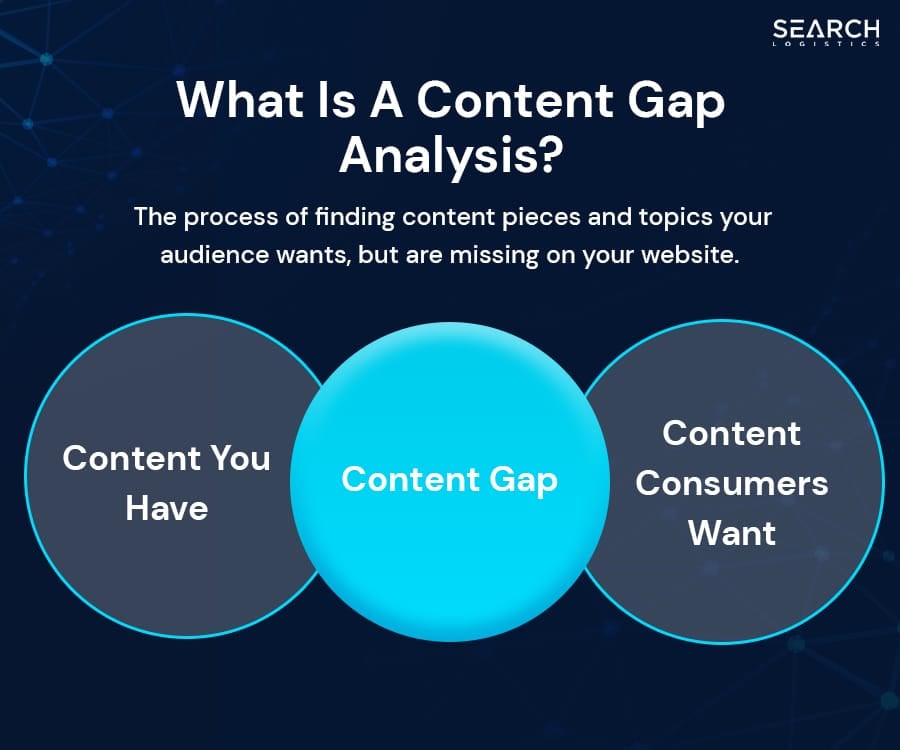
It also helps build your topical authority and expertise within your niche.
Topical authority is a holistic SEO strategy that every website owner who is serious about SEO should be using.
Here’s how to do it:
Identify Keywords And Topic Gaps Using Ahrefs
Ahrefs’ Content Gap tool shows you the keywords your competitors are ranking for, but you’re not.
Think of it like a “checklist” that points out every keyword you still need to cover.
The best part is that it’s simple to use:
Input your competitors’ domains into the Ahrefs Content Gap tool and click “Show Keywords” .

You can include up to 10 competitors, but start with your top 3-4 so you don’t get overwhelmed.
This will reveal the keyword opportunities worth targeting to bridge the gap with your competitors.
It’s worth noting that not all of these keywords will be relevant to your own website.
Make sure to filter the results and select the relevant keywords to your site.

Condense the results further by increasing the number of intersections.
Instead of just one competitor, look at the keywords where more than one of your competitors ranks.
These are the main keywords you want to target first.

We can see that the results now show just under 3,000 keywords, instead of the original 30,000.
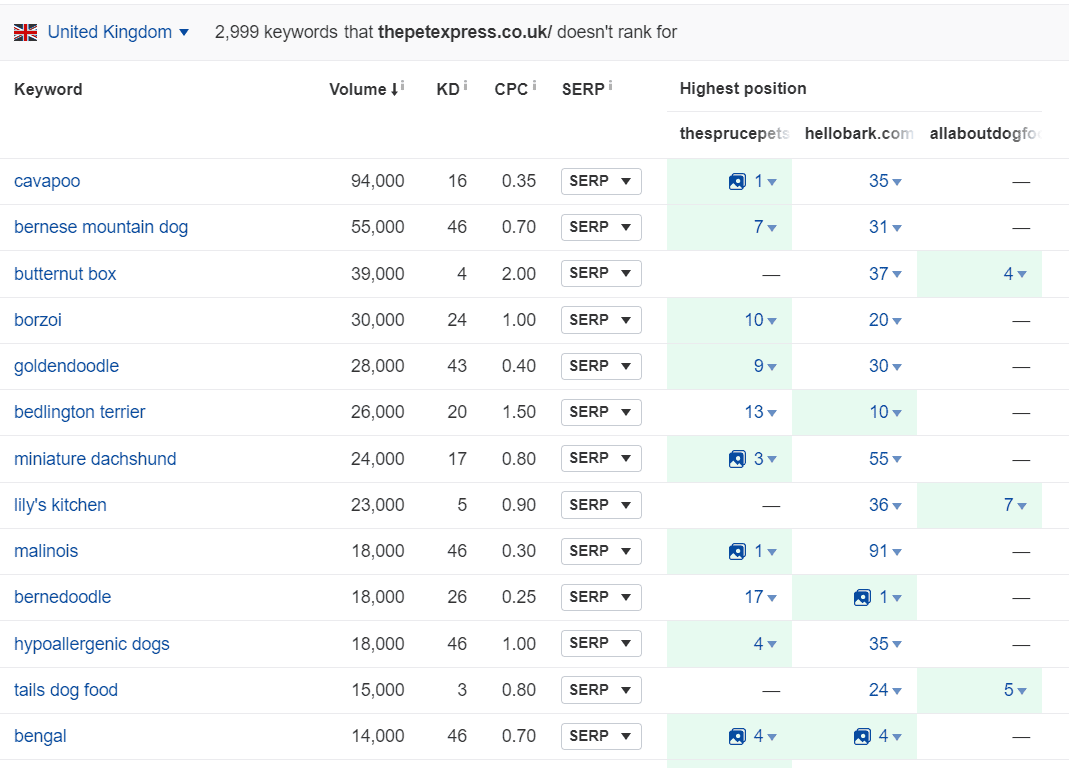
That’s a better number to work with!
Make sure you manually work your way down the list to choose keywords that best fit your website.
That will ensure you don’t miss any hidden gems.
Once you’ve identified the keywords, look at the top-ranking competing pages in the SERPs to see what you are up against.
You might already have a relevant page for the keyword – you just need to optimise.
Don’t have an existing page/post that fits the keyword?
It’s time to create a brand new page or piece of content that:
- Matches the searcher’s intent
- Is better than your competitor’s content
Find Content That You Need to Publish
Your competitors’ blogs are a goldmine for finding new keywords to target and content to publish.
Simply put:
If they rank for a keyword, you already have a blueprint of what Google is looking for.
You just need to take advantage of it!
There are two ways to get keyword ideas from your competitors:
- Perform a manual review of your competitor’s website
- Use Ahrefs Site Explorer.
Enter your competitor’s blog domain (select “path” mode) and go to the “Top pages” report.

Ahrefs shows you all the blog posts on the competing domain’s website that bring in the most traffic.
Now it’s easy to identify which topics are worth pursuing for your own blog.
Cool, right?
Step #2 – Service Page Optimisation
With the content gaps being filled in by our content writing team, it was time to focus on optimising the client’s service pages.
This was an important part of the campaign because these pages are extremely valuable to the client.
They had recently added service pages that were struggling to rank.
Note : For ecommerce stores, important pages you need to pay regular attention to are new product ranges or collection pages that need optimising in time for their seasonal peak.
Here are the three things you must pay attention to:
Start With The Basics
Ensure that on-page elements such as the:
- Meta description
… are optimised for the main keyword you want to rank for.

The page title, H1 heading and meta description should also be descriptive and engaging enough to entice users to click through to your page from the Google search results.
Identify Content Gaps On The Page
Once you’ve got the basics down, focus on optimising the content itself.
Identify the top-ranking competitors by doing a Google search for your target keyword and looking at which ones are closest to your existing page.
In our case, we looked at pages that were ranking high for the same service.
When analysing the competing pages, there are 5 questions to ask yourself:
- Does the competing page have a better outline and heading structure?
A well-structured page improves Google’s understanding of the content and makes it much easier for users to find what they want.
- Has the competing page included content that is missing from my page?
This can be anything from entire sections to a frequently asked questions section.
- Has the competing page included other types of content to enhance the page?
- Is the competing page’s content easier to read?
- Does the competing page avoid having elements that impede the user experience?
Identifying the gaps in your content can be the difference between ranking on page 1 and not at all.
Google is all about a quality user experience – so keep that in mind.
Consider Other Factors
Apart from the content, there may be other areas that you need to optimise to outperform your competition.
This may include:
Indexing issues
It’s always worth doing a simple check to ensure that your page is crawlable and indexable by Google.
Go to Google and do the following search:
site:yourdomain.com/your-page/
If your page doesn’t show up, then it’s not indexed.
Ensure that it isn’t blocked by your robots.txt file, is present on your XML sitemap and doesn’t include a noindex tag in the source code.
Structured data
Structured data (or schema markup) is code that allows Google to understand specific elements on your page.
It also increases the chances of ranking as a featured snippet.
You can check whether the competing page has included structured data using any of these schema testers .

Make sure you follow our complete rich snippet guide to give your website the best chance of winning a featured snippet.
Internal linking
Google uses internal links to find and index new content on your site.
Internal linking is a powerful tactic that you can use to guide the search engine’s crawlers towards your pages whilst also improving the overall navigation of your website for users.
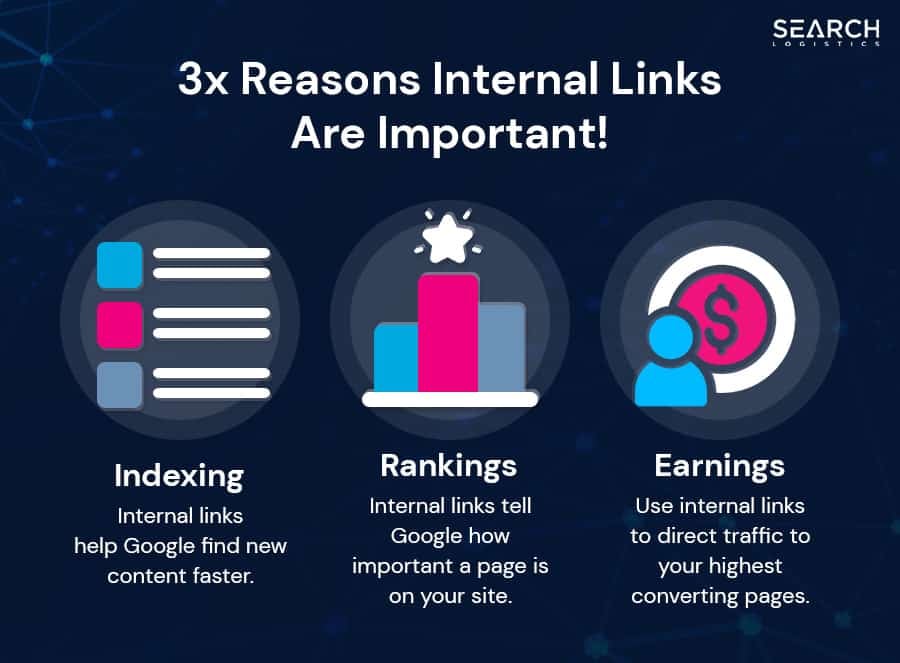
Add internal links from other relevant pages on your site to the one you are optimising. Make sure you use keyword-rich anchor text for the links.
Need help with internal linking?
Check out our complete internal link building tutorial to get this underrated tactic working for your site.
Step #3 – Fixing Technical Issues
The final issue we needed to address was fixing technical issues preventing the site from ranking to its full potential.
Yes, ranking potential is a real thing.
And it can be the difference between thousands of visitors per month.
We conduct a full technical SEO audit on each of our client’s sites every 6 – 9 months. It’s the only way to be sure that each client’s site is optimised correctly.
Most website owners don’t bother with this and it can really cause some damage in future Google updates.
Being lazy now will impact your results later.
During our most recent audit for our client, we found two essential areas that needed to be addressed:
- Image optimisation
- Canonical tags
Here’s how to fix them both.
Image Optimisation
Big images slow down your website speed .
Our client had hundreds of images over 100 kb in size, costing them tons of time in page load speed.
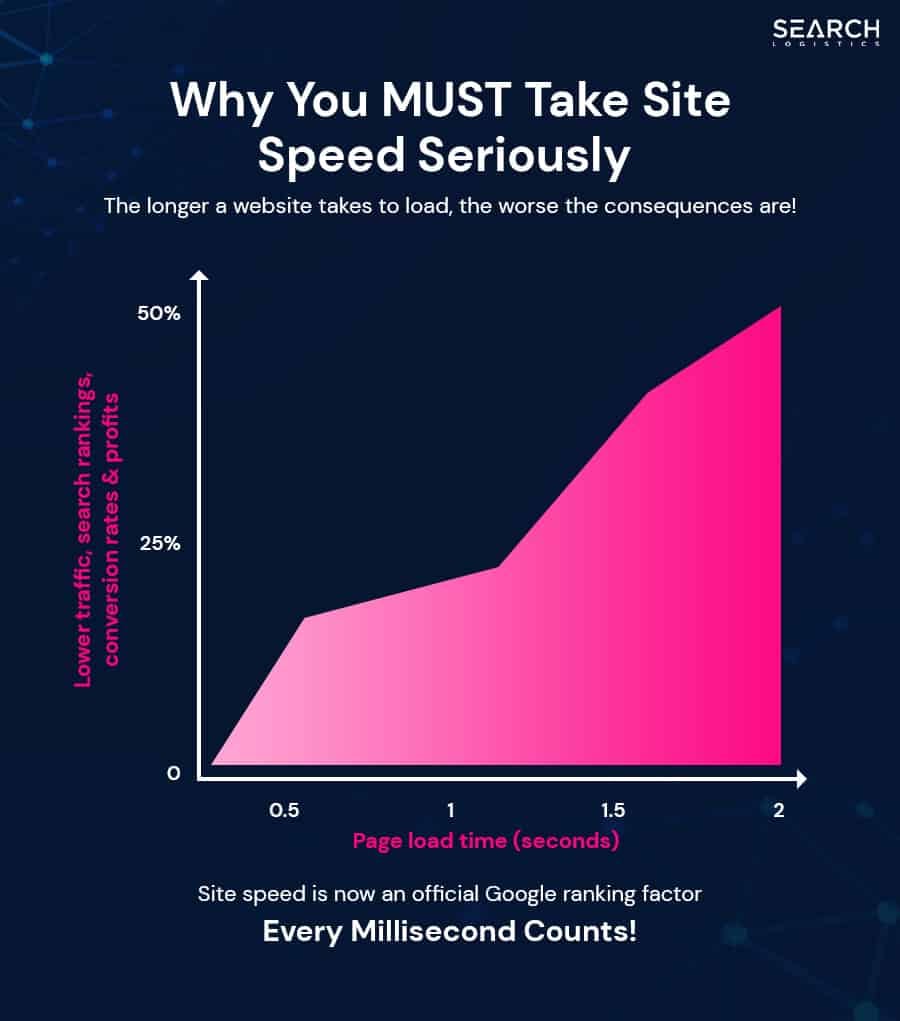
There are two techniques that you can use to reduce the loading times of images:
- Compression
- Lazy loading
We recommend using both if you are serious about improving your website page load speeds.
The best part?
You don’t need to manually do anything. There are a number of tools and plugins that will take care of it for you.
Image Compression
You want to compress your images to load quicker, but you don’t want to damage the image quality.
There are a ton of image compression tools available online. But there are only a few we can confidently recommend:
- GIMP – A downloadable image editor
- TinyPNG – Uses lossy compression techniques to reduce the file size of both PNG and JPG files
- Smush – Image compression and optimisation plugin for WordPress
- Imagify – An online tool and WordPress plugin for image optimisation
Look at each of them and choose what works best for your site.
Each tool is designed to take the hard work out of image compression!
Lazy-Loading Images
Next is lazy-loading the images on the site.
Think of lazy loading as a way to show your images to your site visitors when they need them.
As the visitor scrolls down the page, the images gradually load in.
This means that visitors don’t have to wait for all images on the page to load before they start reading your content.

Pretty cool, right?
Lazy load also helps to:
- Reduce unnecessary network requests
- Conserve bandwidts
Make sure you check out our complete increase website speed tutorial to learn more about lazy loading images and speeding up your website in general.
Canonical Tags
Next up was to fix the Canonical tags .
These tags can be a pain to deal with if you don’t take the time to understand what they are or how they work.
Canonical tags are a type of HTML element used to prevent duplicate content issues in SEO.
They inform search engines which version of a page to prioritise or consider as the “master” when multiple versions exist.

This ensures search engines understand which page to index and rank in the search results.
Canonical tags also help reduce ranking signals and avoid potential penalties for duplicate content.
As you can see – they are pretty important!
This is what a canonical tag looks like:
<link rel=”canonical” href=”https://www.example.com/preferred-url”>
Feeling overwhelmed?
Don’t be. It’s simpler than it might first seem.
Let’s break down the elements of a canonical tag:
- <link> : This is an HTML tag used to define a link between the current web page and another resource. In the case of a canonical tag, it establishes a relationship between different versions of the same content.
- rel= “canonical” : The rel attribute specifies the relationship type between the current page and the linked page. In this case, the value “canonical” indicates that the linked page is the preferred or canonical version.
- href= “https://www.example.com/preferred-url” : The href attribute specifies the URL of the preferred version of the webpage. It should point to the specific URL that you want search engines to treat as the primary version.
Not so difficult, right?
When implementing canonicals, here’s what you need to do:
- Use accurate and consistent URLs :
Ensure that the canonical tag points to the correct, canonical version of the page. The URL should reflect the preferred URL that you want search engines to index and rank. Ensure that all variations (such as HTTP vs. HTTPS, www vs. non-www) consistently use the same canonical URL. This avoids diluting the canonical signal and potential confusion for search engines.
- Remember to add self-referencing canonical tags :
Each page should have a self-referencing canonical tag. This means that if a page is the preferred version itself, the canonical tag should point to its own URL. This helps reinforce the canonical signal and avoids confusion.
- Use unique canonical tags :
- Proper implementation across duplicate content :
Canonical tags should be implemented on all versions of a page with duplicate content, including similar or alternate versions (such as pagination or printer-friendly pages). This helps consolidate ranking signals and avoid duplicate content penalties.
- Carry out regular audits:
If you need more information, check out our full canonicalization article.
It has everything you need to better understand canonical tags and how to use them for SEO.
The Results Are In
Over the past year, we exceeded our goal by increasing monthly search traffic from 5.4k to 7.8k.
That’s 44% growth without building any links:
Likewise, the site is now ranking for 6,694 keywords in the top 10 pages of the search results compared to 2,532 last year – representing an increase of 164%.

The client was super happy and so was our team!
These are big results considering the nature of the client’s industry and how competitive it was.
Click Here To Learn More About What We Do
Wrapping It Up
Here’s the takeaway:
It usually takes about 9-12 months before you start to see an ROI.

But the payoff is worth it.
The key is to focus on holistic SEO strategies that are proven to stand the test of time. The most significant factor in this case study was creating great content to fill in content gaps.
As a recap, here are the 3 main steps our team took to deliver these results:
- Identified content gaps with a competitor analysis and created great content to fill those gaps
- Optimised the core service landing pages on the website so they ranked in the top positions on Google
- Fixed the technical SEO issues on your website, which included optimising images and implementing canonical tags to avoid duplicate content issues
The best part is each of these steps is universal.
That means you can take and apply them directly to your own website to achieve similar results.
Need help with the SEO for your own website? Get in touch with us here .

Link building you will be proud of.

We take full control of your traffic.
Learn Portal
Free SEO tutorials to increase your traffic.
What Are Your Thoughts?
4 responses.
Nice article you share very informative content
The image stuff is cool, and lazy loading is new to me, but it sounds interesting. I’ve tried TinyPNG before, and it worked. Anyway, I found a cooler tool for making images smaller called Riot. It’s fast, works without the internet, and beats TinyPNG in speed.
Thanks for letting me know!
Leave a Reply Cancel reply
Your email address will not be published. Required fields are marked *
Save my name, email, and website in this browser for the next time I comment.

SEO Content Optimization Case Study: $6.3k to $37.3k Monthly Organic Revenue
In this case study, you’ll see how we grew our client’s monthly organic revenue by 493% after optimizing key pages.
Monthly Revenue

SaaS SEO Case Study: 223% More Traffic After A Site Migration
In this case study, you’ll see how we grew our client’s organic traffic by 288% after implementing a complete site migration.
Top 10 Rankings

Gambling SEO Case Study: +180% Increase in Conversions
In this case study, you’ll see how we more than doubled our gambling client’s monthly sessions from 52k visits to over 77k in just 12 months.
Conversions

Casino SEO Case Study: +889% Organic Search Traffic
In this case study, you’ll see the exact strategy we used to grow our gambling client’s organic traffic by over 800%.

SEO Audit Case Study: 1.4M Visitors in 6 Months
These are the 4 steps we followed to drive our clients websites to 1.4M visitors in just six months without building any links!
Organic Visitors

How This Site Beat The May 2022 Core Update
This SEO case study shows you how we beat the May 2022 core update to increase search traffic by 111% and revenue by 51% per month.
Organic Revenue

SEO Case Study: From Google Penalty To 5x Search Traffic
We’ll show you how we recovered our client’s coupon websites search traffic after it was destroyed by Google’s May 2020 core algorithm update.

Ecommerce SEO Case Study: $17,122 To $92,119 Per Month
We’ll show you the SEO strategy we used to increase revenue by 438% for an ecommerce health brand, whilst facing heavy competition.

SEO Case Study: +73% Search Traffic With These 6 Fixes
In this SEO case study, see the 6 technical SEO problems we fixed to increase search traffic by 78% and revenue by 28%.
SEO Case Study – A Core Update Recovery
Core updates have the potential to destroy your SEO. We’ll show you how we recovered our client’s website from a huge Google core algorithm update.

Discover how we 3x a client’s revenue from organic search in just 90 days by focussing on fixing big SEO issues that were holding the site back.

SEO Case Study: From 920 to 13,503 Visitors Per Month
See how we increased our client’s search traffic by 1,367%, including the big challenges we faced & the strategies we used to overcome them.
Monthly Visitors

Ecommerce SEO Case Study: How To Triple Revenue During Covid-19
Discover how our team increased monthly sales to £109,377 for our client during COVID & lockdowns despite the fact they’re in the sports niche.

SEO Case Study: +488% Search Traffic
Learn how we increased monthly search traffic from 5,156 to 30,347 in the highly competitive gambling niche by taking a different approach to SEO.
Daily Visitors

SEO Case Study: 656 Top 3 Rankings
Learn how we won 656 top 3 rankings with 1,951 keywords listed on the first page with our SEO case study. The result was 498% traffic growth.
Top 3 Rankings

SEO Case Study: How To 14x Search Traffic In 8x months
See exactly how we took search traffic from 2,732 visitors per month to 38,420 in just 8x months in this detailed SEO case study.

[CASE STUDY] How To Rank In The Most Competitive Niche In SEO
Learn the link building & SEO strategy behind 53,000 visitors per month in one of the most competitive niches.

Doubled Search Traffic SEO Case Study
This client runs an ecommerce store that sells pet products and were not ranking for any kind of commercial terms to begin with.
Top 5 Rankings

How We Tripled Revenue For This Real Estate Agent
This client works in the highly competitive world of real estate and was spending a small fortune every month.

Ecommerce SEO Case Study: Highest Revenue For 2 Years In 6 Months
The site was already established but it had a range of issues and was losing traffic and revenue for over a year before we started working on it.

SEO Case Study: How To Remove A Penalty Within A Month
This site was hit with a manual penalty from Google so we had to act fast. We cleaned up the site and had our reconsideration request accepted first time.
Number 1 Rankings

Ecommerce SEO Case Study: +369% Organic Revenue
Learn how we beat big brand competitors to increase this furniture stores e-commerce revenue by 369%.

Ecommerce SEO Case Study: 500,000+ Visitors After Penguin Penalty
Learn how we managed to overcome the Penguin penalty and bring this sites search traffic to record levels.
How Can We Help?
If you need help increasing your search & sales or recovering from a penalty please fill out\ the form below and one of our search specialists will review your site-
- First Name * First
- SEO Budget * $3,500+ $4,500+ $7,000+ $10,000+
- Is there anything else we should know?
- Hidden GAID
- Comments This field is for validation purposes and should be left unchanged.
- Do Not Sell My Personal Info

- ⋅
- Content Marketing
35 Content Marketing Statistics You Should Know
Stay informed with the latest content marketing statistics. Discover how optimized content can elevate your digital marketing efforts.

Content continues to sit atop the list of priorities in most marketing strategies, and there is plenty of evidence to support the reasoning.
Simply put, content marketing is crucial to any digital marketing strategy, whether running a small local business or a large multinational corporation.
After all, content in its many and evolving forms is indisputably the very lifeblood upon which the web and social media are based.
Modern SEO has effectively become optimized content marketing for all intents and purposes.
This is when Google demands and rewards businesses that create content demonstrating experience, expertise, authoritativeness, and trustworthiness (E-E-A-T) for their customers – content that answers all of the questions consumers may have about their services, products, or business in general.
Content marketing involves creating and sharing helpful, relevant, entertaining, and consistent content in various text, image, video, and audio-based formats to the plethora of traditional and online channels available to modern marketers.
The primary focus should be on attracting and retaining a clearly defined audience, with the ultimate goal of driving profitable customer action.
Different types of content can and should be created for each stage of a customer’s journey .
Some content, like blogs or how-to videos, are informative or educational. Meanwhile, other content, like promotional campaign landing pages , gets to the point of enticing prospective customers to buy.
But with so much content being produced and shared every day, it’s important to stay updated on the latest trends and best practices in content marketing to keep pace and understand what strategies may be most effective.
Never has this been more true than in 2024, when we’re in the midst of a content revolution led by generative AI , which some feel represents both an opportunity and a threat to marketers.
To help you keep up, here are 35 content marketing statistics I think you should know:
Content Marketing Usage
How many businesses are leveraging content marketing, and how are they planning to find success?
- According to the Content Marketing Institute (CMI), 73% of B2B marketers, and 70% of B2C marketers use content marketing as part of their overall marketing strategy.
- 97% of marketers surveyed by Semrush achieved success with their content marketing in 2023.
- A B2B Content Marketing Study conducted by CMI found that 40% of B2B marketers have a documented content marketing strategy; 33% have a strategy, but it’s not documented, and 27% have no strategy.
- Half of the surveyed marketers by CMI said they outsource at least one content marketing activity.
Content Marketing Strategy
What strategies are content marketers using or finding to be most effective?
- 83% of marketers believe it’s more effective to create higher quality content less often. (Source: Hubspot)
- In a 2022 Statista Research Study of marketers worldwide, 62% of respondents emphasized the importance of being “always on” for their customers, while 23% viewed content-led communications as the most effective method for personalized targeting efforts.
- With the increased focus on AI-generated search engine results, 31% of B2B marketers say they are sharpening their focus on user intent/answering questions, 27% are creating more thought leadership content, and 22% are creating more conversational content. (Source: CMI)
Types Of Content
Content marketing was synonymous with posting blogs, but the web and content have evolved into audio, video, interactive, and meta formats.
Here are a few stats on how the various types of content are trending and performing.
- Short-form video content, like TikTok and Instagram Reel, is the No. 1 content marketing format, offering the highest return on investment (ROI).
- 43% of marketers reported that original graphics (like infographics and illustrations) were the most effective type of visual content. (Source: Venngage)
- 72% of B2C marketers expected their organization to invest in video marketing in 2022. (Source: Content Marketing Institute – CMI)
- The State of Content Marketing: 2023 Global Report by Semrush reveals that articles containing at least one video tend to attract 70% more organic traffic than those without.
- Interactive content generates 52.6% more engagement compared to static content. On average, buyers spend 8.5 minutes viewing static content items and 13 minutes on interactive content items. (Source: Mediafly)
Content Creation
Creating helpful, unique, engaging content can be one of a marketer’s greatest challenges. However, innovative marketers are looking at generative AI as a tool to help ideate, create, edit, and analyze content quicker and more cost-effectively.
Here are some stats around content creation and just how quickly AI is changing the game.
- Generative AI reached over 100 million users just two months after ChatGPT’s launch. (Source: Search Engine Journal)
- A recent Ahrefs poll found that almost 80% of respondents had already adopted AI tools in their content marketing strategies.
- Marketers who are using AI said it helps most with brainstorming new topics ( 51%) , researching headlines and keywords (45%), and writing drafts (45%). (Source: CMI)
- Further, marketers polled by Hubspot said they save 2.5 hours per day using AI for content.
Content Distribution
It is not simply enough to create and publish content.
For a content strategy to be successful, it must include distributing content via the channels frequented by a business’s target audience.
- Facebook is still the dominant social channel for content distribution, but video-centric channels like YouTube, TikTok, and Instagram are growing the fastest . (Source: Hubspot)
- B2B marketers reported to CMI that LinkedIn was the most common and top-performing organic social media distribution channel at 84% by a healthy margin. All other channels came in under 30%.
- 80% of B2B marketers who use paid distribution use paid social media advertising. (Source: CMI)
Content Consumption
Once content reaches an audience, it’s important to understand how an audience consumes the content or takes action as a result.
- A 2023 Content Preferences Study by Demand Gen reveals that 62% of B2B buyers prefer practical content like case studies to inform their purchasing decisions, citing “a need for valid sources.”
- The same study also found that buyers tend to rely heavily on content when researching potential business solutions, with 46% reporting that they increased the amount of content they consumed during this time.
- In a recent post, blogger Ryan Robinson reports the average reader spends 37 seconds reading a blog.
- DemandGen’s survey participants also said they rely most on demos ( 62% ) and user reviews (55%) to gain valuable insights into how a solution will meet their needs.
Content Marketing Performance
One of the primary reasons content marketing has taken off is its ability to be measured, optimized, and tied to a return on investment.
- B2C marketers reported to CMI that the top three goals content marketing helps them to achieve are creating brand awareness, building trust, and educating their target audience.
- 87% of B2B marketers surveyed use content marketing successfully to generate leads.
- 56% of marketers who leverage blogging say it’s an effective tactic, and 10% say it generates the greatest return on investment (ROI).
- 94% of marketers said personalization boosts sales.
Content Marketing Budgets
Budget changes and the willingness to invest in specific marketing strategies are good indicators of how popular and effective these strategies are at a macro level.
The following stats certainly seem to indicate marketers have bought into the value of content.
- 61% of B2C marketers said their 2022 content marketing budget would exceed their 2021 budget.
- 22% of B2B marketers said they spent 50% or more of their total marketing budget on content marketing. Furthermore, 43% saw their content marketing budgets grow from 2020 to 2021, and 66% expected them to grow again in 2022.
Content Challenges
All forms of marketing come with challenges related to time, resources, expertise, and competition.
Recognizing and addressing these challenges head-on with well-thought-out strategies is the best way to overcome them and realize success.
- Top 3 content challenges included “attracting quality leads with content” ( 45% ), “creating more content faster” (38%), and “generating content ideas” (35%). (Source: Semrush’s The State of Content Marketing: 2023 Global Report)
- 44% of marketers polled for CMI’s 2022 B2B report highlighted the challenge of creating the right content for multi-level roles as their top concern. This replaced internal communication as the top challenge from the previous year.
- Changes to SEO/search algorithms ( 64% ), changes to social media algorithms (53%), and data management/analytics (48%) are also among the top concerns for B2C marketers.
- 47% of people are seeking downtime from internet-enabled devices due to digital fatigue.
- While generative AI has noted benefits, it also presents challenges for some marketers who fear it may replace them. In Hubspot’s study, 23% said they felt we should avoid using generative AI.
- Another challenge with AI is how quickly it has come onto the scene without giving organizations time to provide training or to create policies and procedures for its appropriate and legal use. According to CMI, when asked if their organizations have guidelines for using generative AI tools, 31% of marketers said yes, 61% said no, and 8% were unsure.
Time To Get Started
As you can clearly see and perhaps have already realized, content marketing can be a highly effective and cost-efficient way to generate leads, build brand awareness, and drive sales. Content, in its many formats, powers virtually all online interactions.
Generative AI is effectively helping to solve some of the time and resource challenges by acting as a turbo-powered marketing assistant, while also raising a few procedural concerns.
However, the demand for content remains strong.
Those willing to put in the work of building a documented content strategy and executing it – by producing, optimizing, distributing, and monitoring high-value, relevant, customer-centric content, with the help of AI or not – can reap significant business rewards.
More resources:
- 6 Ways To Humanize Your Content In The AI Era
- Interactive Content: 10 Types To Engage Your Audience
- B2B Lead Generation: Create Content That Converts
Featured Image: Deemak Daksina/Shutterstock
Jeff has been helping organizations manage, measure and optimize their Web presences for over 20 years. He has deep knowledge ...
Subscribe To Our Newsletter.
Conquer your day with daily search marketing news.

IMAGES
VIDEO
COMMENTS
To do this, we first went to the Backlinks report for the page, toggled the "one link per domain" filter, then searched for each statistic in the link anchors and surrounding texts. For the "93%" statistic, over 700 websites were linking to the page. That's the first box checked.
There are 3 steps to The Skyscraper Technique. And I go over all of them in this short-and-sweet video: Like I mentioned in the video above, here are the 3-steps that make up The Skyscraper Technique: Step 1: Find link-worthy content. Step 2: Make something even better. Step 3: Reach out to the right people.
Measuring link performance using SEO-related metrics. This is one of the most challenging aspects of a campaign for myriad reasons. It's also one of the most effective ways to retain clients. There are a number of ways to track the performance of a link-building campaign; which methods are chosen largely depends on the tactics deployed.
Case Study #2 Broken Link Building Pays Off. Last year I decided to run a broken link building campaign. So I followed the steps that I outlined in the last chapter. First, I used search strings to bring up pages with lots of outbound links. And I used Check My Links to find links that weren't working.
Best SEO Case Studies: 1. How I Increased My Organic Traffic 652% in 7 Days 2. SEO Investment Google Search Central Case Study 3. How to Create a Squeeze Page That Converts at 74.5% 4. From 126 to 121,883 Unique Visitors in Under 6 Months 5. Ranking in 24 Hours in the Competitive SEO Niche 6. From 0 to 75,000 Visits A Year 7. How We 4x'd Traffic and Doubled Revenue in E-Commerce 8. 6-Step ...
Case Study #1: E-commerce Brand Achieves Remarkable Growth. Case Study #2: "Insane 10x growth in organic traffic achieved in 6 months for highly competitive keywords!". Case Study #3: 10x Organic Growth For A Cannabis Brand. Case Study #4: Improved 10x Leads and Traffic in 2-3 Months. Case Study #5: The Remarkable Journey of a Vape E ...
In this 3-part series, you'll learn how Ahrefs created a SEO statistics blog post and built links to the page step-by-step. Episode 1 In Episode 1, you'll ...
There's a SEO strategy that's crushing it right now. ("Skyscraper Technique 2.0") I used this strategy to increase organic traffic to one of my pages by 652.1%: (In 7 days!) This same approach helped my brand new post hit the #1 spot in Google… within weeks: And today's SEO case study I'm going to show you exactly how I did it ...
Additional links were secured through the following link-building tactics: Employee quotes. Newsworthy partnerships. Interviews. Business announcements (e.g., IPO filing, investments, promotions ...
The site's main keyword had jumped from #7 to #1 overnight, resulting in a 2,000% increase in traffic. Four months of link building had paid off in spades. And no, a 301-redirect was NOT used. Apparently, SEO and link building fundamentals are still being rewarded by Google with much more than just coal.
The SEO link building case studies on this page demonstrate how our ethical, white-hat techniques for acquiring contextual backlinks drove increased organic visibility, traffic, and sales. Earning high-quality backlinks remains crucial for ranking highly in search results. Our proven link-building services have delivered impressive results ...
Case Study #2: Chris Tzitzis' Link Building Efforts for a Client Website. Chris Tzitzis, another SEO expert, helped further elevate the link-building efforts of a client website that functioned in the business/government niche. ... Who knows, maybe by the end of this year, your website would be the next case study every SEO expert would be ...
The project described in this case study was conducted over a 6-month period. We took on this project as part of our smallest link building package for an almost brand-new lead generation site. The client was a B2B service provider which offered a very specialised service. For this reason relevancy was extremely important.
Thanks to this targeted SEO strategy, along with revamping and expanding their content, Responsify is seeing drastic increases in traffic through organic search including: Ranking keywords increased nearly tenfold with over 1,500 keywords. A 582% increase in organic monthly traffic over the previous year.
Here are just some of the ways you can use case studies for SEO: Target [service] + [customer] Target "how to" phrases. Target prominent brand names. Target thought leaders. Link to related services, products or offers. Use as link building material. Create additional assets to target long-tail search phrases.
In the dynamic landscape of search engine optimization, the application of Strategic Keyword Optimization stands as a cornerstone for augmenting web traffic.. The focus of this case study is a granular examination of a meticulously devised SEO campaign orchestrated by LinkGraph's SEO services.. As they set out on the SEO traffic-boosting journey, the priority is to establish a clear ...
Rounds of investment to a company will inevitably generate extremely high value links that are usually unobtainable from normal SEO techniques. These high value links are often from news sites to start with and then vertical specific in a "second wave" of pickup. The social impact is less of a direct impact on SEO but helps spread the word to ...
After reading through the guidelines and brushing up my skills via the Webmaster Academy I setup this blog and zero link building case study. The end game is to create a loyal base of fans and subscribers through E-mail, Social Media & RSS with a steady flow of traffic from Google without any link building or PPC.
RESULTS. From ZERO to 145,000+ SEO traffic visitors in less than 6 months! Estimated traffic value of $493,000. Huge ROI from link building. Their website now ranks for over 12,000 keywords. DR 80 and DR90 backlinks built (including one link from Forbes!)
All of that led to a 44% increase in monthly search traffic with zero link building. This is how we did it…. A Closer Look At The Case Study Site. The Biggest Challenges We Had to Overcome. Creating A Plan Of Attack. Step #1 - Identify Content Gaps Through Competitor Research. Step #2 - Service Page Optimisation. Step #3 - Fixing ...
International SEO; Link Building; Local SEO ... A 2023 Content Preferences Study by Demand Gen reveals that 62% of B2B buyers prefer practical content like case ... The same study also found that ...